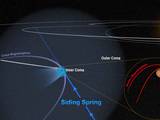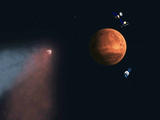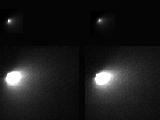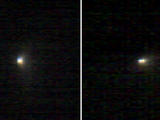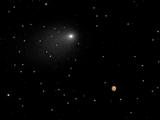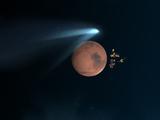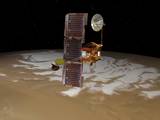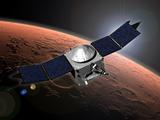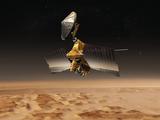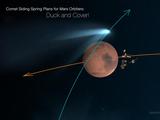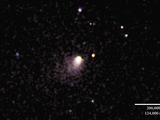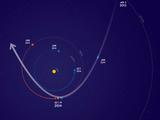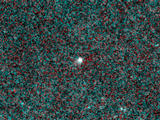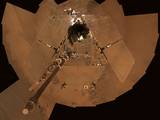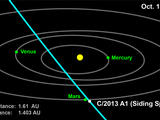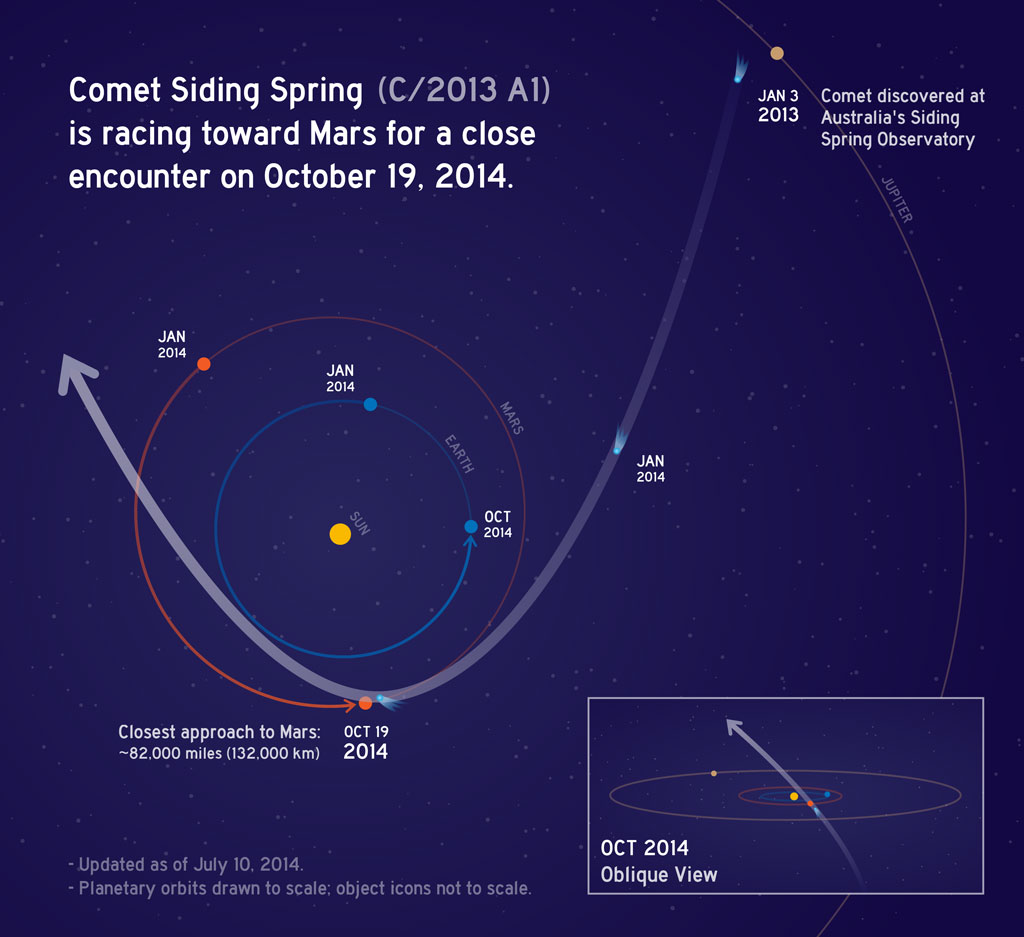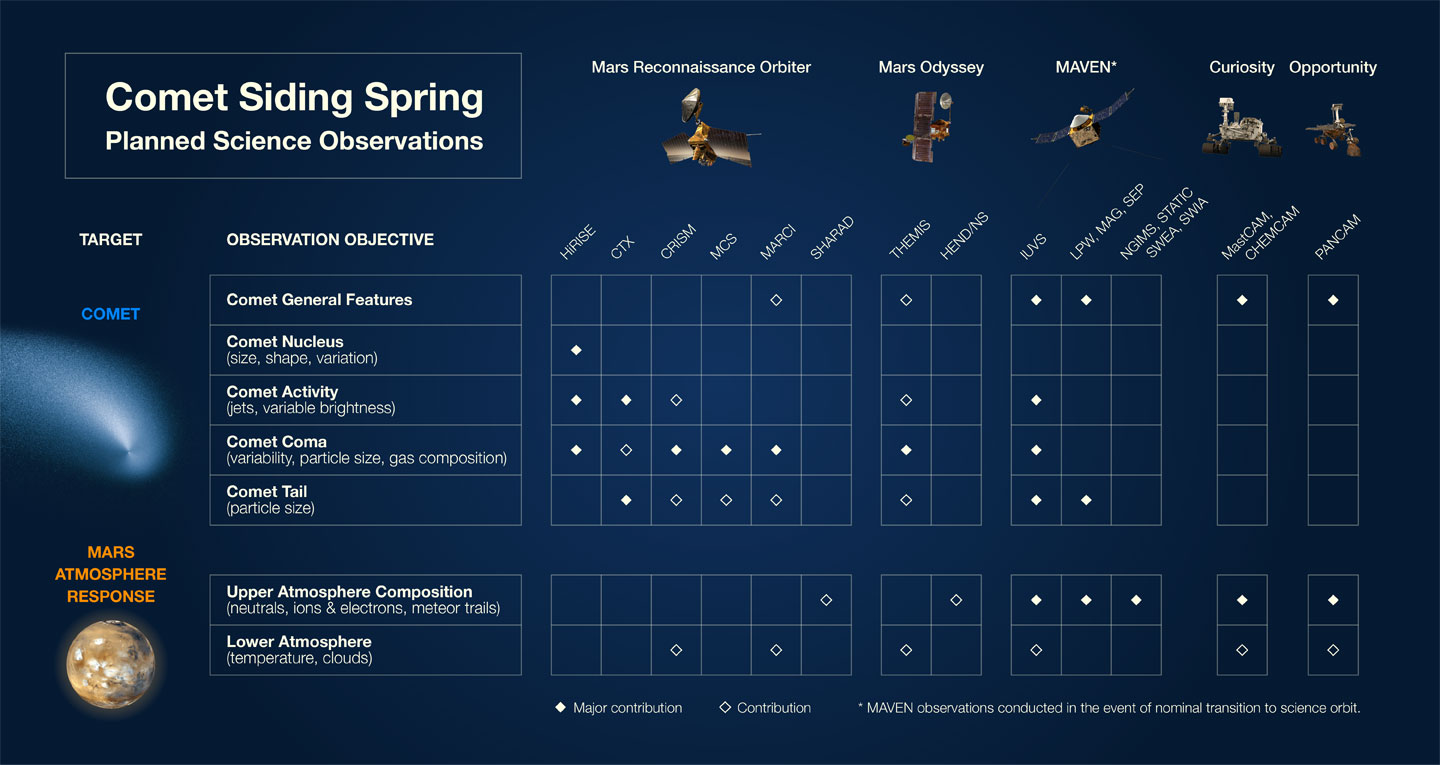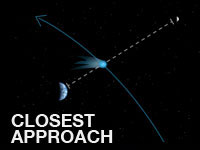Comets: Siding Spring (C/2013 A1)

Animation of Comet Siding Springs’ Close Encounter With Mars
Recent News
-
Close Comet Flyby Threw Mars' Magnetic Field Into Chaos
Just weeks before the historic encounter of comet C/2013 A1 (Siding Spring) with Mars in October 2014, NASA's Mars Atmosphere and Volatile Evolution (MAVEN) spacecraft entered orbit around the Red Planet.
Feature
-
Mars Spacecraft Reveal Comet Flyby Effects on Martian Atmosphere
Two NASA and one European spacecraft that obtained the first up-close observations of a comet flyby of Mars on Oct. 19, have gathered new information about the basic properties of the comet's nucleus and directly detected the effects on the Martian atmosphere.
Press Release
-
NASA to Discuss Science Findings of Oct. 19 Comet Flyby of Mars
A NASA media telecon on Friday, Nov. 7, will provide initial science observations of comet C/2013 A1 Siding Spring's close flyby of Mars and the impact on the Martian atmosphere.
Feature
-
Mars Orbiter's Spectrometer Shows Oort Comet's Coma
The imaging spectrometer on NASA's Mars Reconnaissance Orbiter has provided an image of the coma surrounding a comet that flew near Mars this week.
Feature
-
Close Encounters: Comet Siding Spring Seen Next to Mars
NASA's Hubble Space Telescope has produced a unique composite image of comet Siding Spring as it made its never-before-seen close passage of a comet by Mars.
Press Release
| Latest News | ||
Just weeks before the historic encounter of comet C/2013 A1 (Siding Spring) with Mars in October 2014, NASA's Mars Atmosphere and Volatile Evolution (MAVEN) spacecraft entered orbit around the Red Planet.
Read More ›› |
||
Two NASA and one European spacecraft that obtained the first up-close observations of a comet flyby of Mars on Oct. 19, have gathered new information about the basic properties of the comet's nucleus and directly detected the effects on the Martian atmosp
Read More ›› |
||
A NASA media telecon on Friday, Nov. 7, will provide initial science observations of comet C/2013 A1 Siding Spring's close flyby of Mars and the impact on the Martian atmosphere.
Read More ›› |
||
The imaging spectrometer on NASA's Mars Reconnaissance Orbiter has provided an image of the coma surrounding a comet that flew near Mars this week.
Read More ›› |
||
NASA's Hubble Space Telescope has produced a unique composite image of comet Siding Spring as it made its never-before-seen close passage of a comet by Mars.
Read More ›› |
||
A camera on NASA's Mars Reconnaissance Orbiter has taken the highest-resolution image ever made of an Oort Cloud comet, taking advantage of the comet's Mars flyby.
Read More ›› |
||
NASA's Mars Exploration Rover Opportunity caught an image of a celestial visitor -- comet C/2013 A1 Siding Spring -- as the comet approached near to Mars on Oct. 19, 2014.
Read More ›› |
||
All three NASA orbiters around Mars confirmed their healthy status Sunday after each took shelter behind Mars during a period of risk from dust released by a passing comet.
Read More ›› |
||
The longest-lived robot ever sent to Mars came through its latest challenge in good health, reporting home on schedule after sheltering behind Mars from possible comet dust.
Read More ›› |
||
NASA's newest orbiter at Mars, MAVEN, took precautions to avoid harm from a dust-spewing comet that flew near Mars today and is studying the flyby's effects on the Red Planet's atmosphere.
Read More ›› |
||
NASA's Mars Reconnaissance Orbiter, which has sent home more data about Mars than all other missions combined, is also now providing data about a comet that buzzed The Red Planet today (Oct. 19).
Read More ›› |
||
On October 19, a comet that has travelled many billions of miles will come within about 87,000 miles of Mars – about one-third of the distance of the Moon from Earth.
Read More ›› |
||
NASA's extensive fleet of science assets, particularly those orbiting and roving Mars, have front row seats to image and study a once-in-a-lifetime comet flyby on Sunday, Oct. 19.
Read More ›› |
||
NASA will host a briefing on Thursday, Oct. 9, to outline the space and Earth-based assets that will image and study a comet from relatively close range to Mars on Oct. 19.
Read More ›› |
||
NASA will hold a one-day NASA Social for up to 50 of its social media followers on Oct. 13, 2014, at the agency’s Jet Propulsion Laboratory in Pasadena, Calif.
Read More ›› |
||
Social media users are invited to apply for one of up to 50 credentials to attend a one-day NASA Social on Oct. 13, 2014, at the agency’s Jet Propulsion Laboratory in Pasadena, Calif.
Read More ›› |
||
NASA's Mars Odyssey spacecraft has successfully adjusted the timing of its orbit around Mars as a defensive precaution for a comet's close flyby of Mars on Oct. 19, 2014.
Read More ›› |
||
NASA is taking steps to protect its Mars orbiters, while preserving opportunities to gather valuable scientific data, as Comet C/2013 A1 Siding Spring heads toward a close flyby of Mars on Oct. 19.
Read More ›› |
||
In late May, NASA's Swift satellite imaged comet Siding Spring, which will brush astonishingly close to Mars later this year.
Read More ›› |
||
NASA released Thursday an image of a comet that, on Oct. 19, will pass within 84,000 miles of Mars -- less than half the distance between Earth and our moon.
Read More ›› |
||
A close flyby of Mars in 2014 by comet Siding Spring could deliver opportunities for learning, but also possible hazards for orbiting spacecraft. NASA is preparing for both.
Read More ›› |
||
A comet is heading for Mars, and there is a chance that it might hit the Red Planet in October 2014. An impact wouldn't necessarily mean the end of NASA's Mars program, but it would transform the program along with Mars itself.
Read More ›› |
||
Latest observations indicate comet 2013 A1 will pass within 186,000 miles (300,000 kilometers) of Mars on Oct. 19, 2014.
Read More ›› |
||
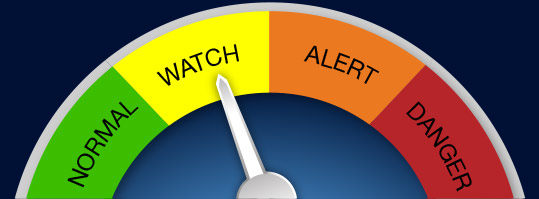
COMET WATCH:
Siding Spring Estimates
| Discovered by: Robert H. McNaught at Siding Spring Observatory in Australia |
Velocity of Dust Particles: ~ 125,000 mph (56 km/sec) |
| Date of Nucleus' Closest Approach: Oct. 19, 2014 at ~11:28 AM PT 2:28 PM ET 18:28 UT |
Dust Particles Produced by Comet (1/28/14): 220 pounds (100 kilograms) per second (~800,000 lbs per hour) |
| Nucleus Diameter: Unknown | Amount of Dust Particles: ~ 5 years worth of normal meteor activity |
| Coma: At 12,000 miles (19,300 km) across. | Chance of Mars Impact: Unlikely |
| Time for Mars to Pass Through Coma: Several hours |
Viewing from Earth: Southern Hemisphere, Sept 2014 with binoculars and telescopes. |
| Critical Data Products: Comet Siding Spring Environment Modeling |
|
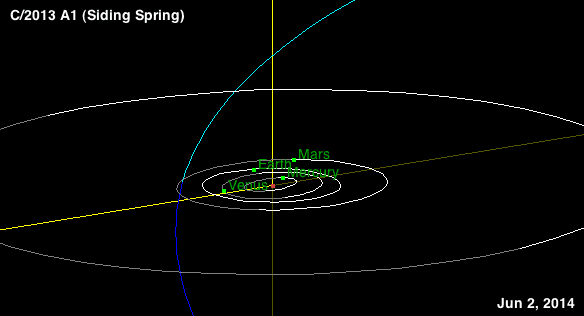 Brought to you by the Near-Earth Object (NEO) office at NASA's Jet Propulsion Laboratory. See simulation >>
Brought to you by the Near-Earth Object (NEO) office at NASA's Jet Propulsion Laboratory. See simulation >>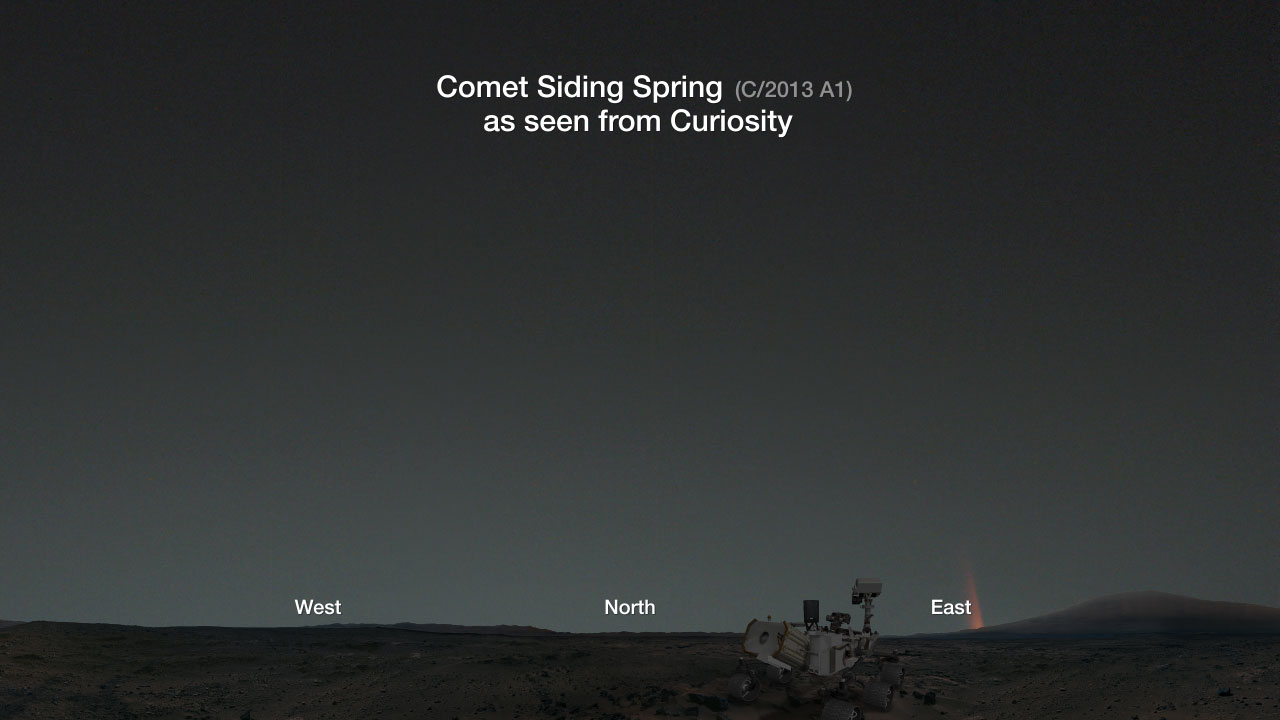
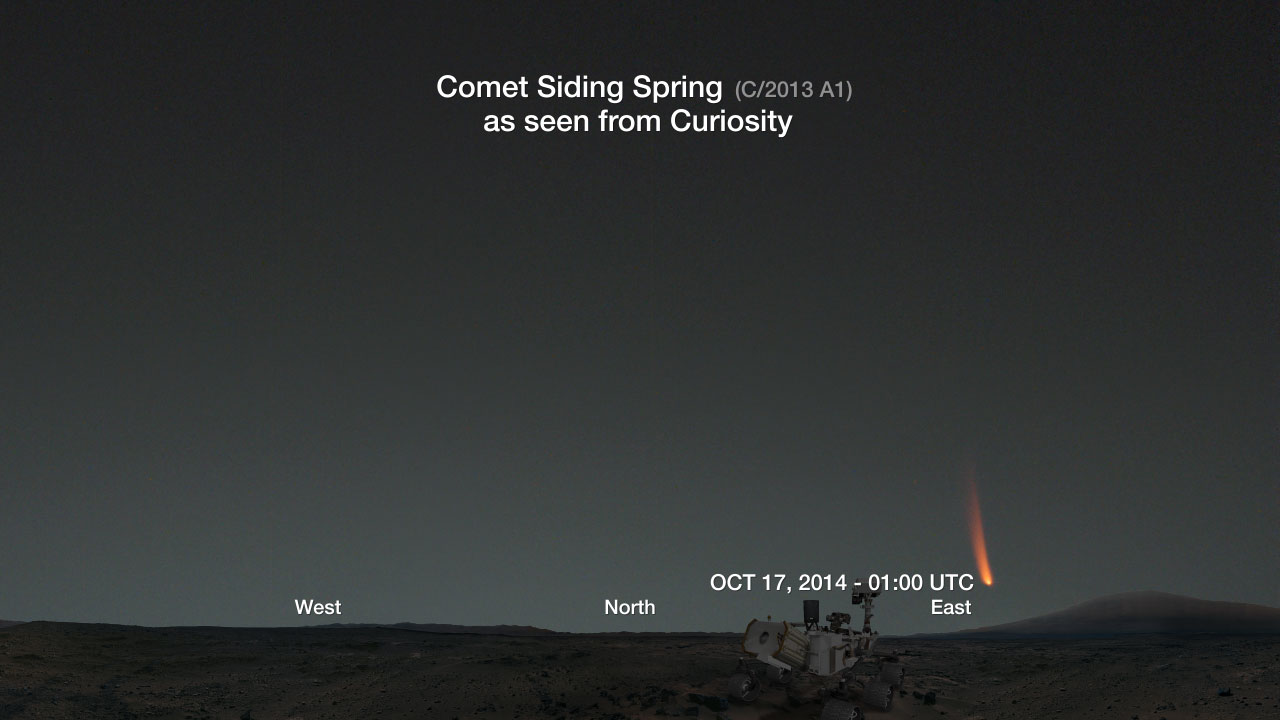
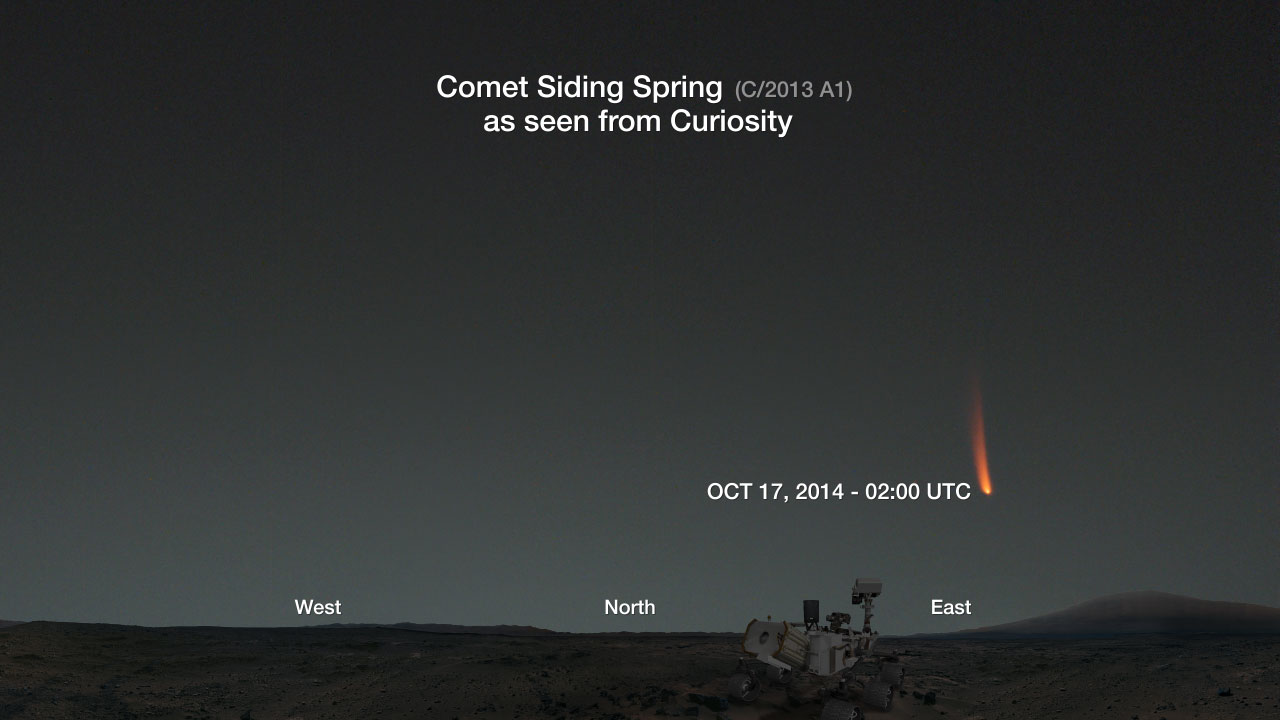
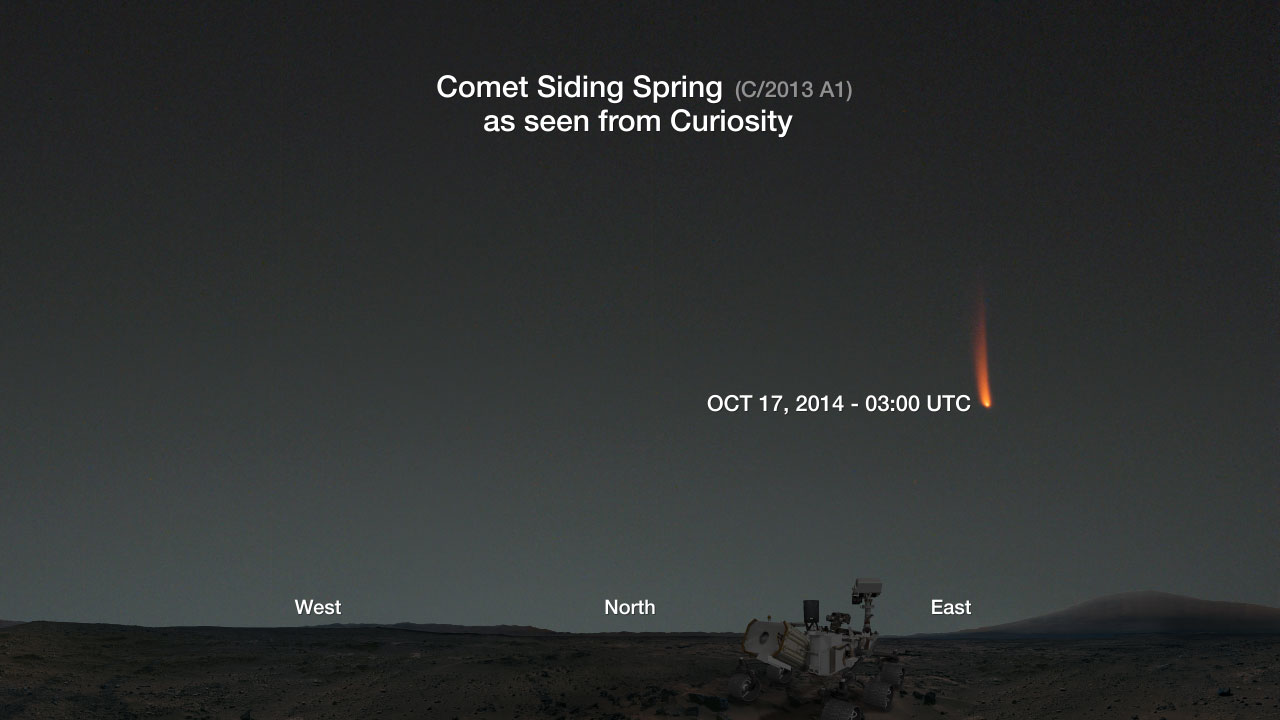
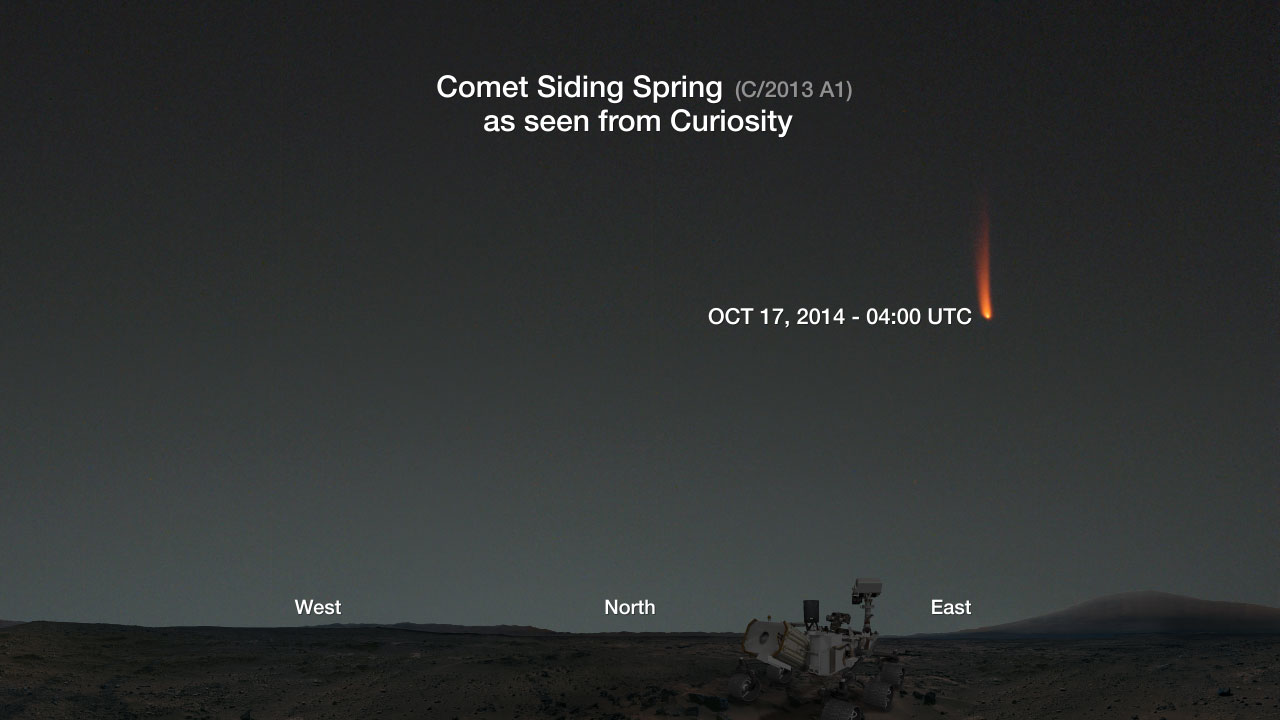
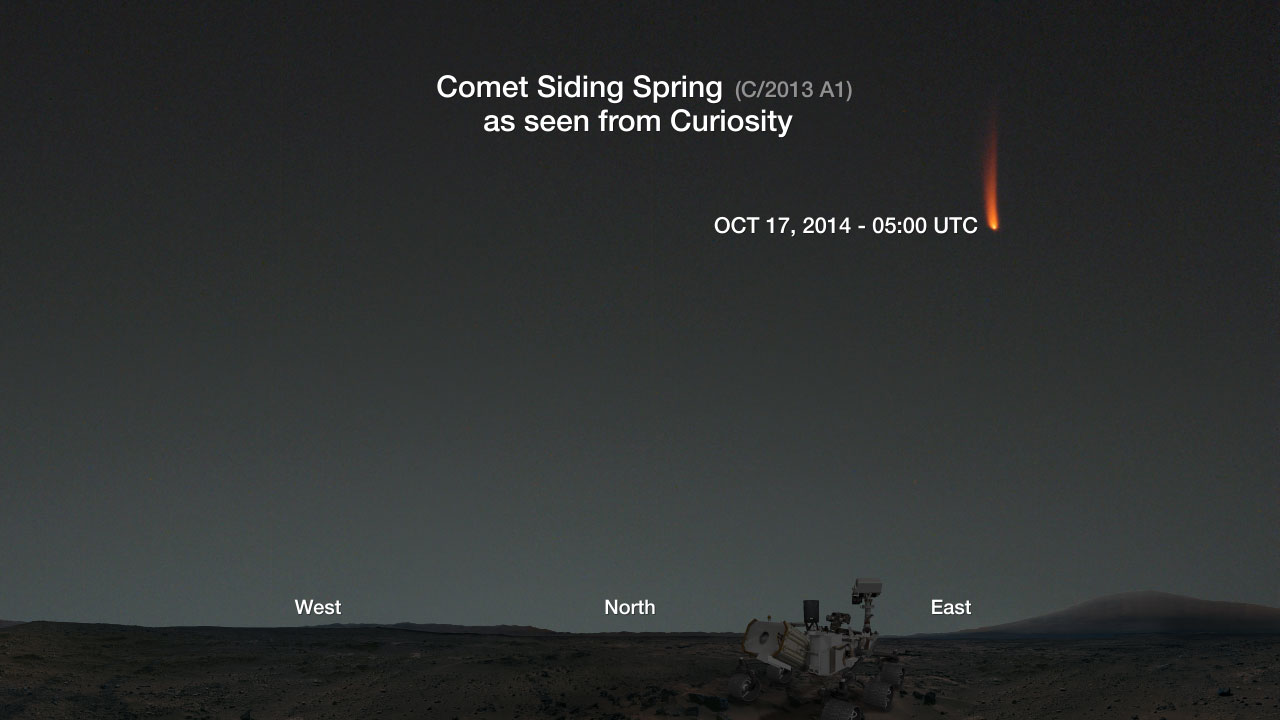
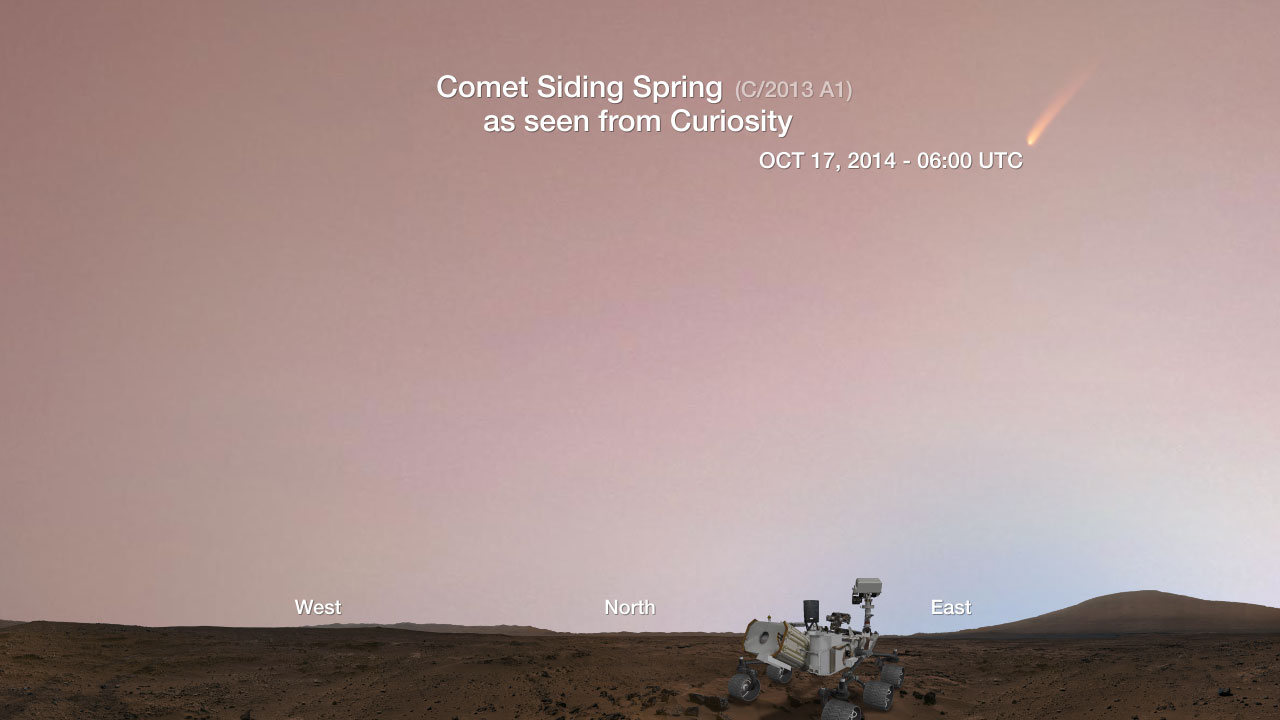
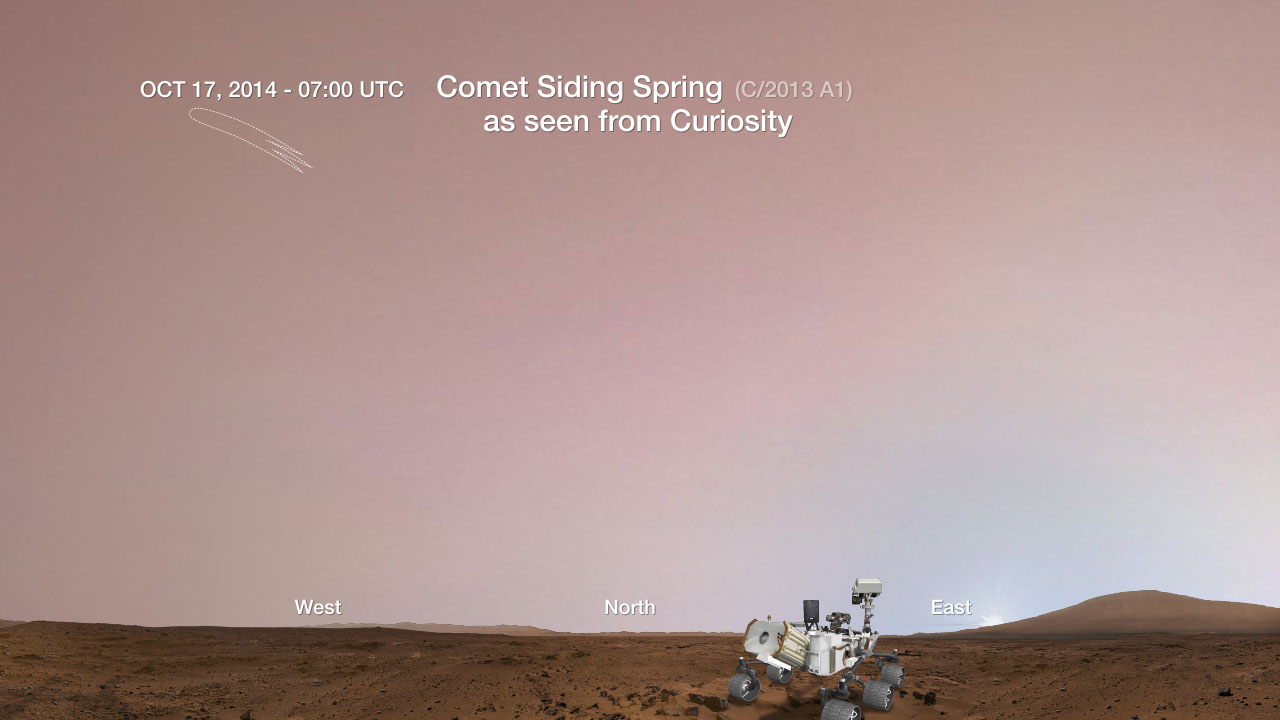
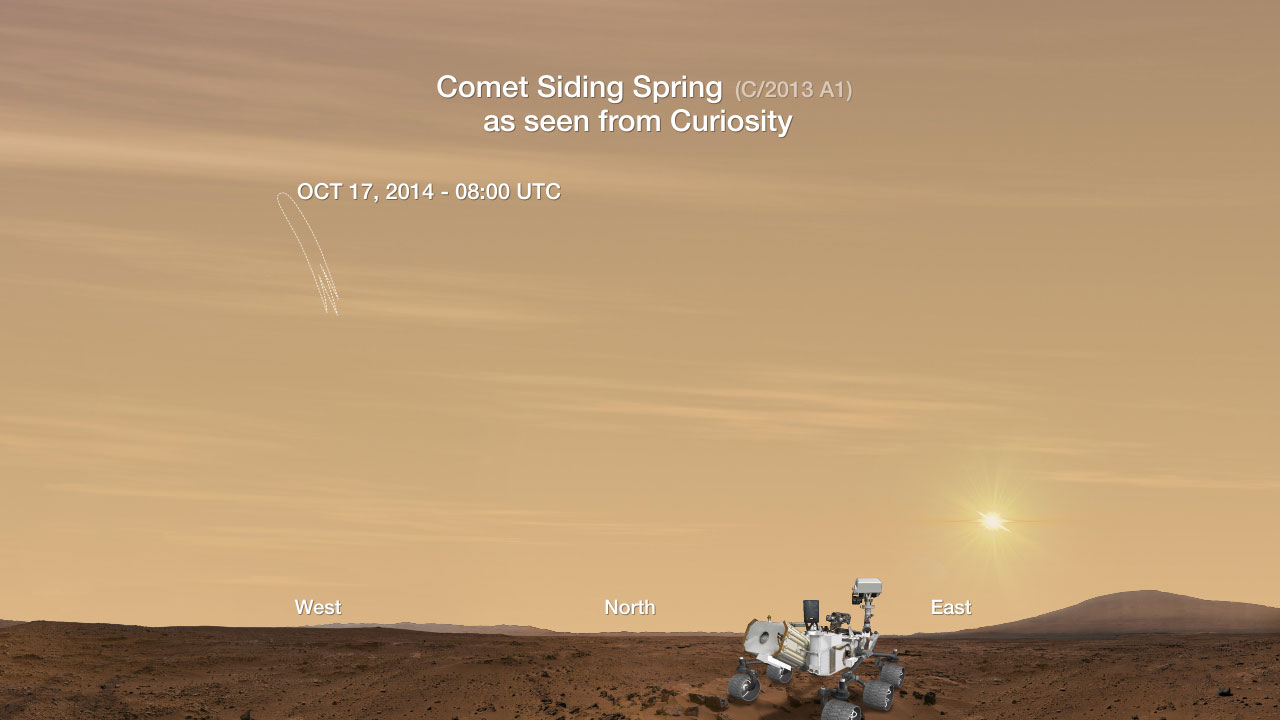
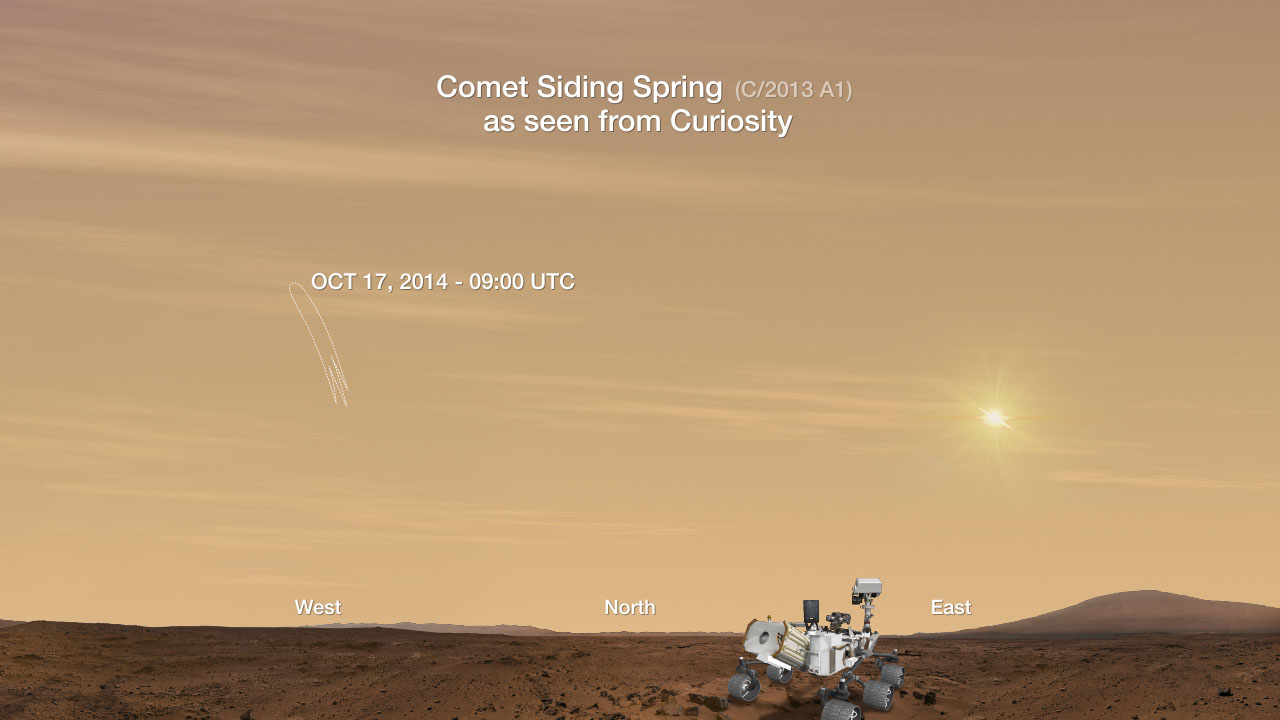
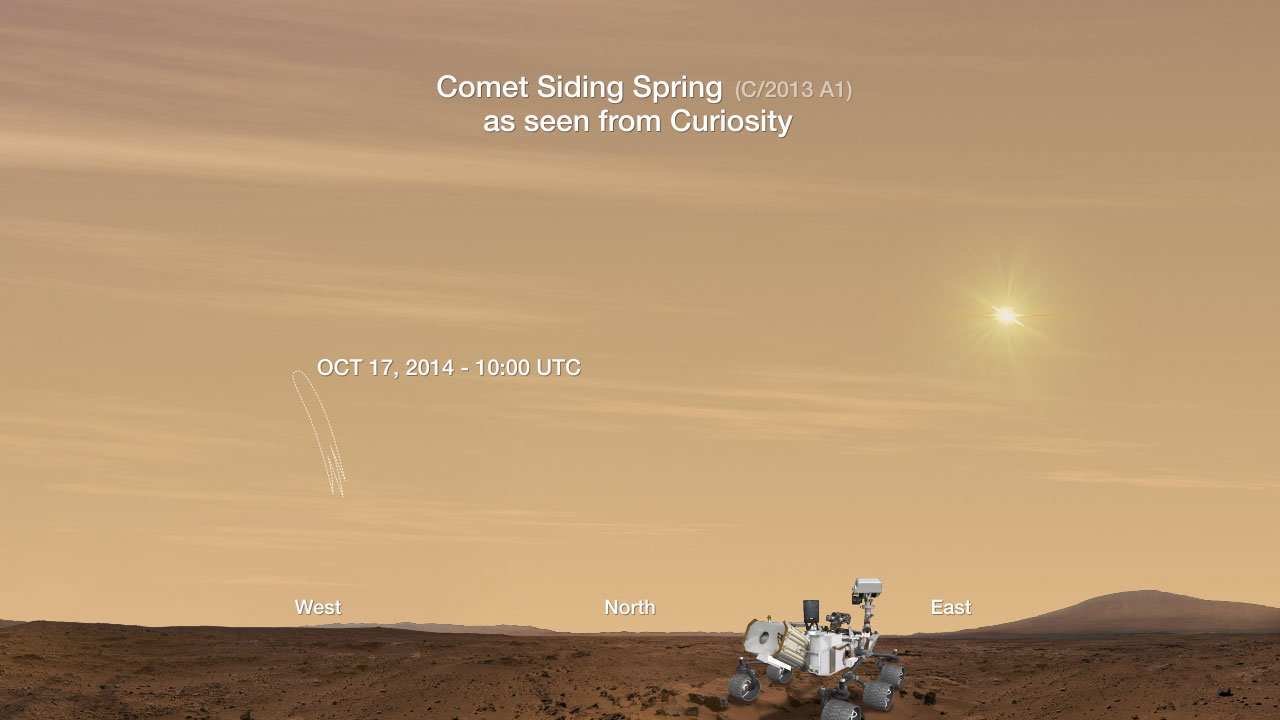
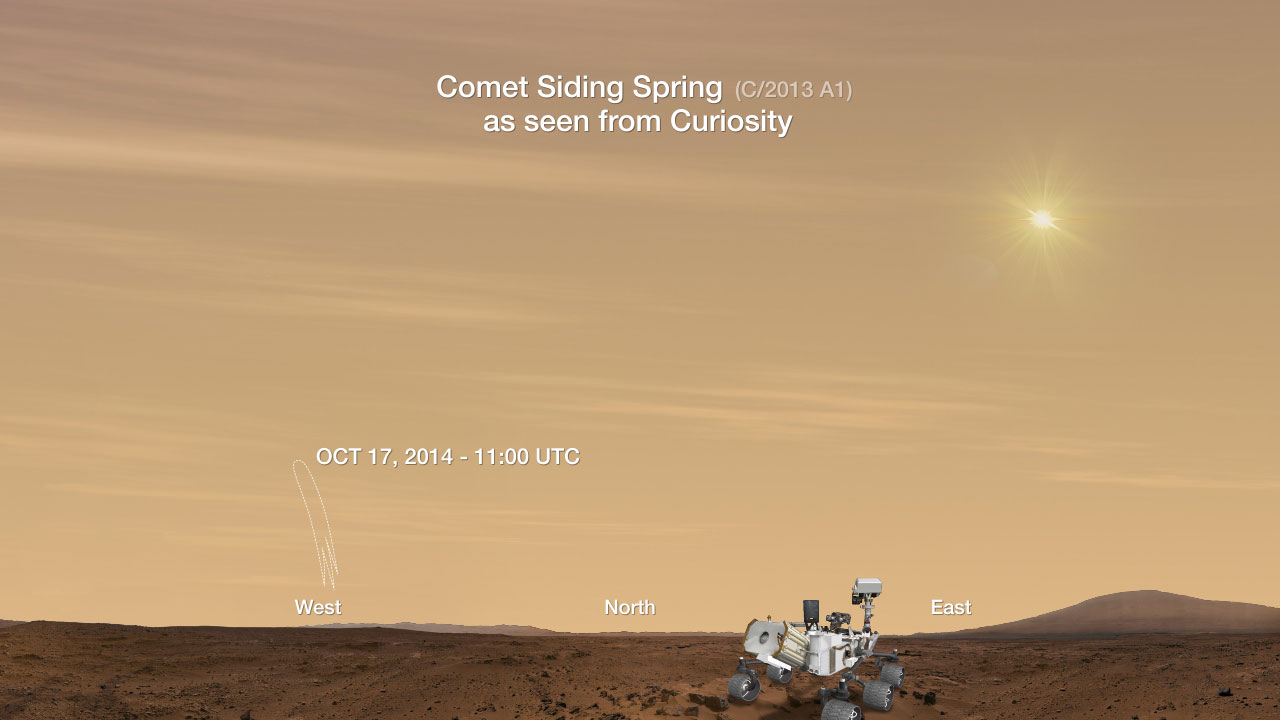

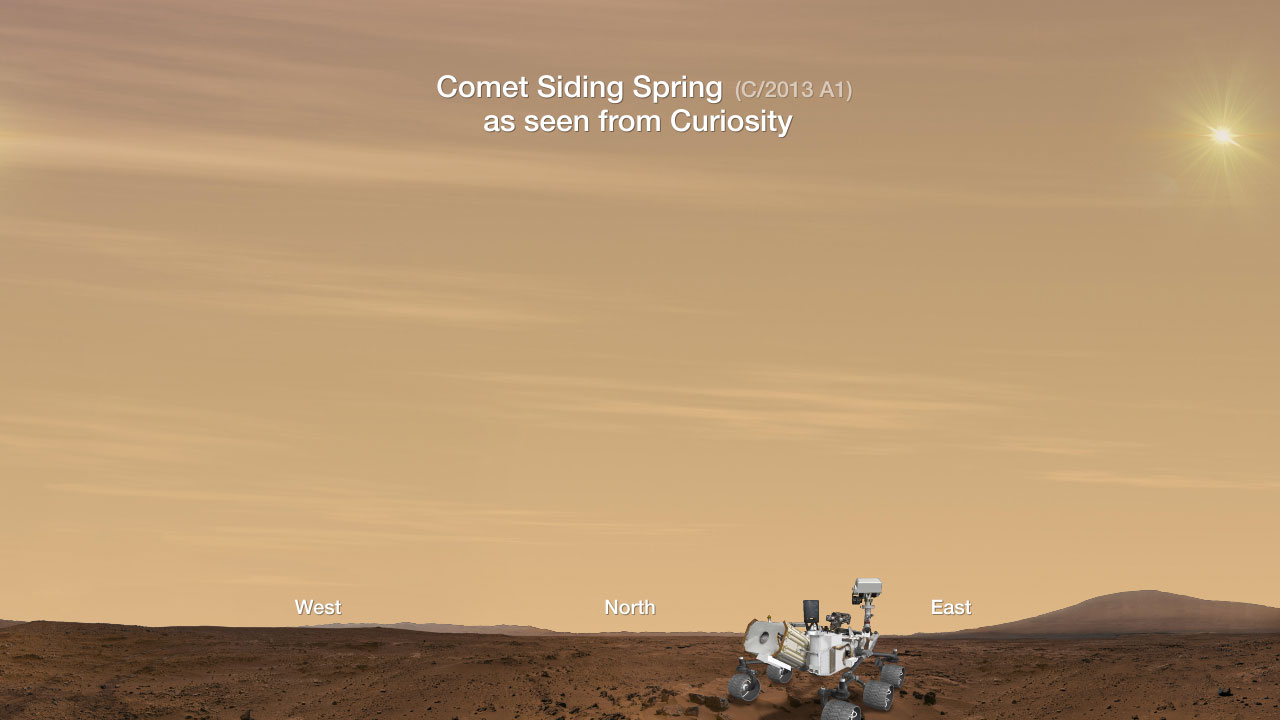
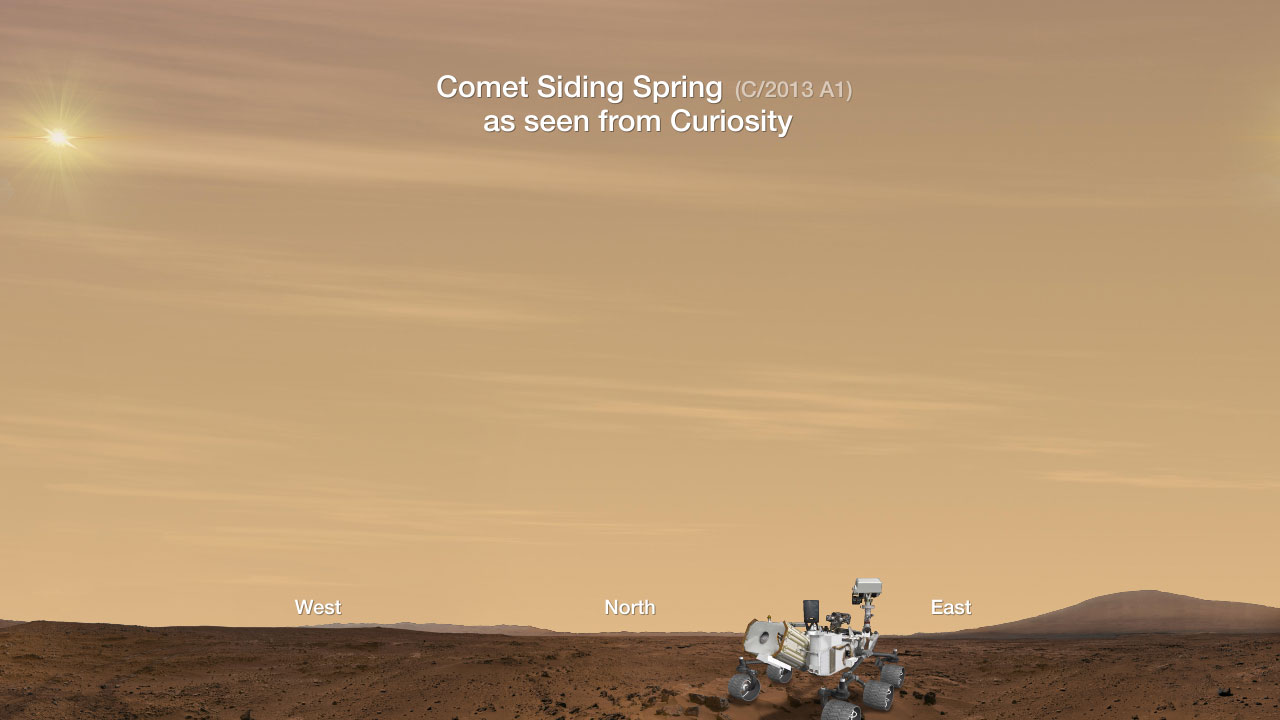
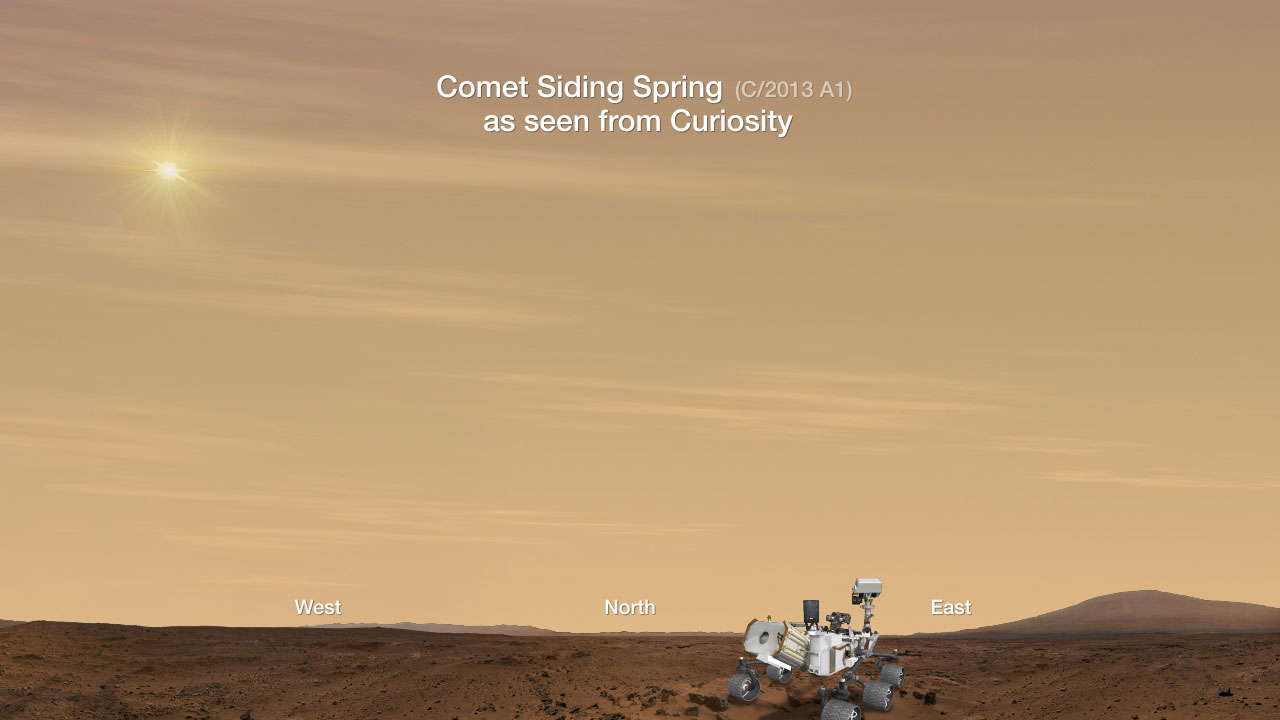
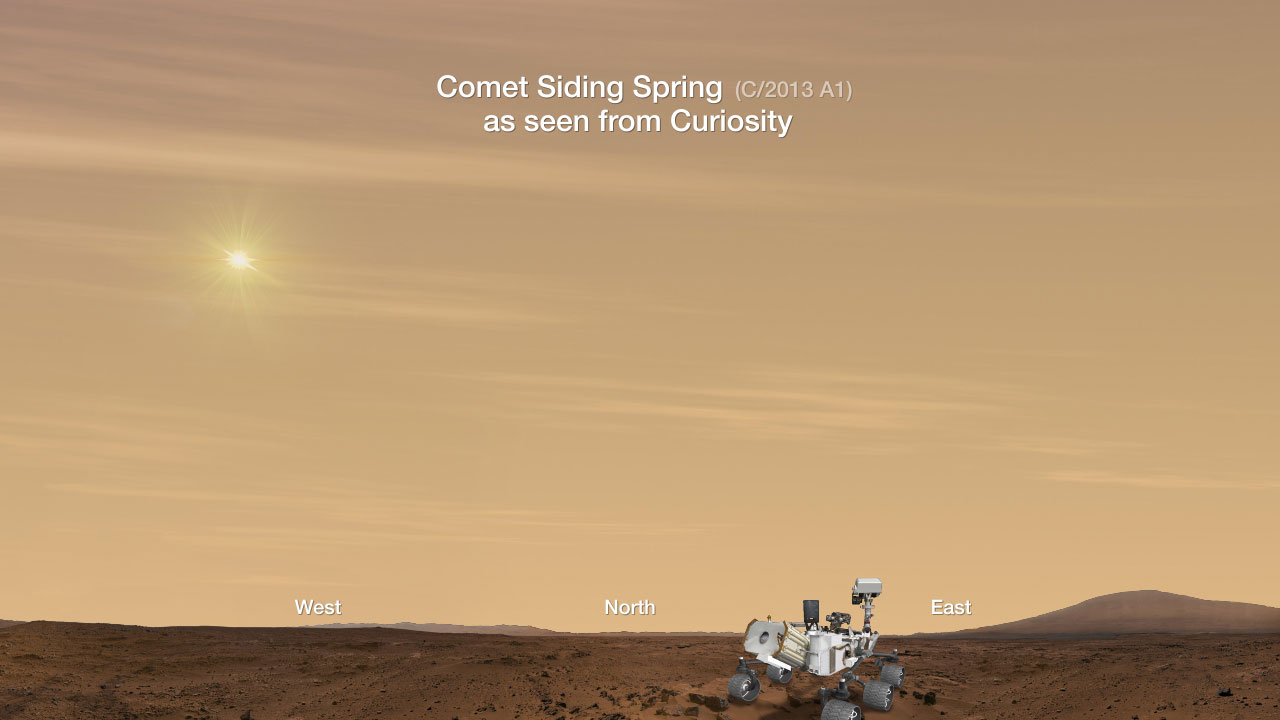
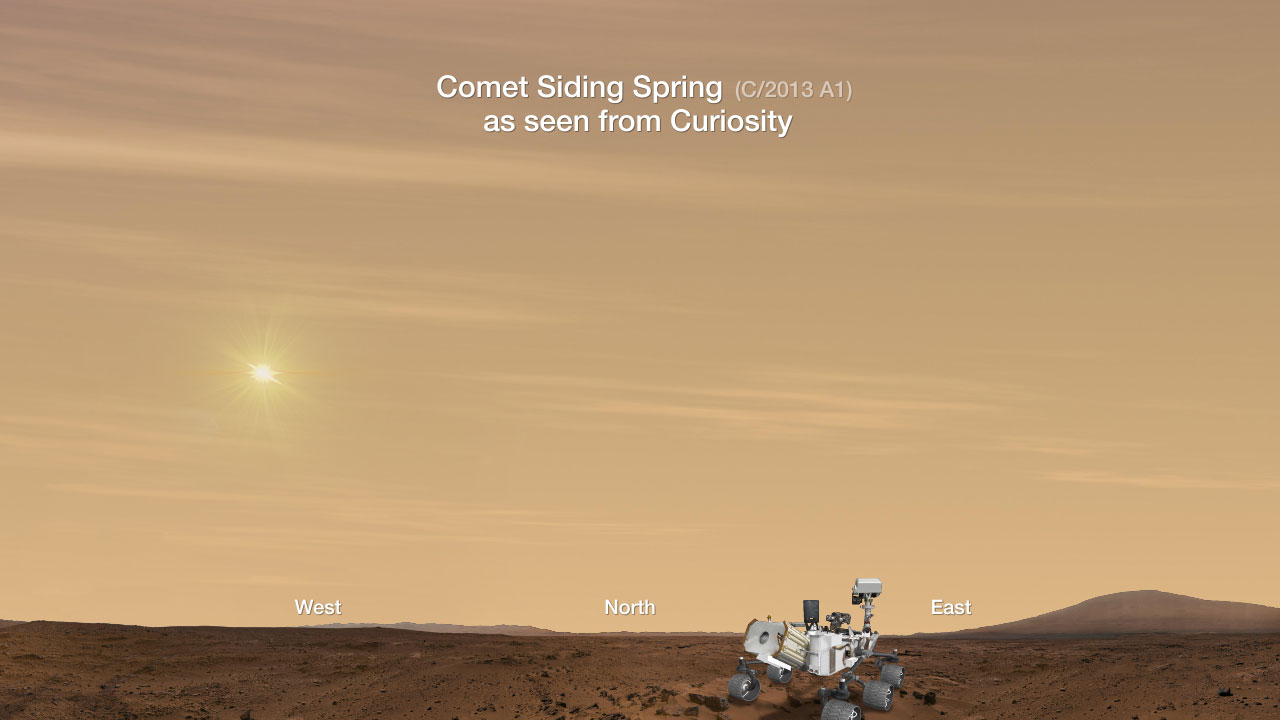
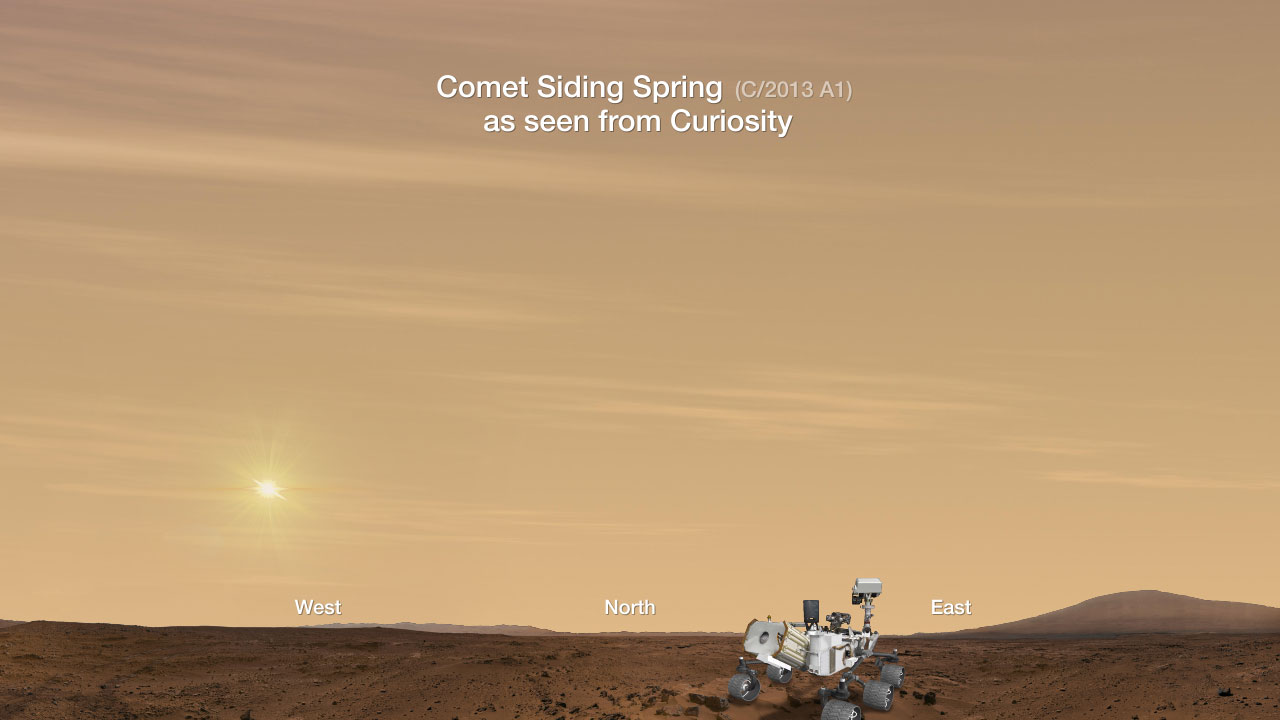
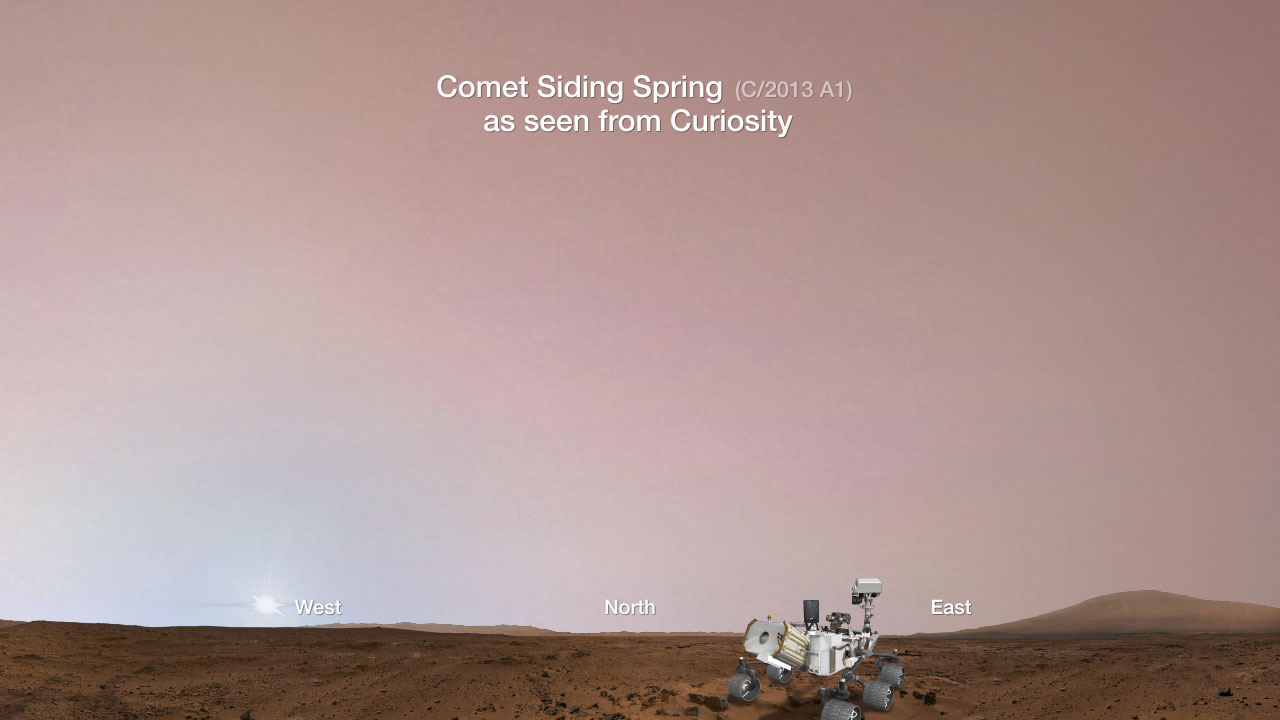
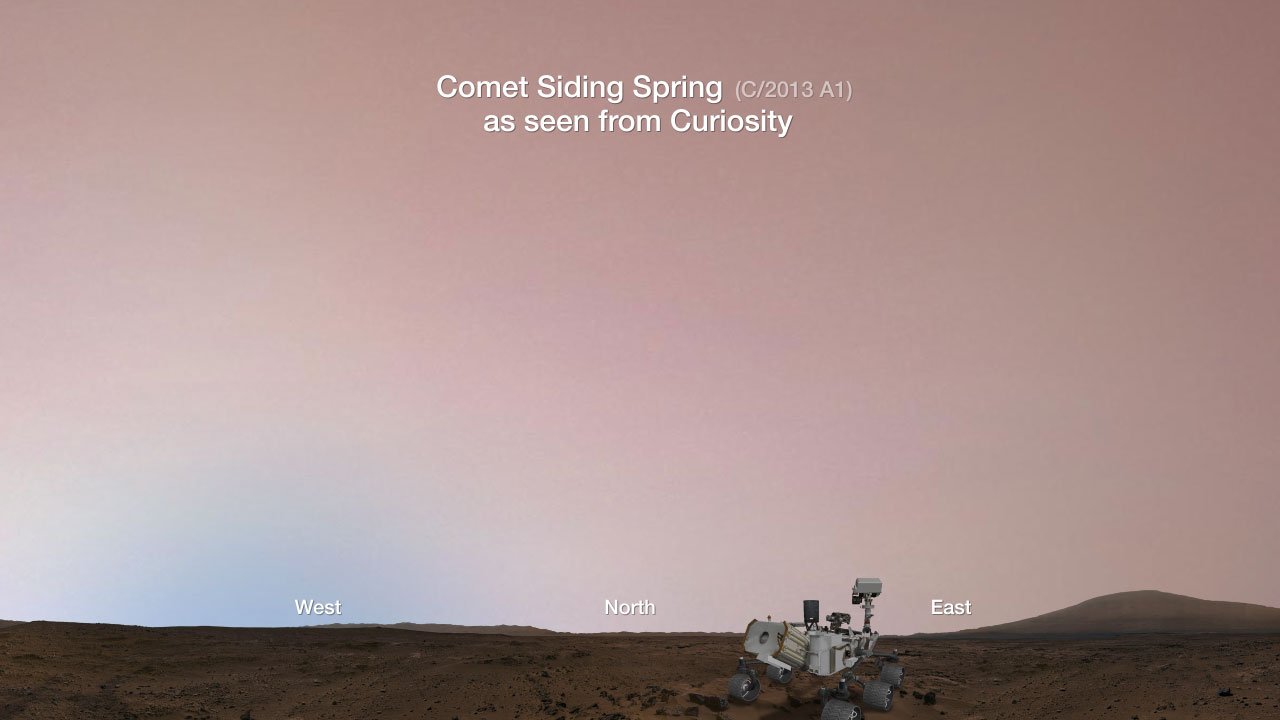
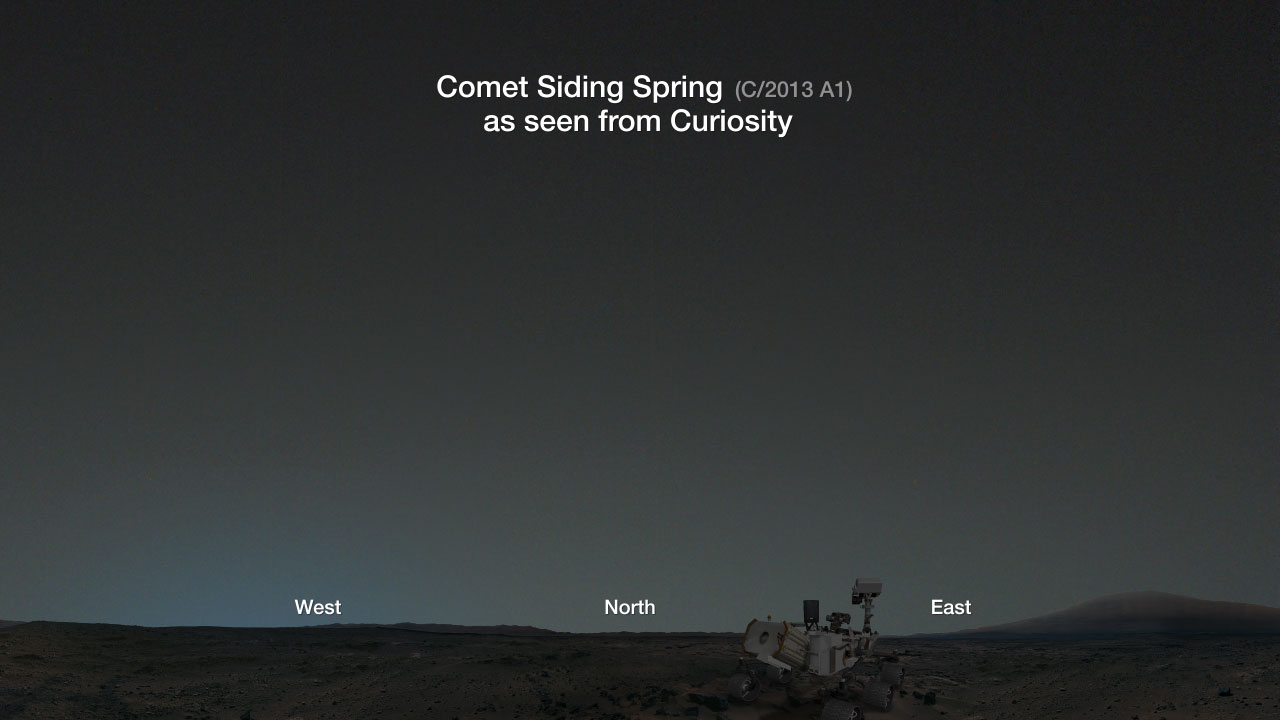
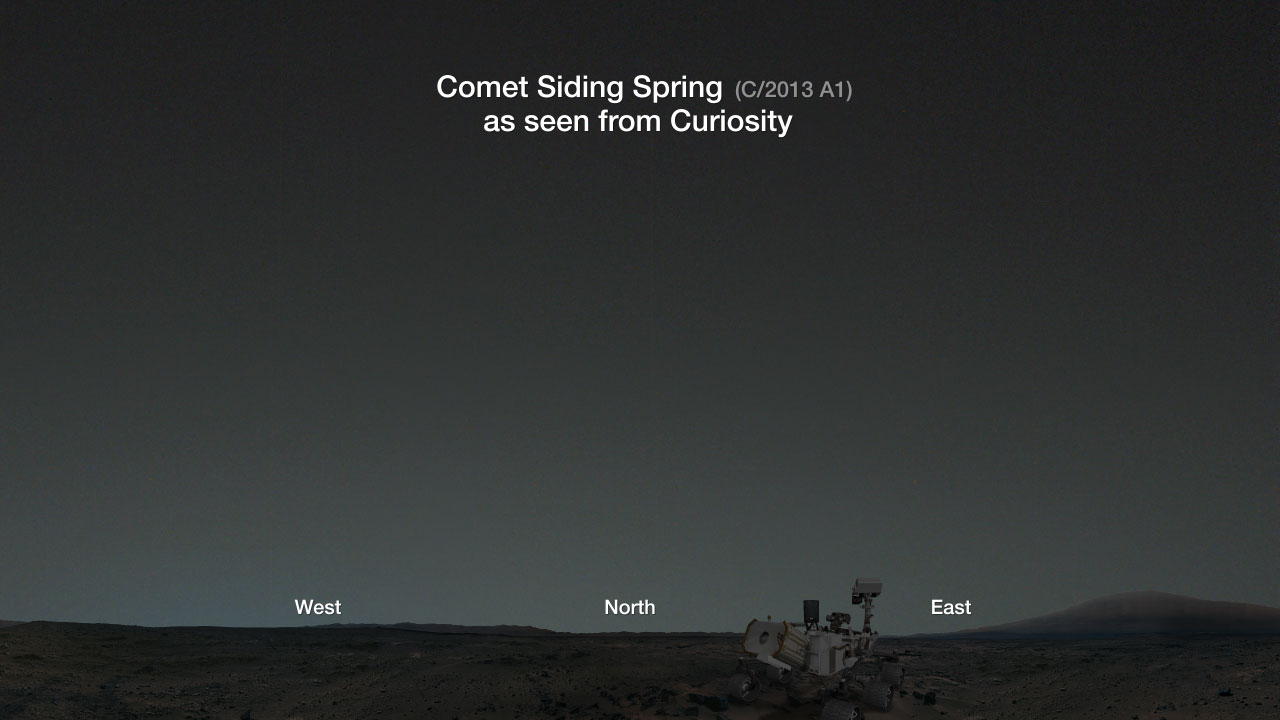
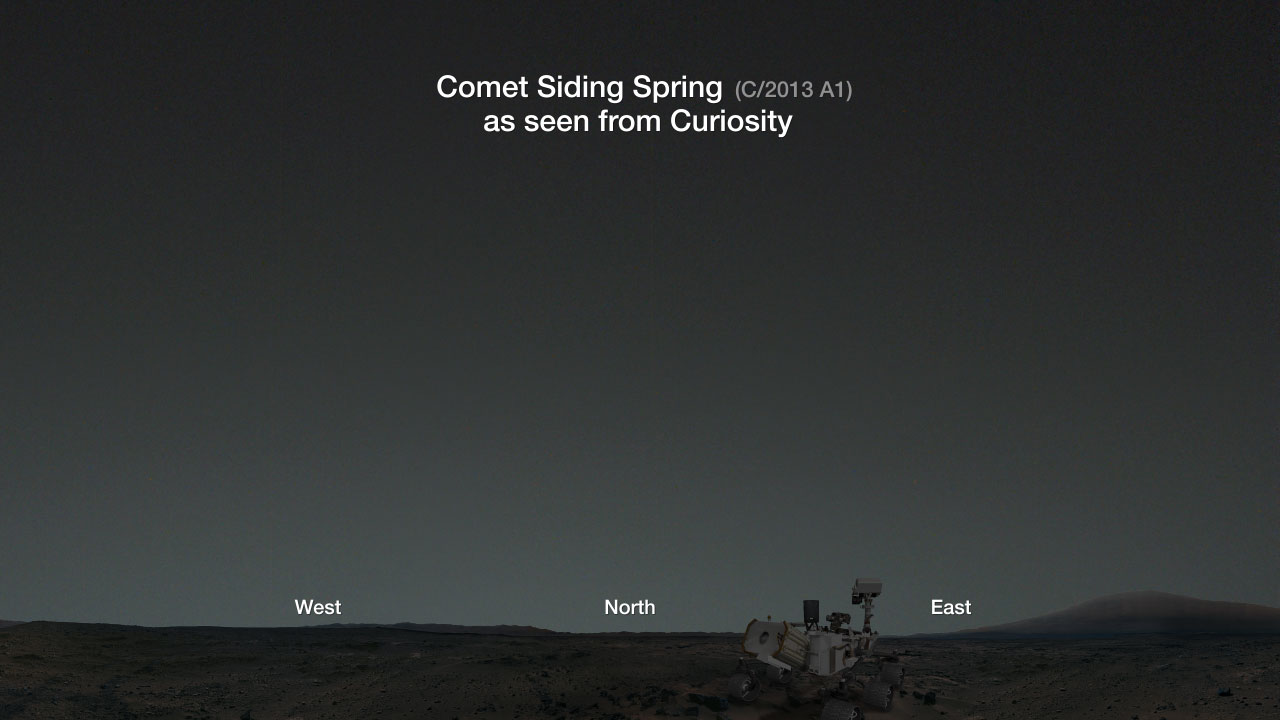
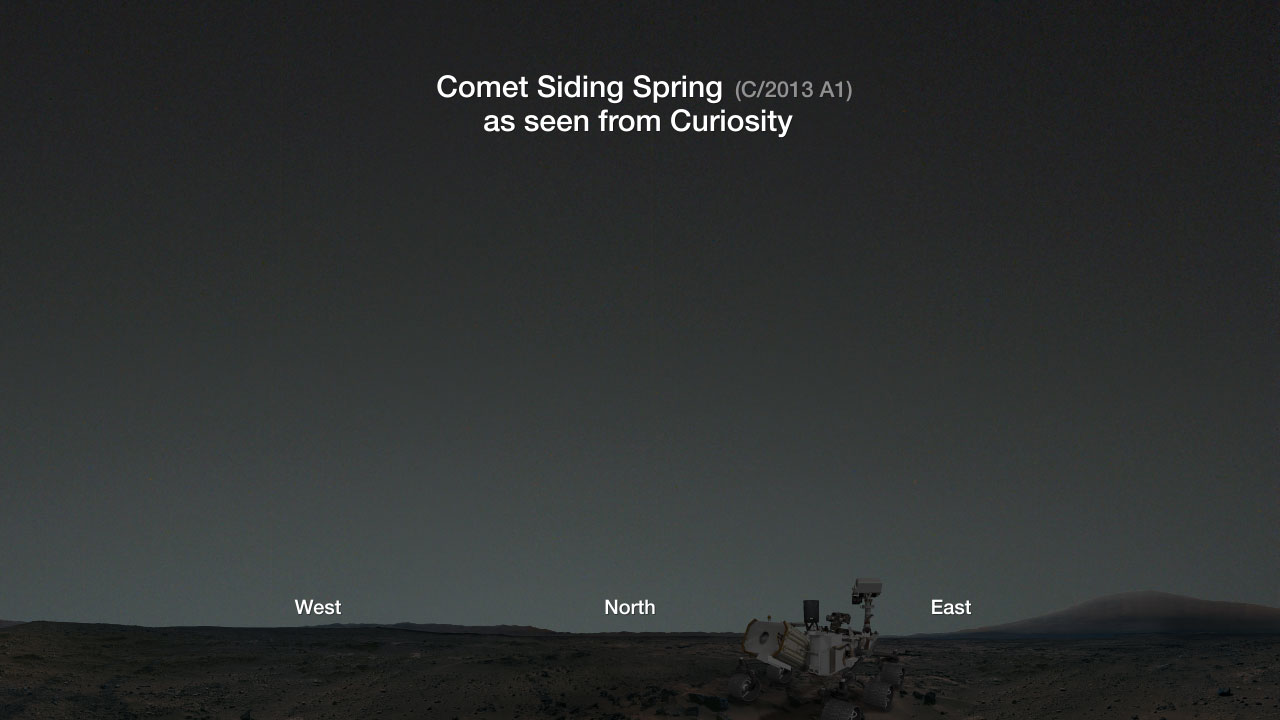
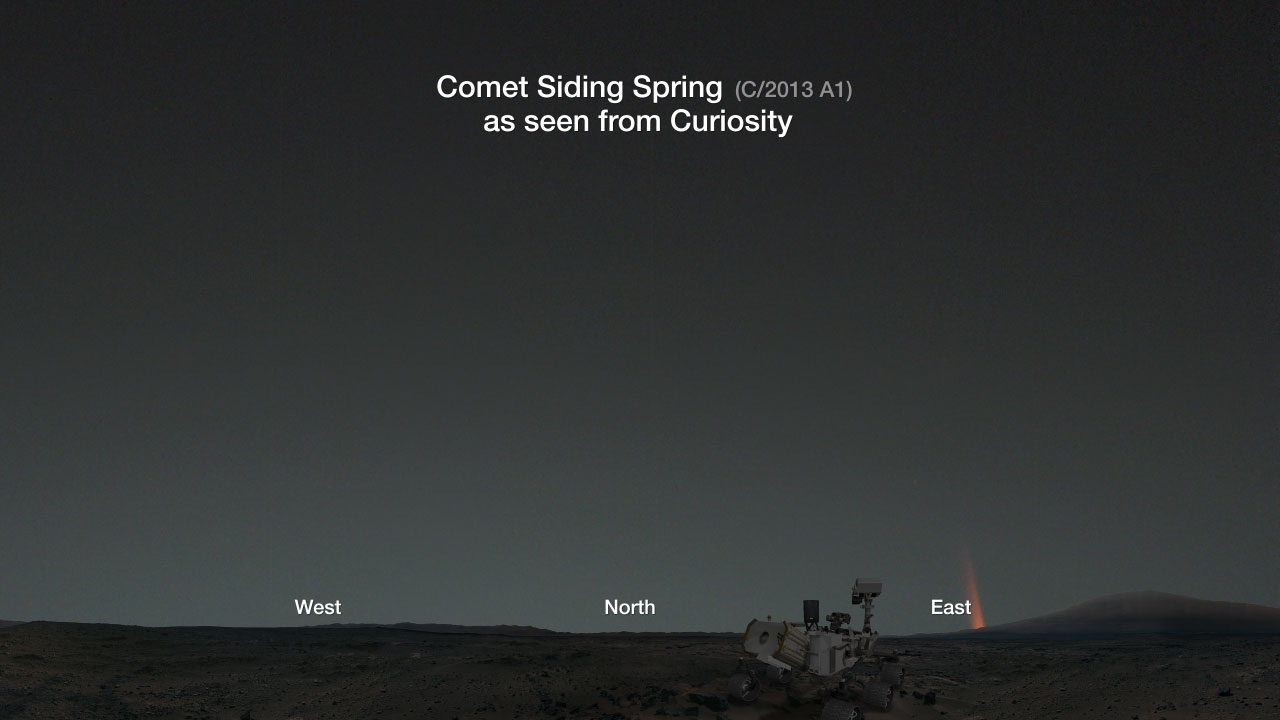
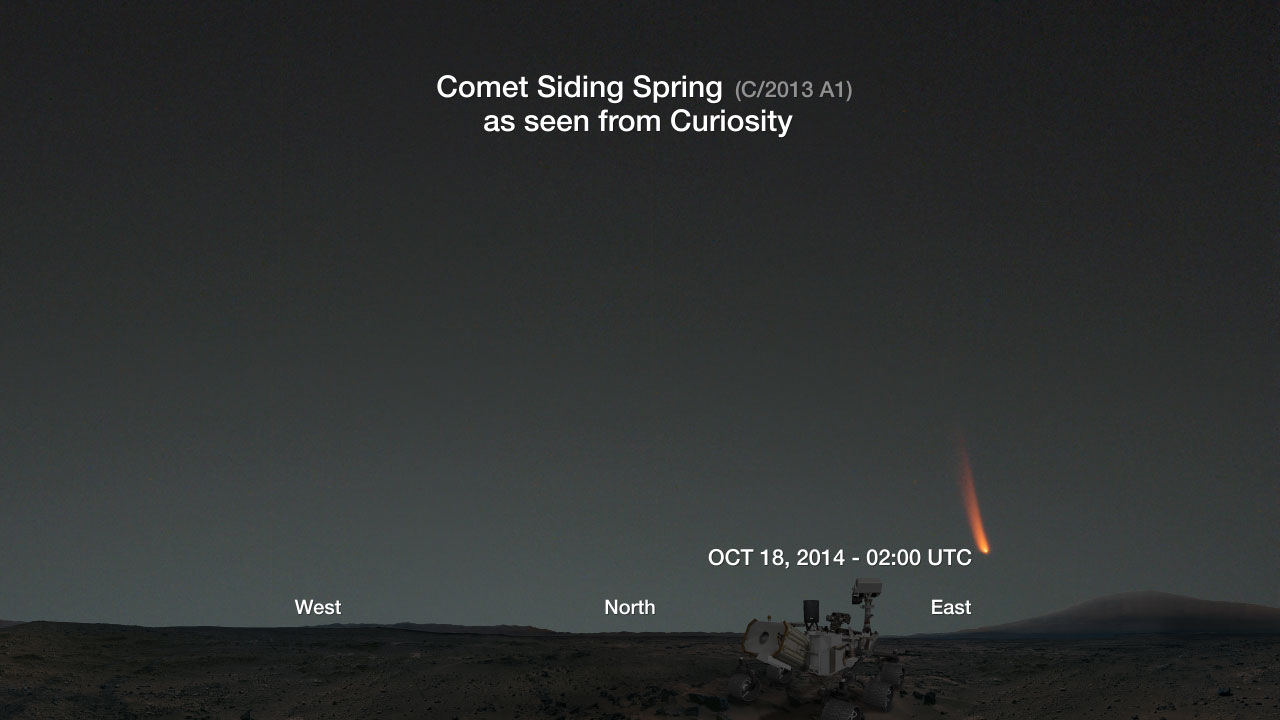
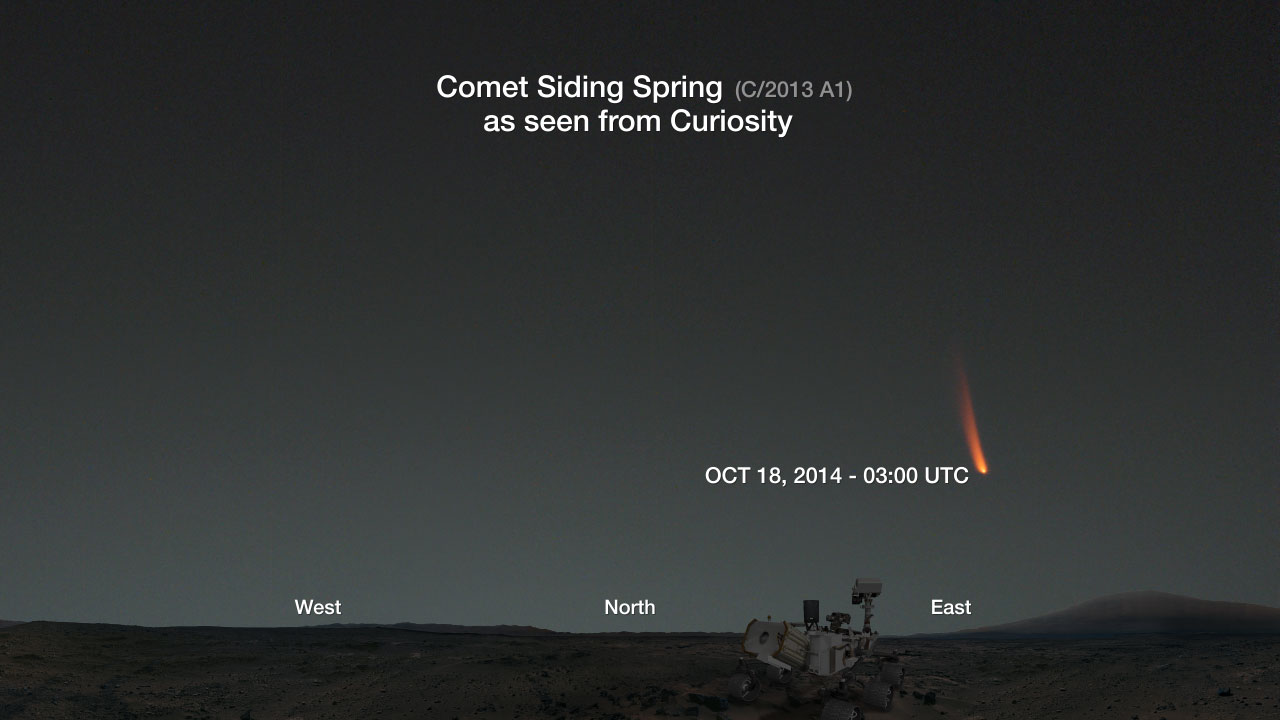
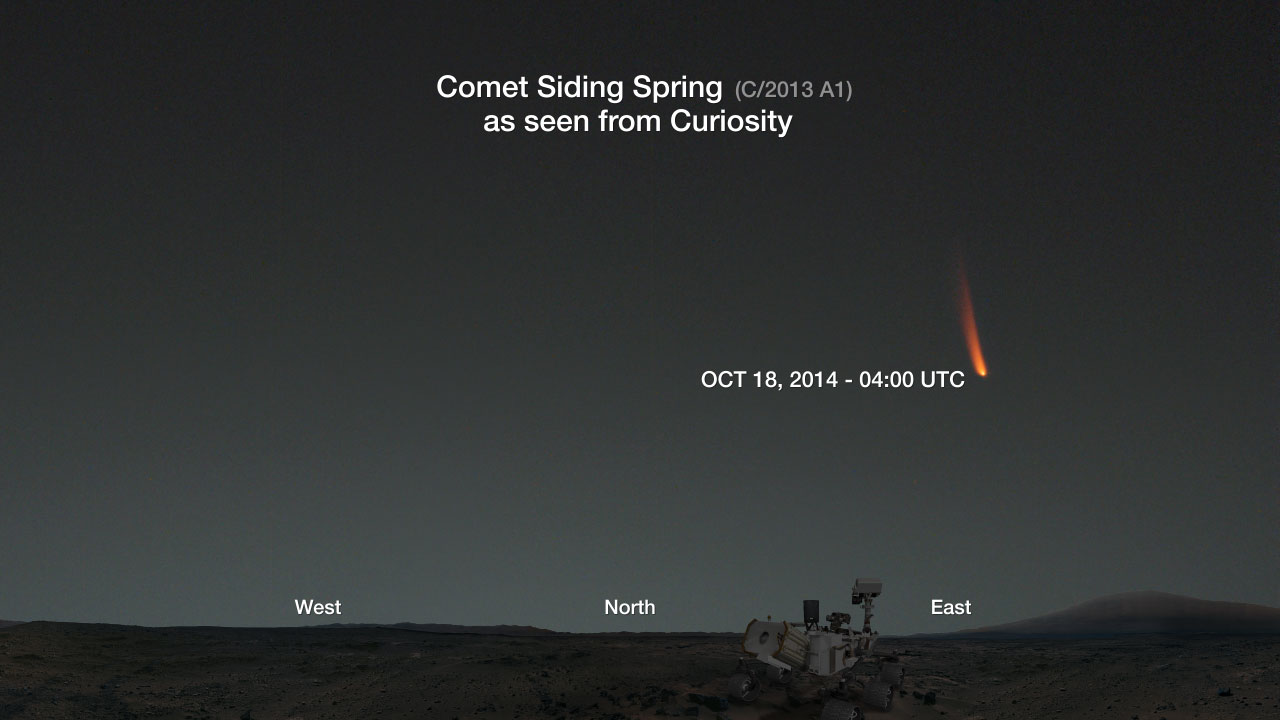
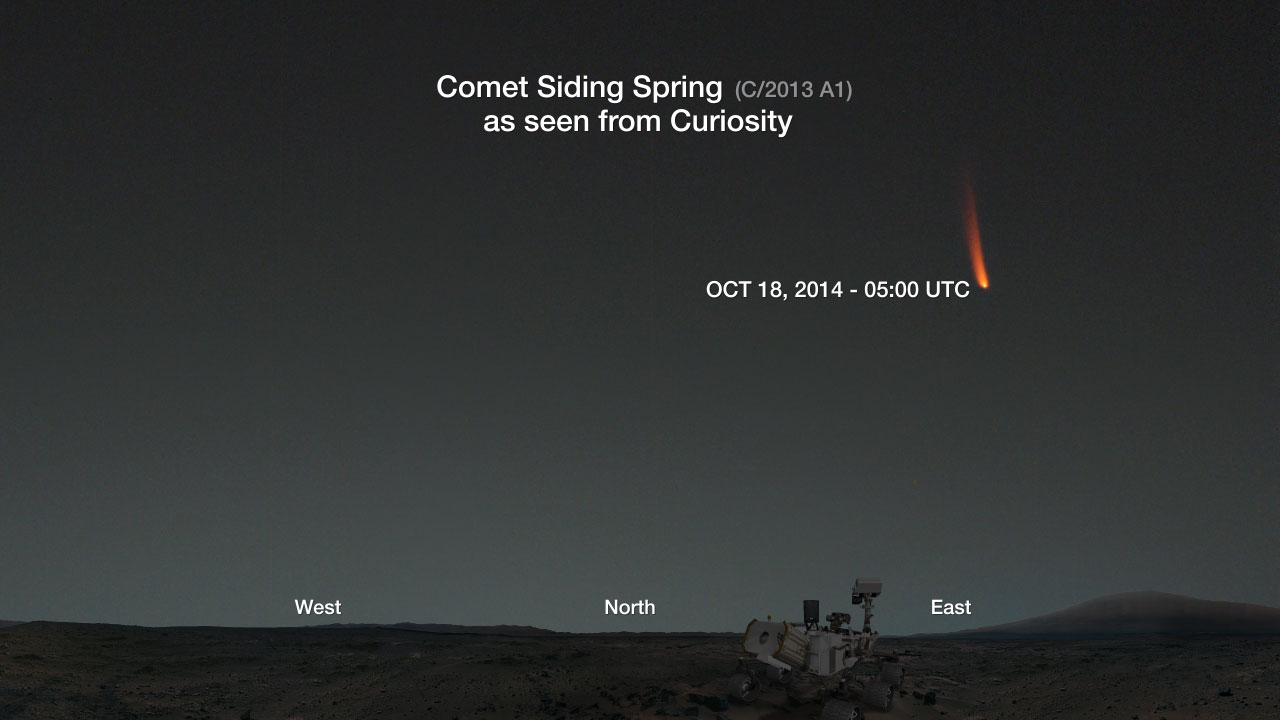
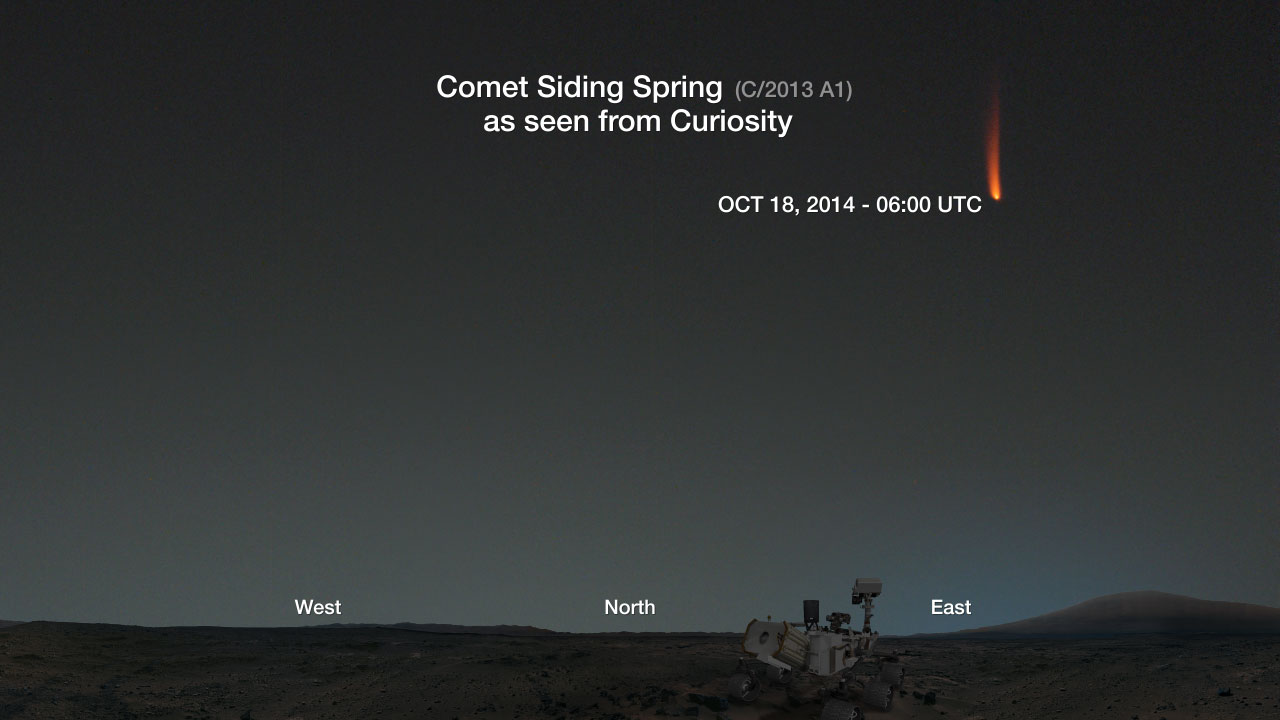
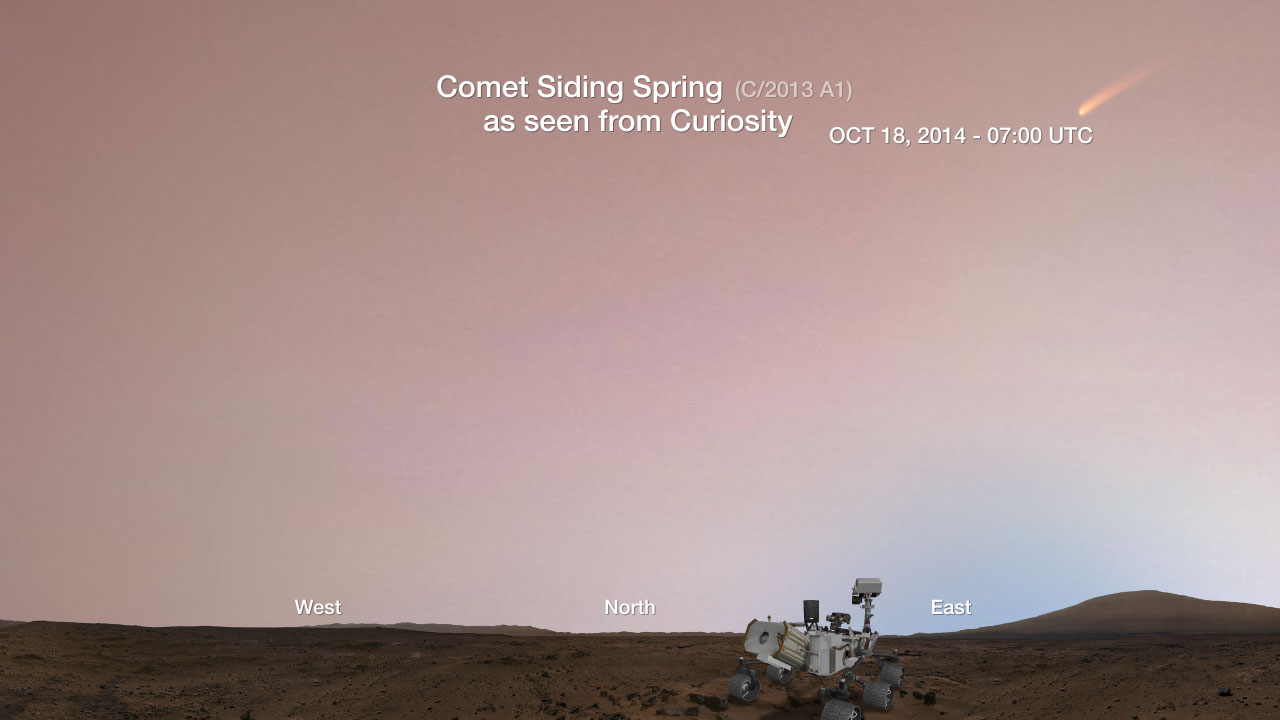
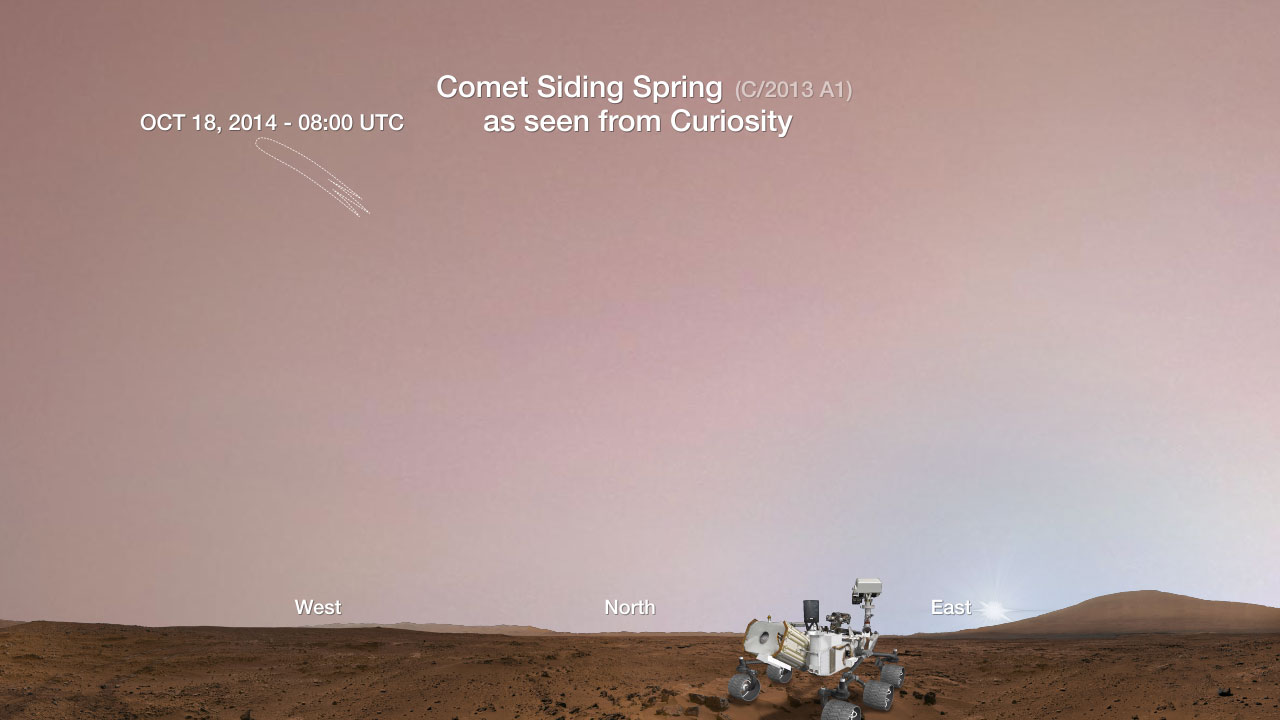

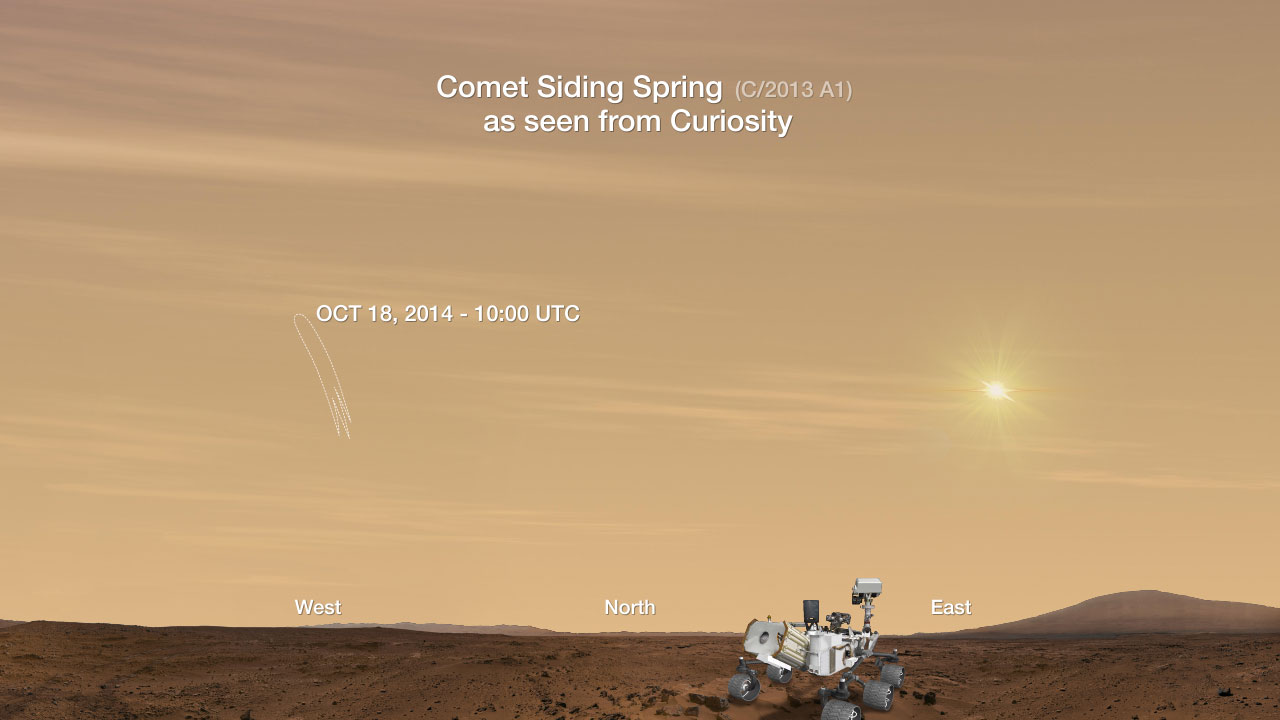
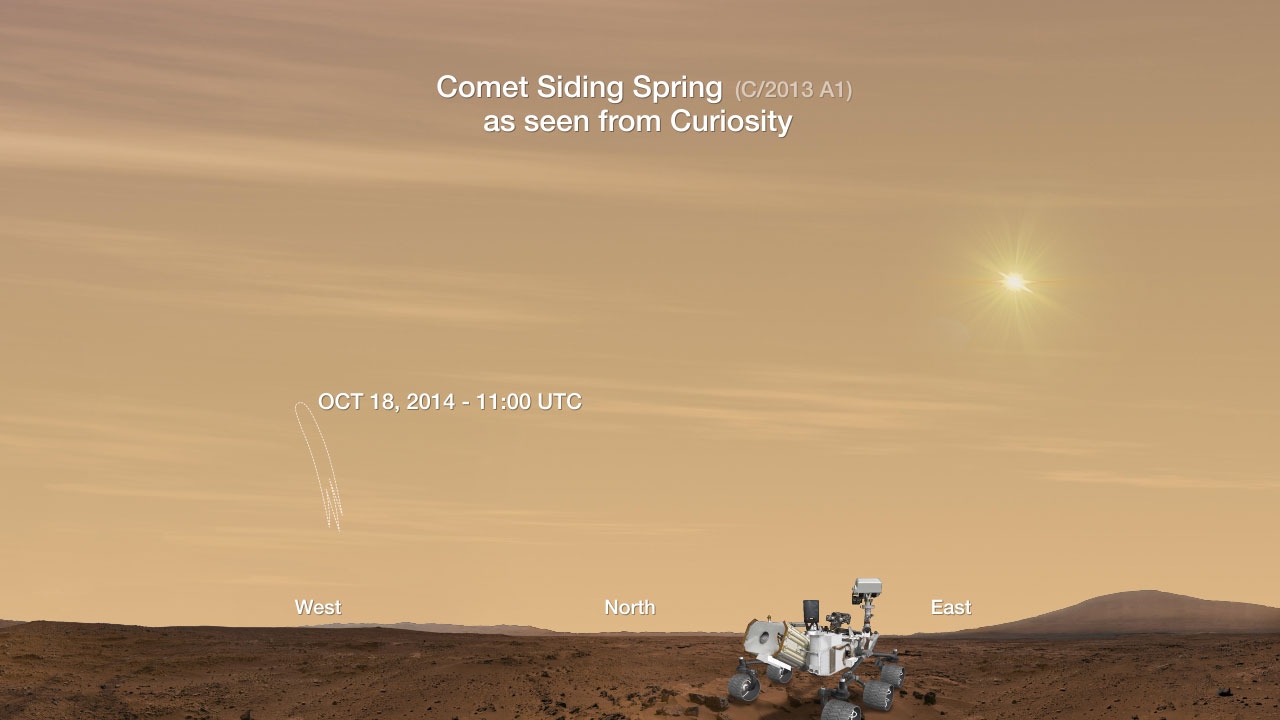
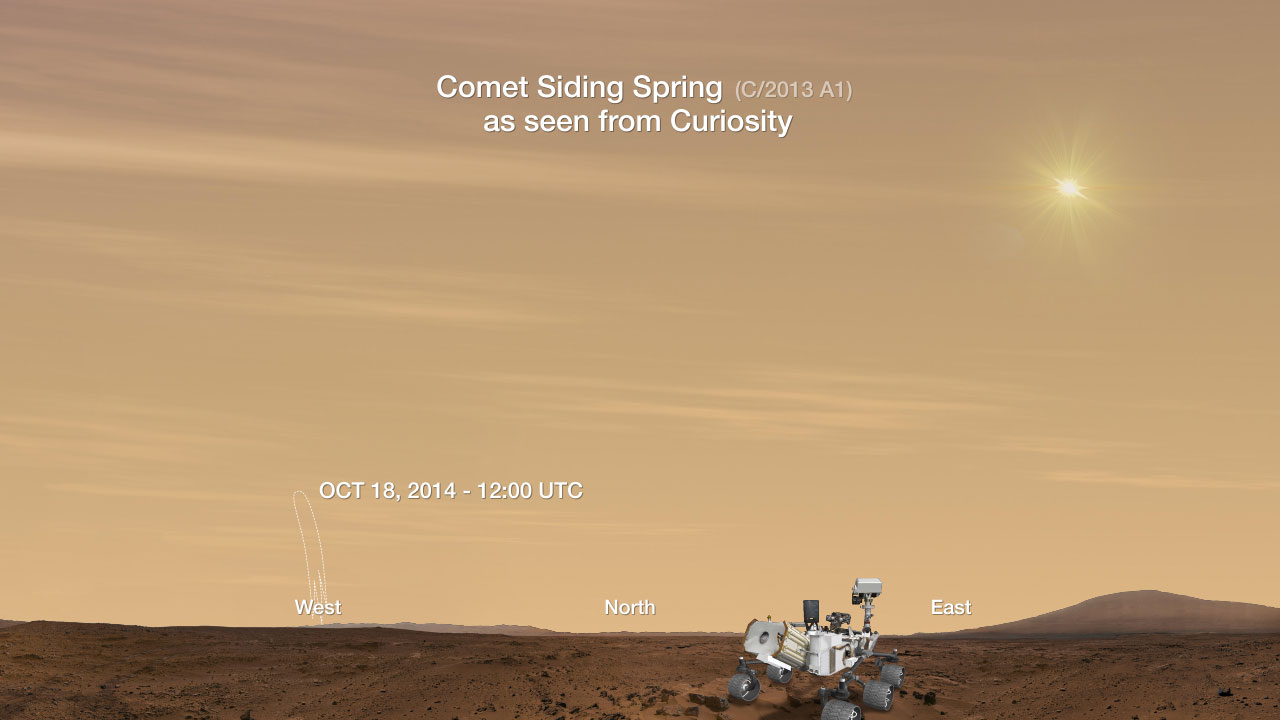
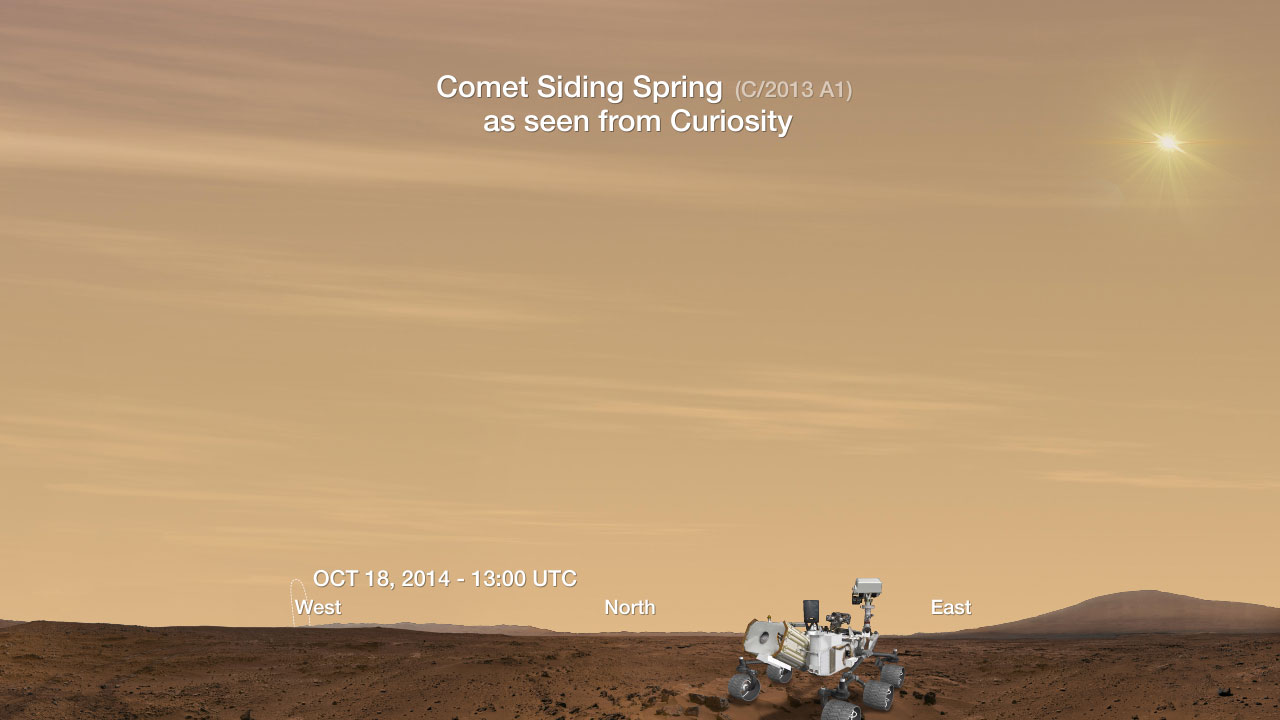
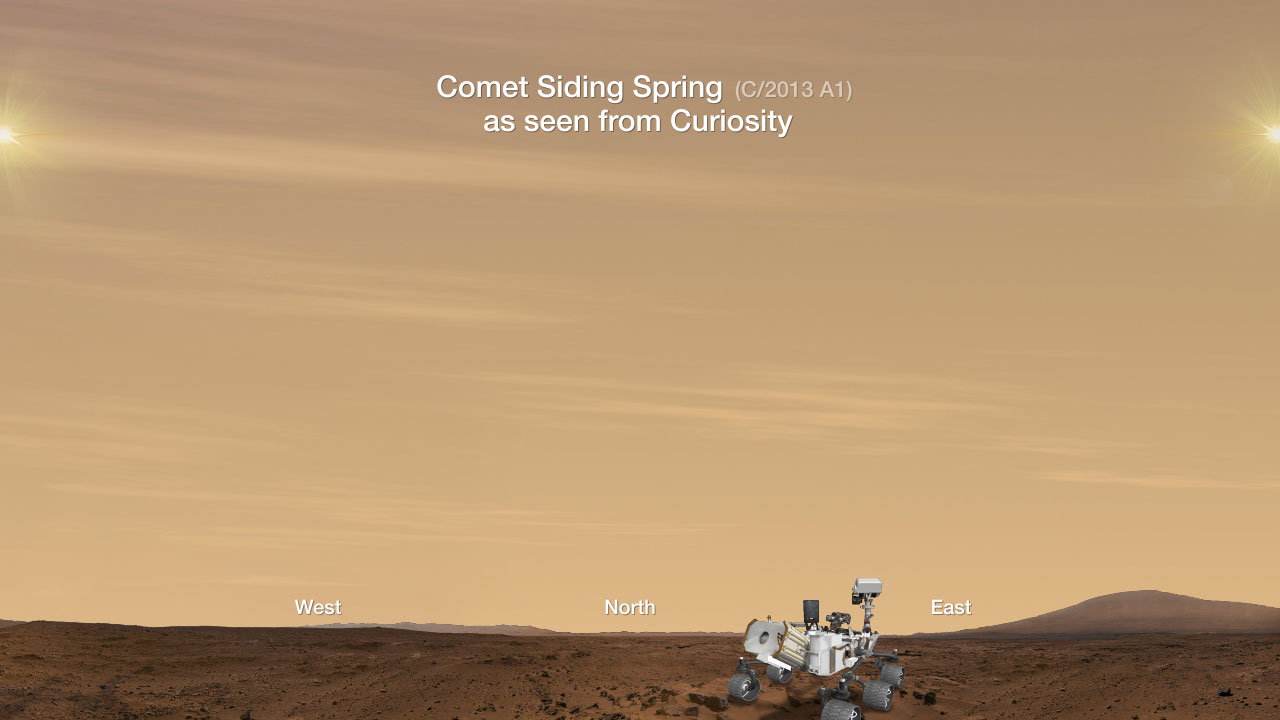
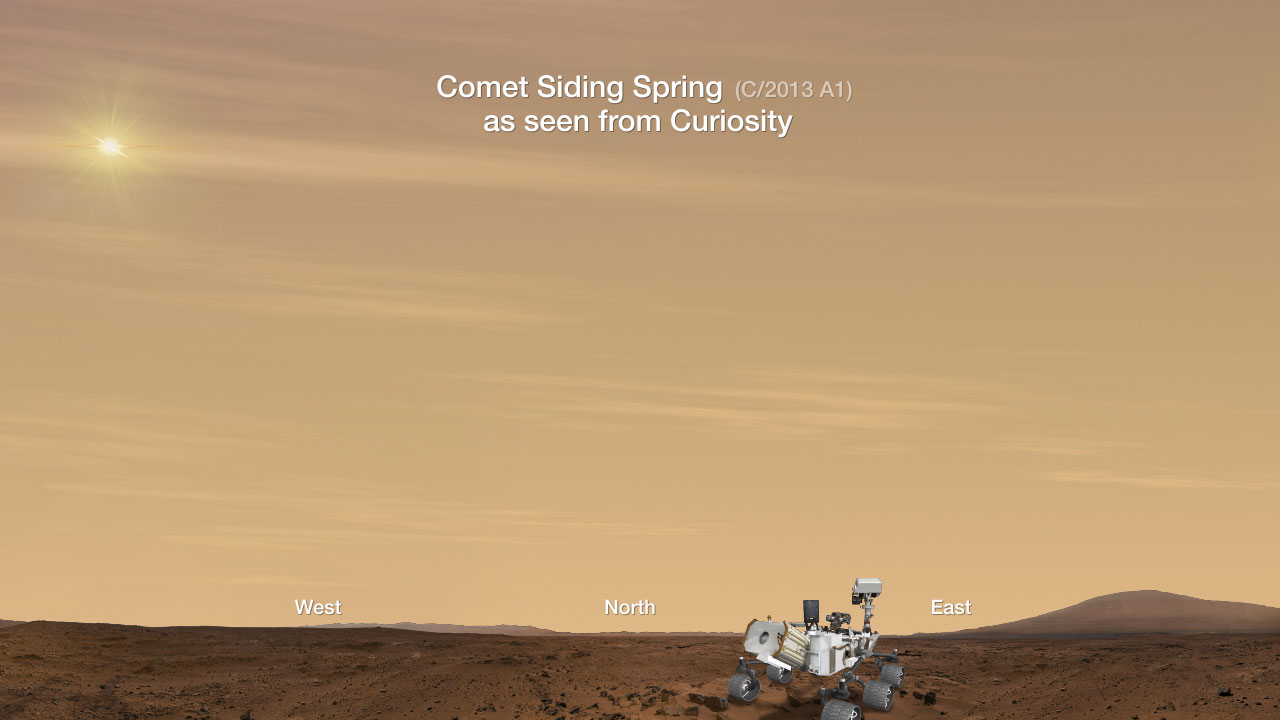
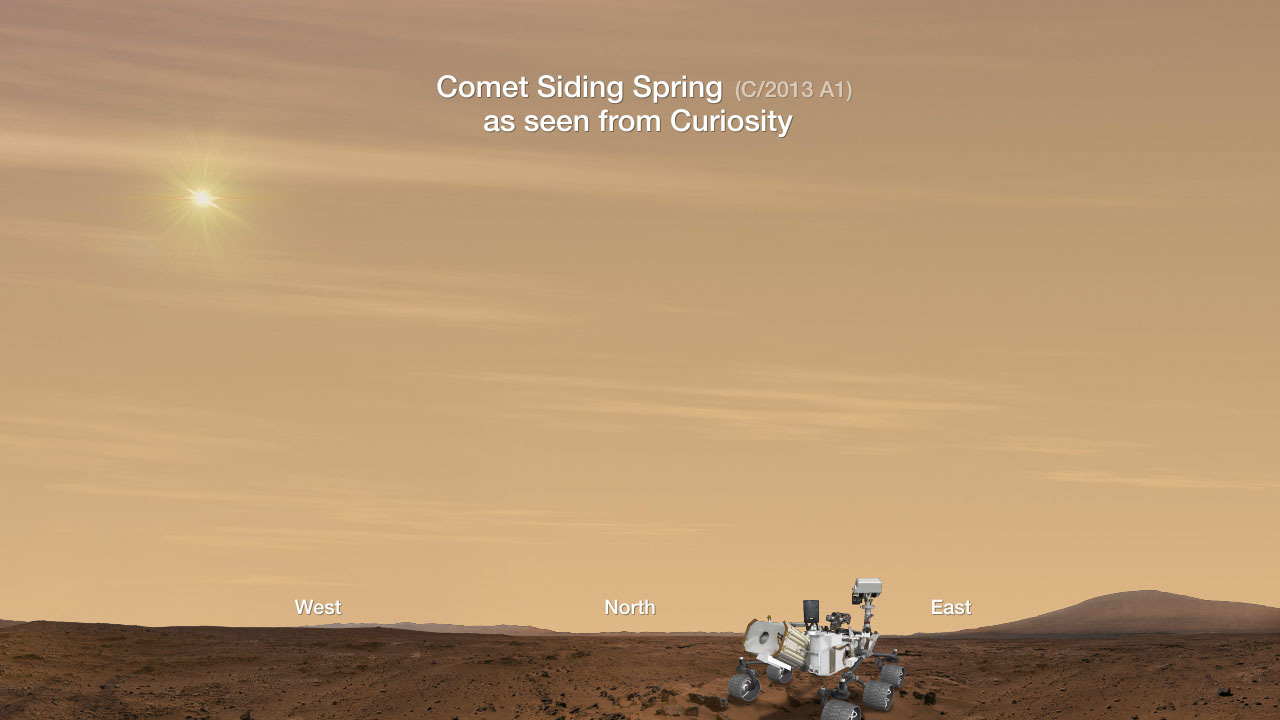

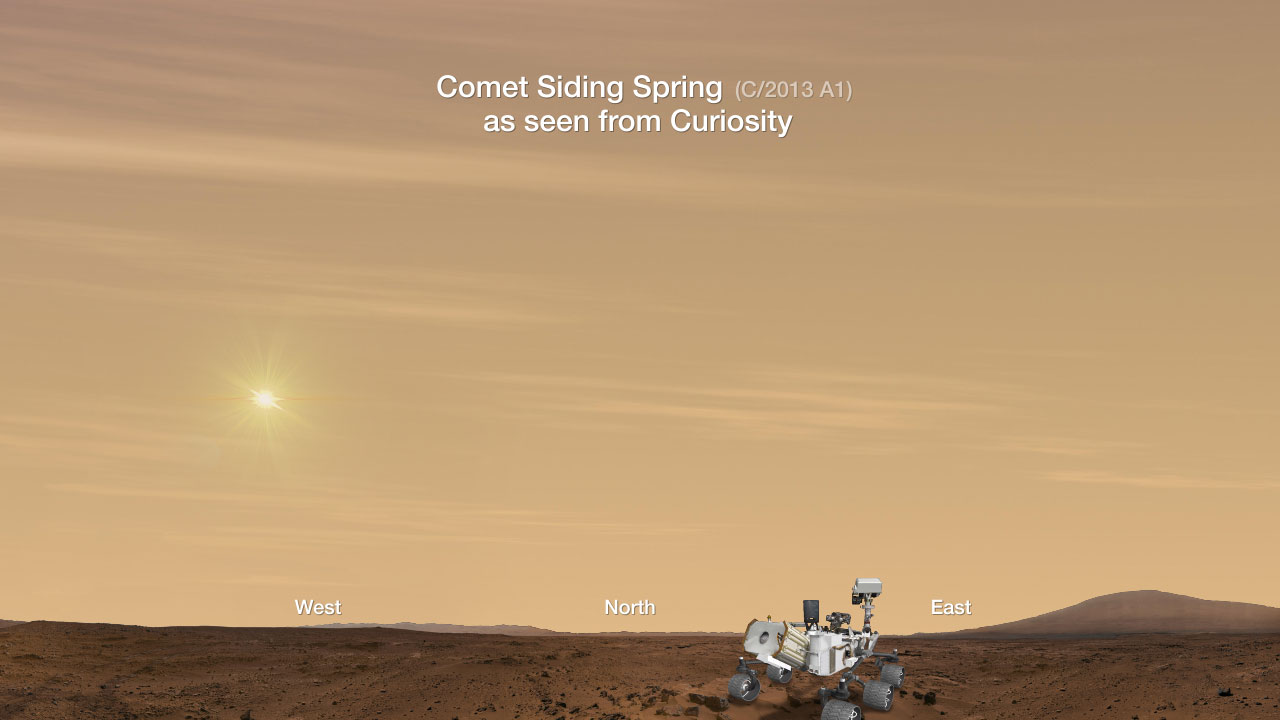
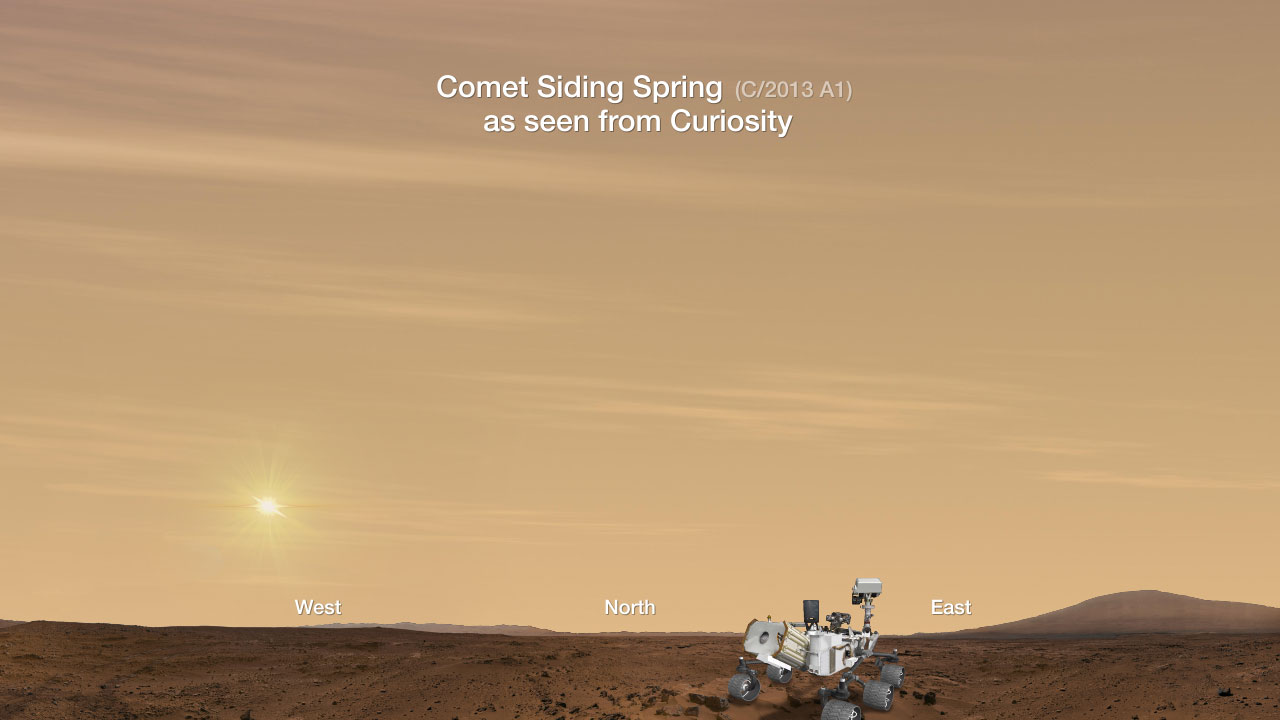
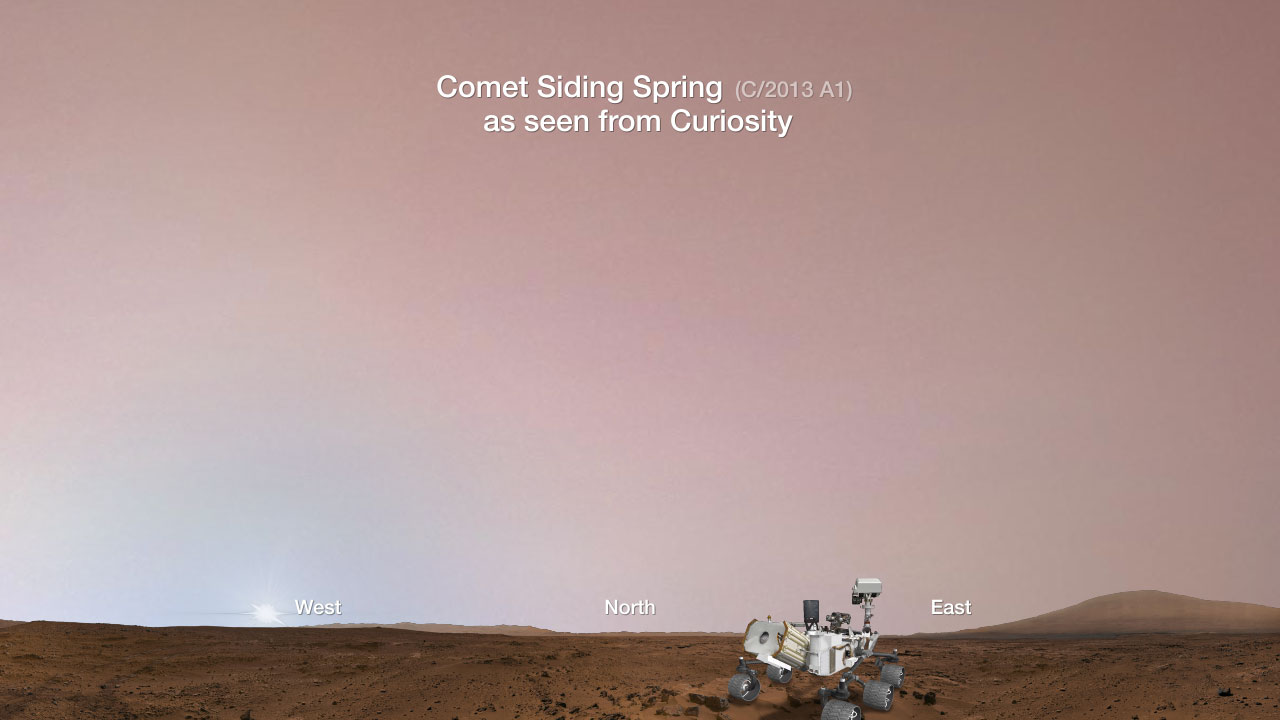
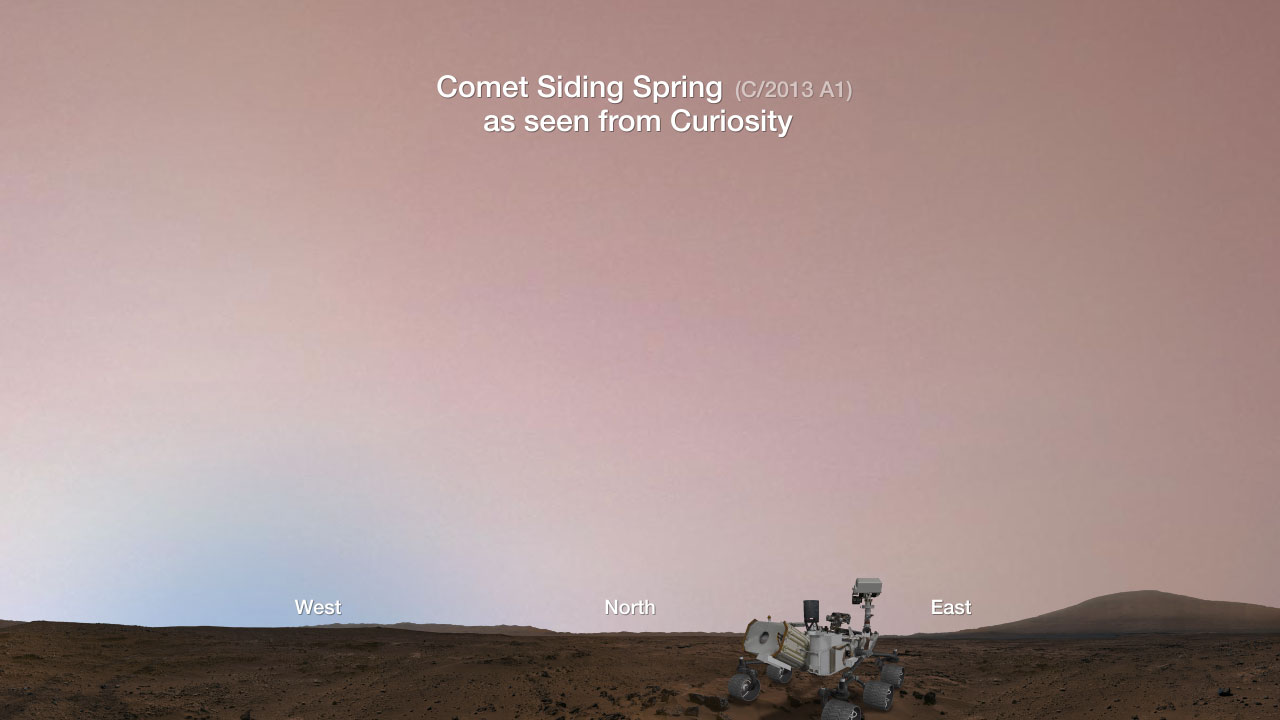
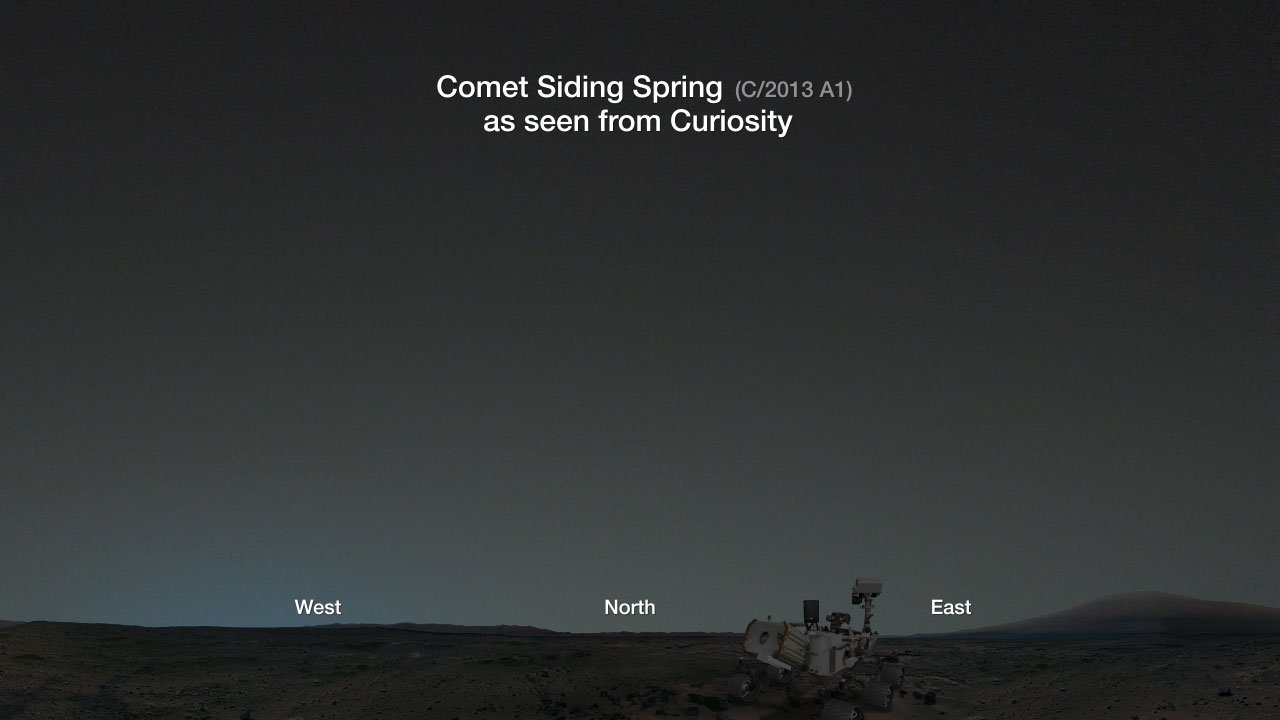

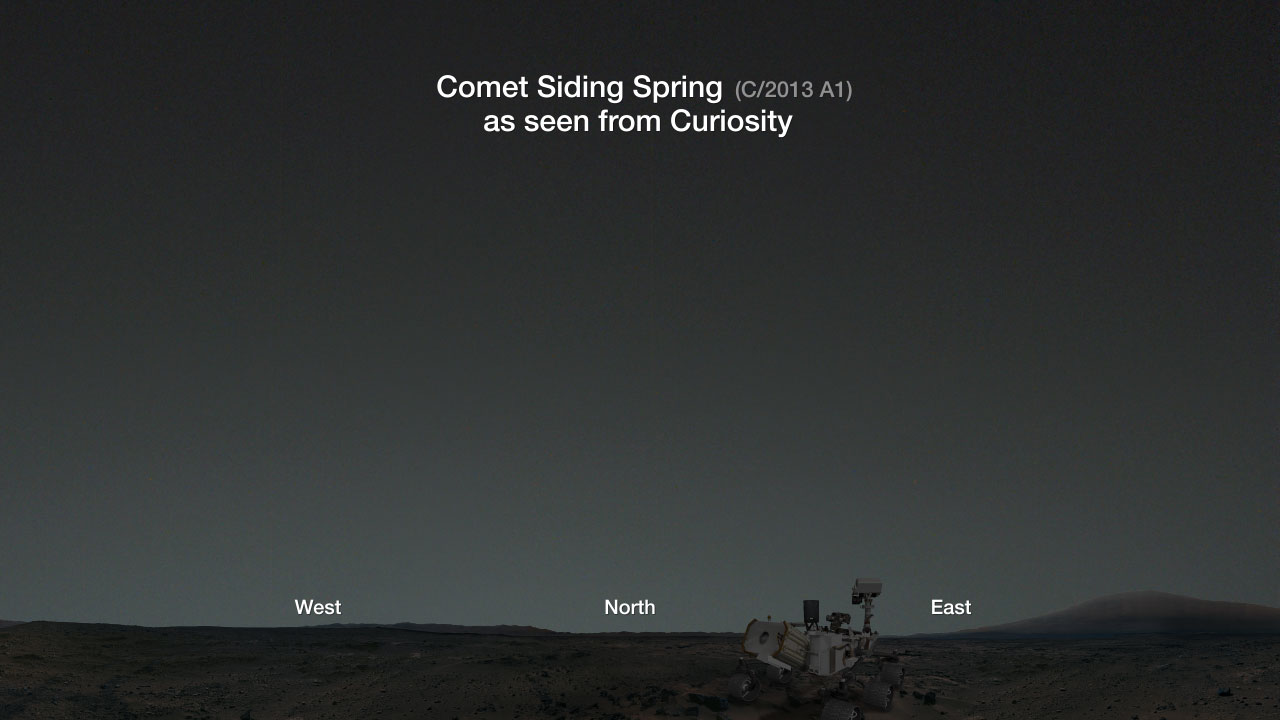
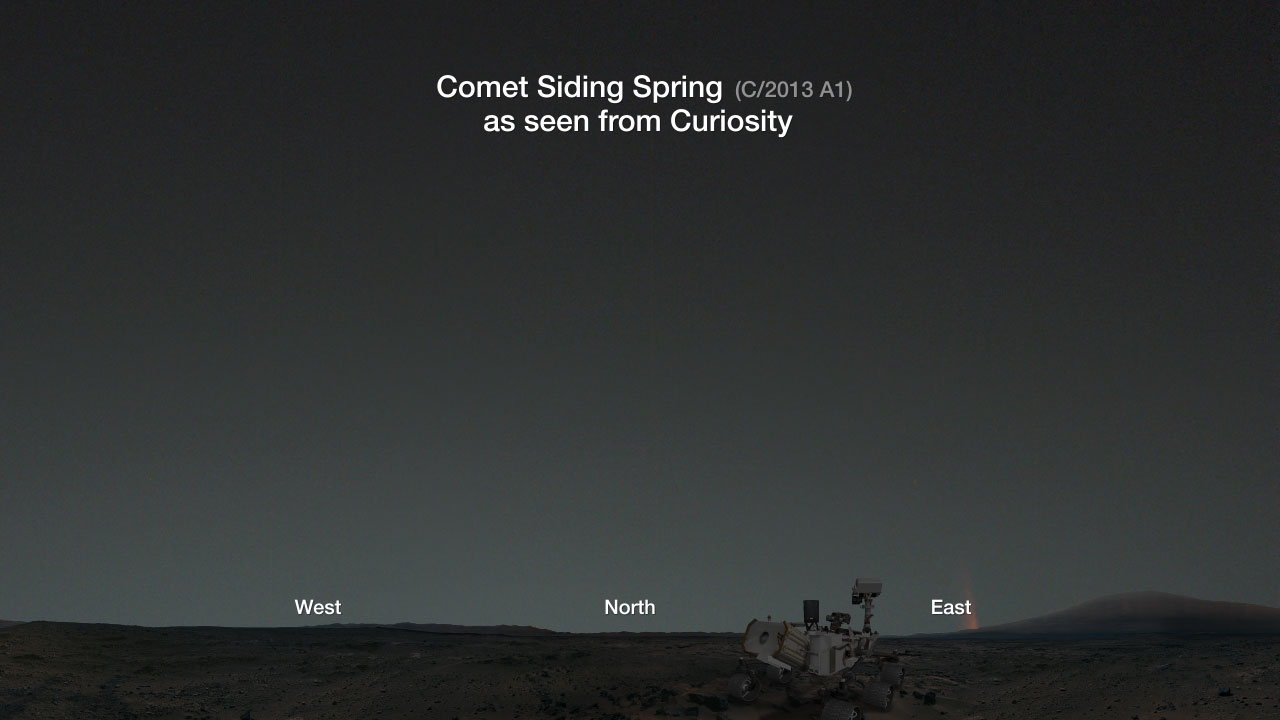
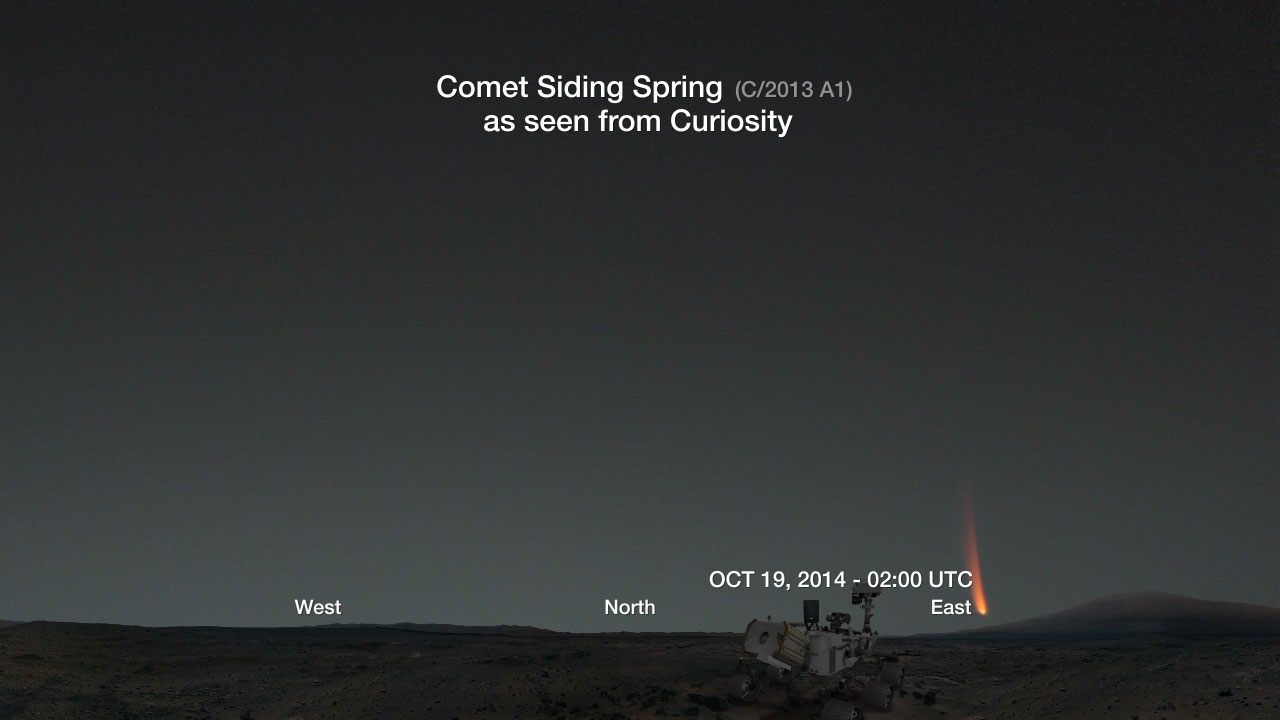
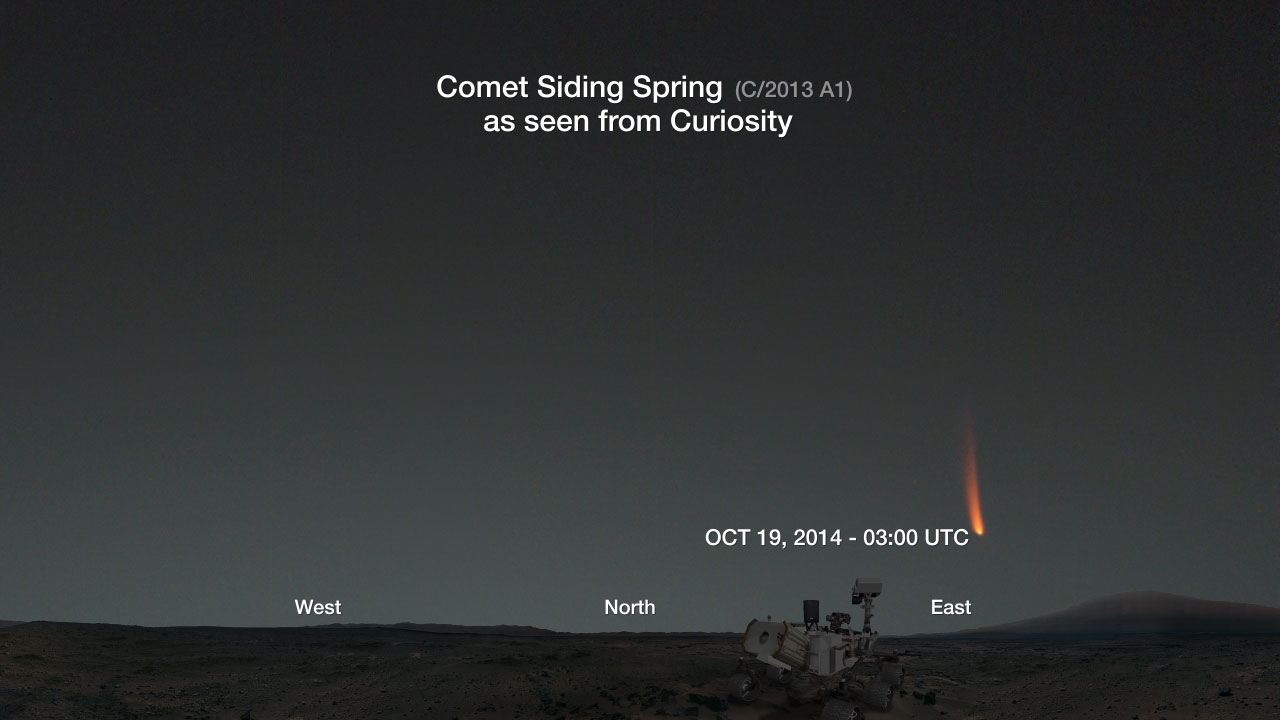

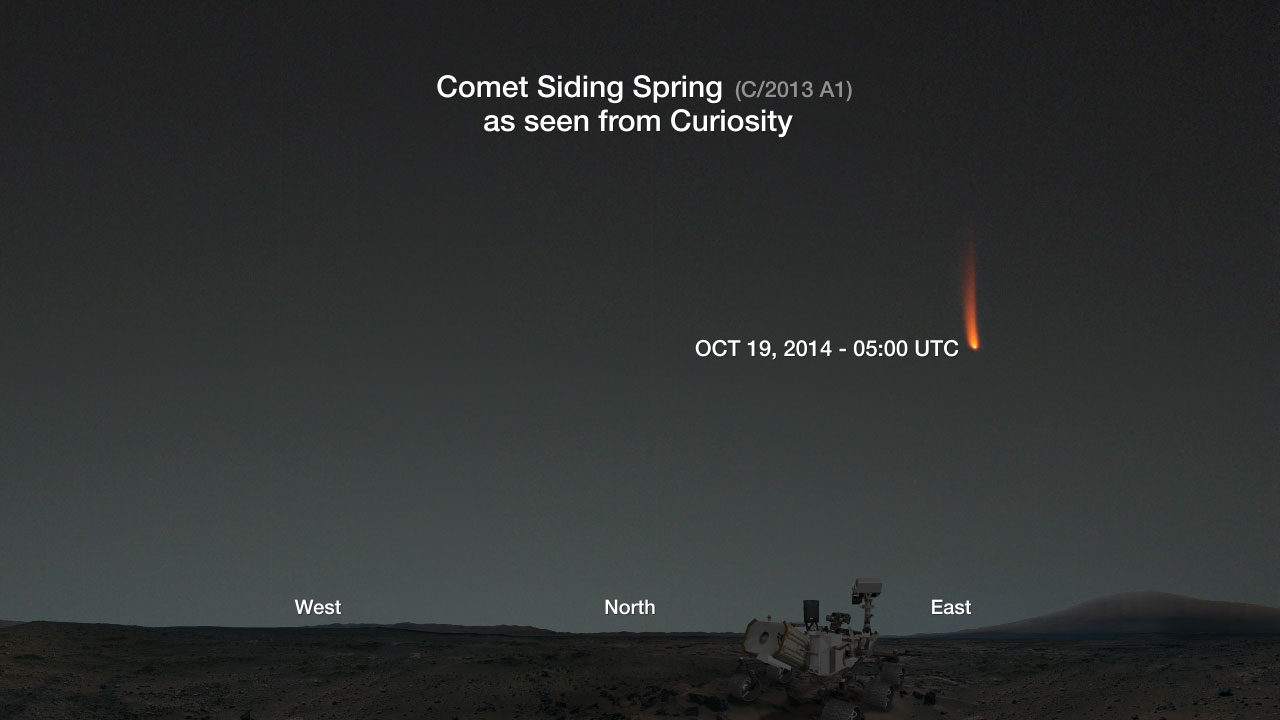
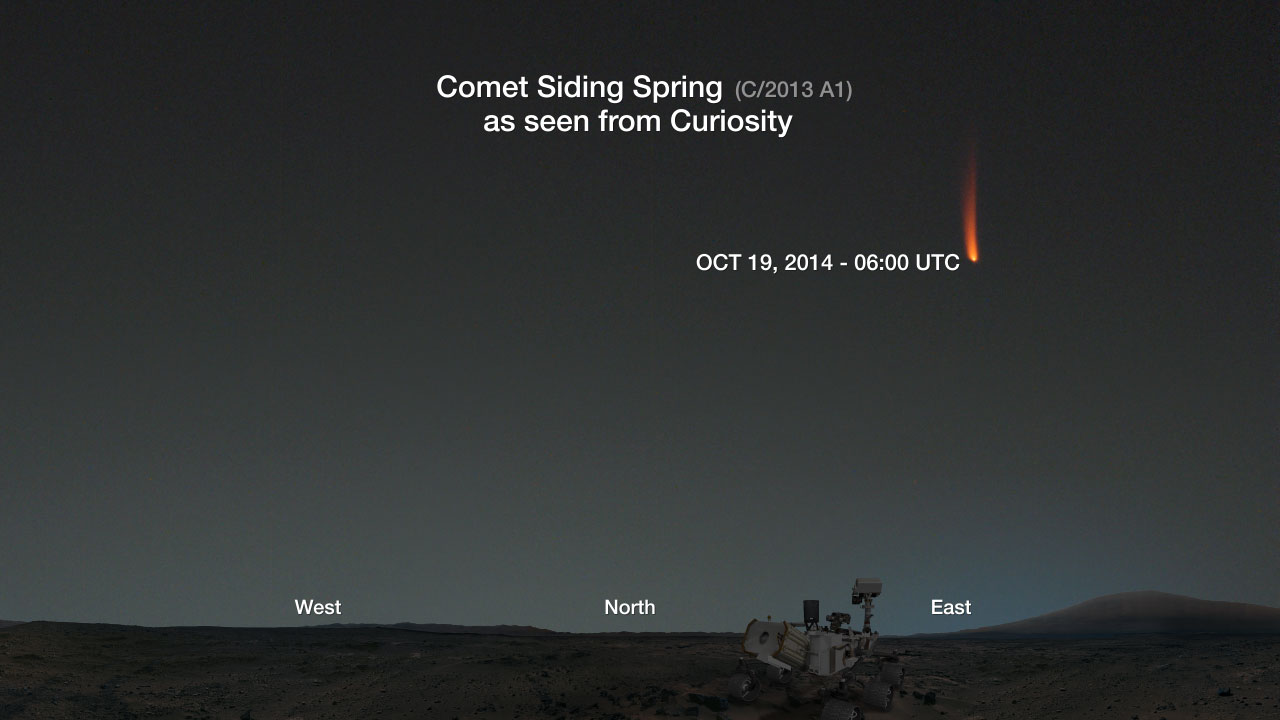
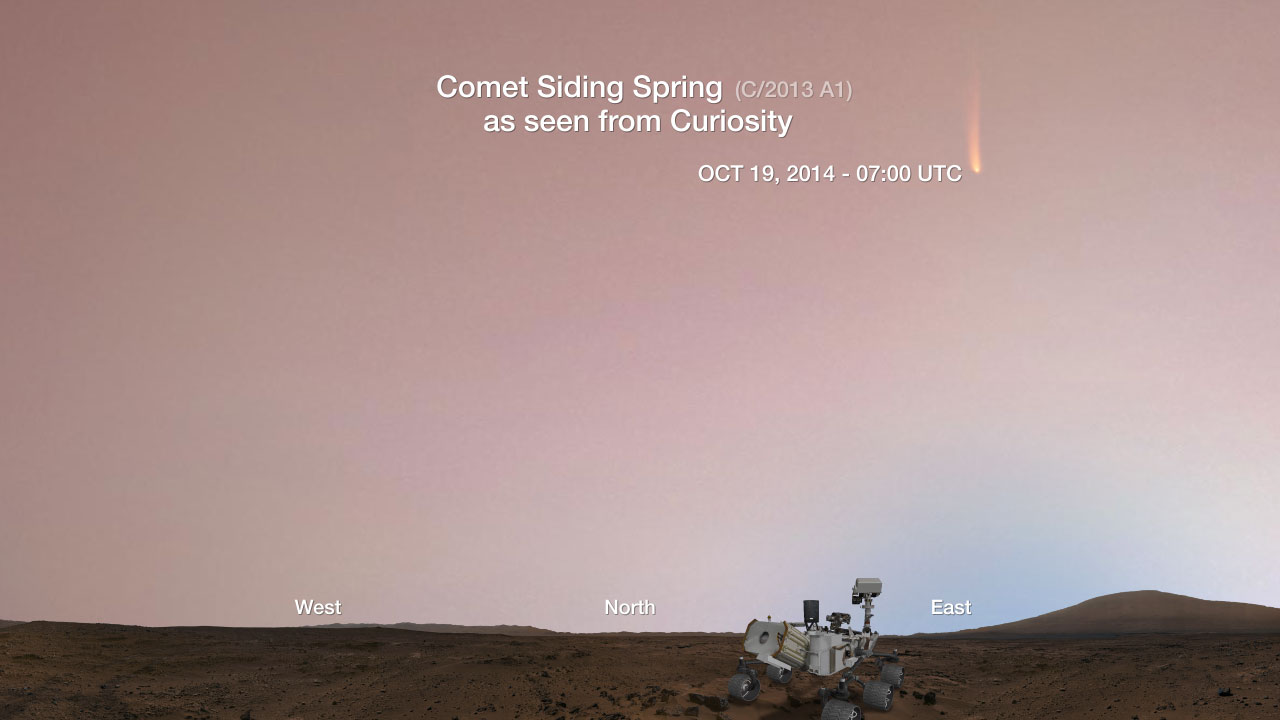
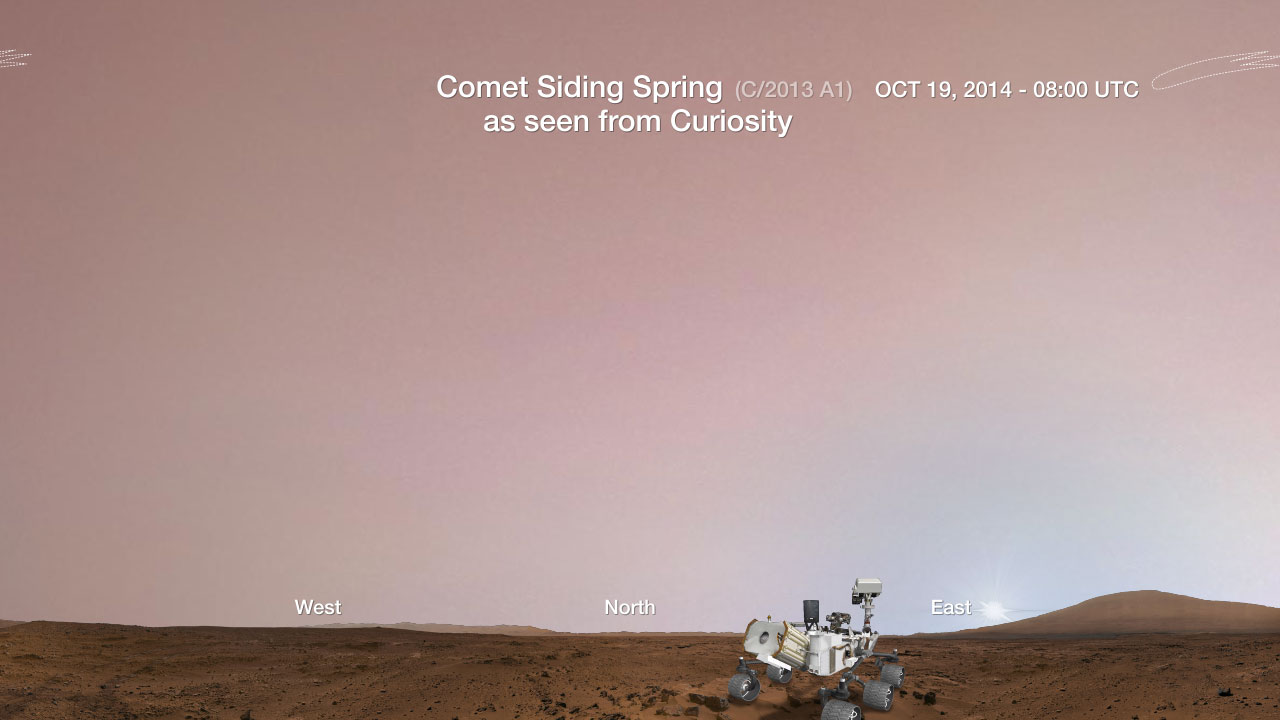
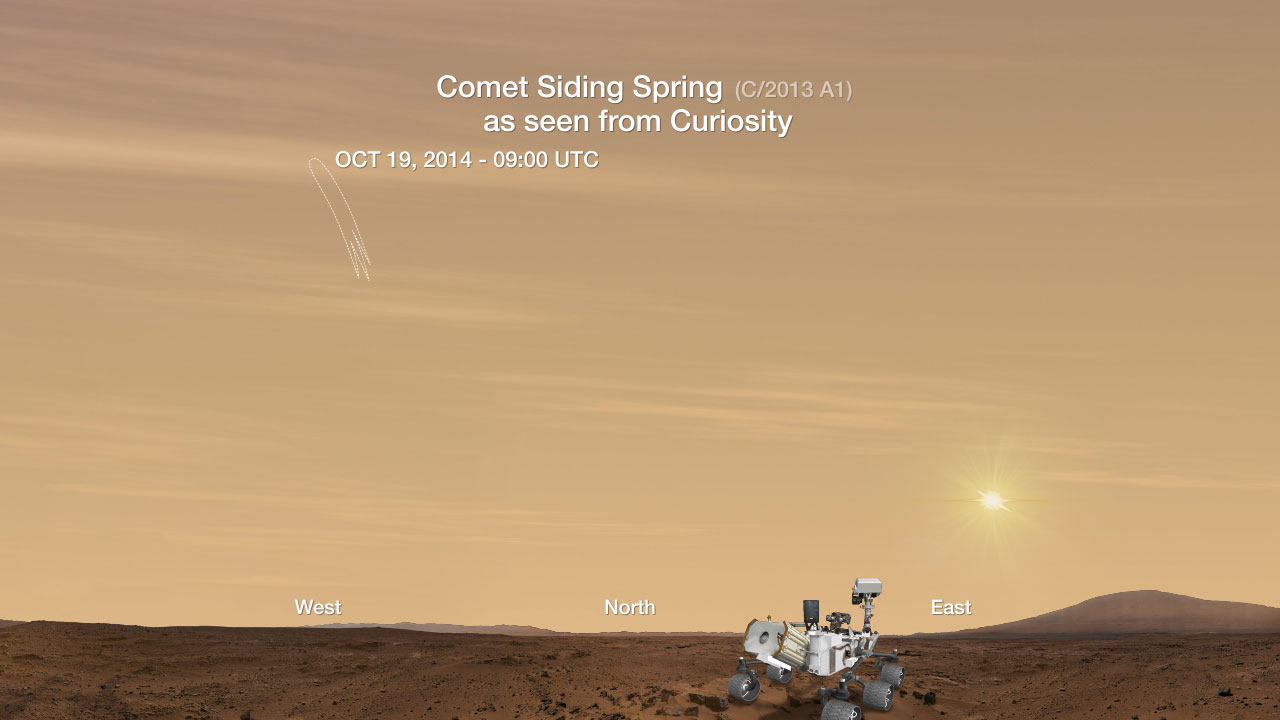
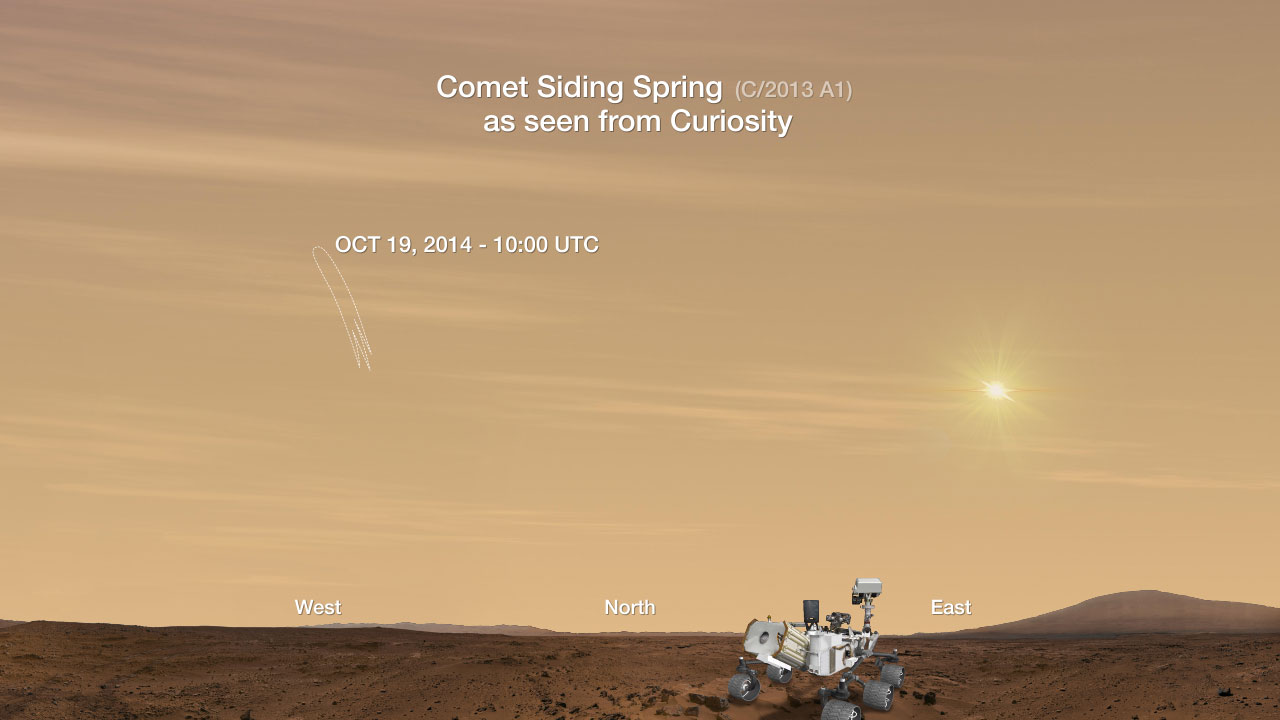
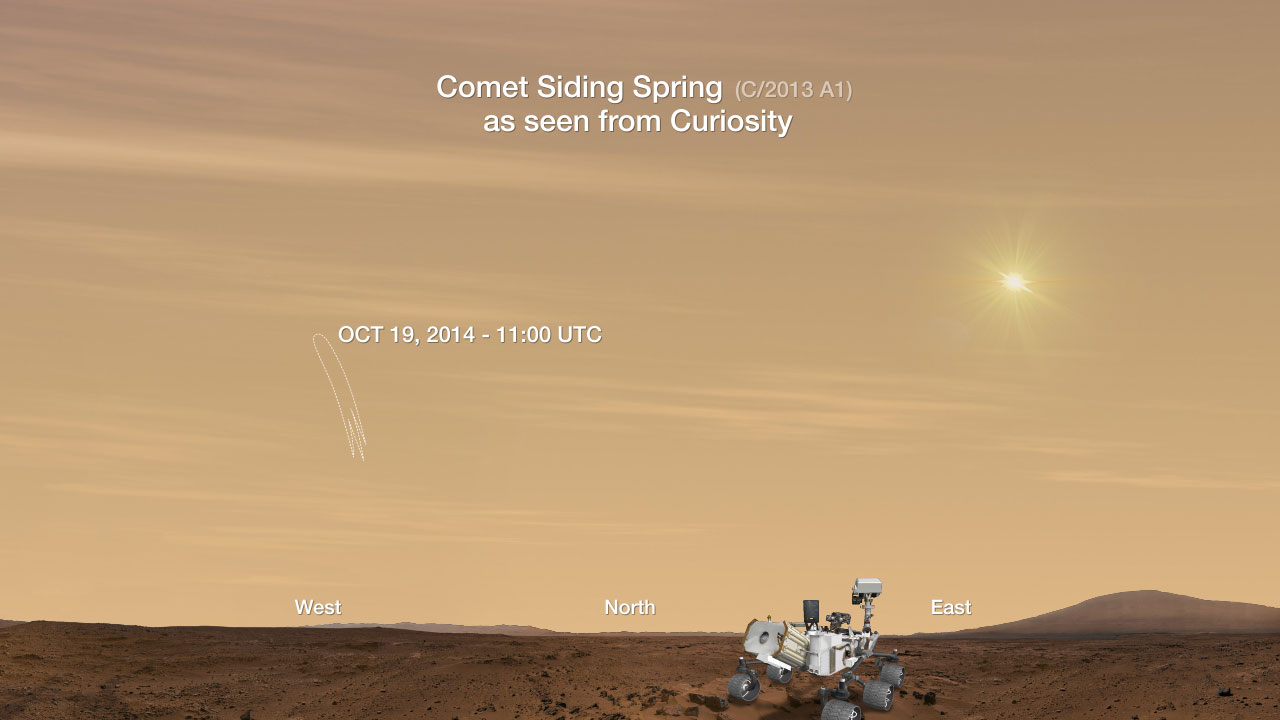
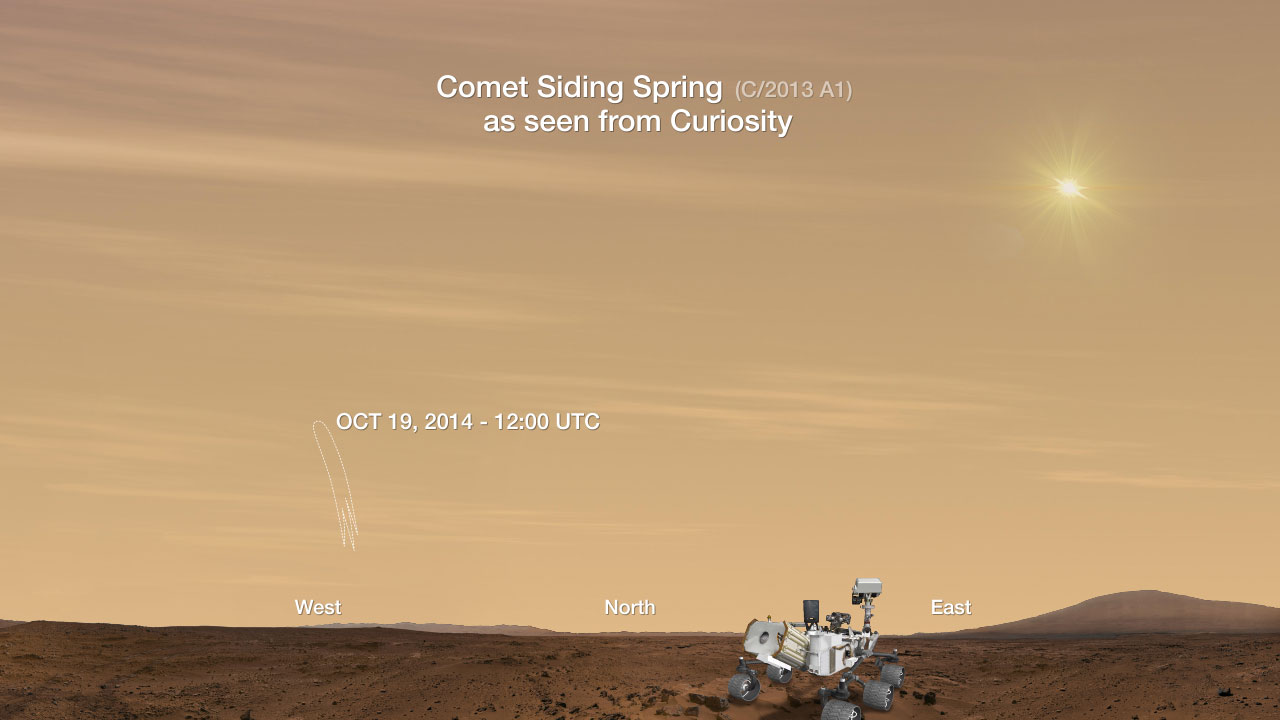
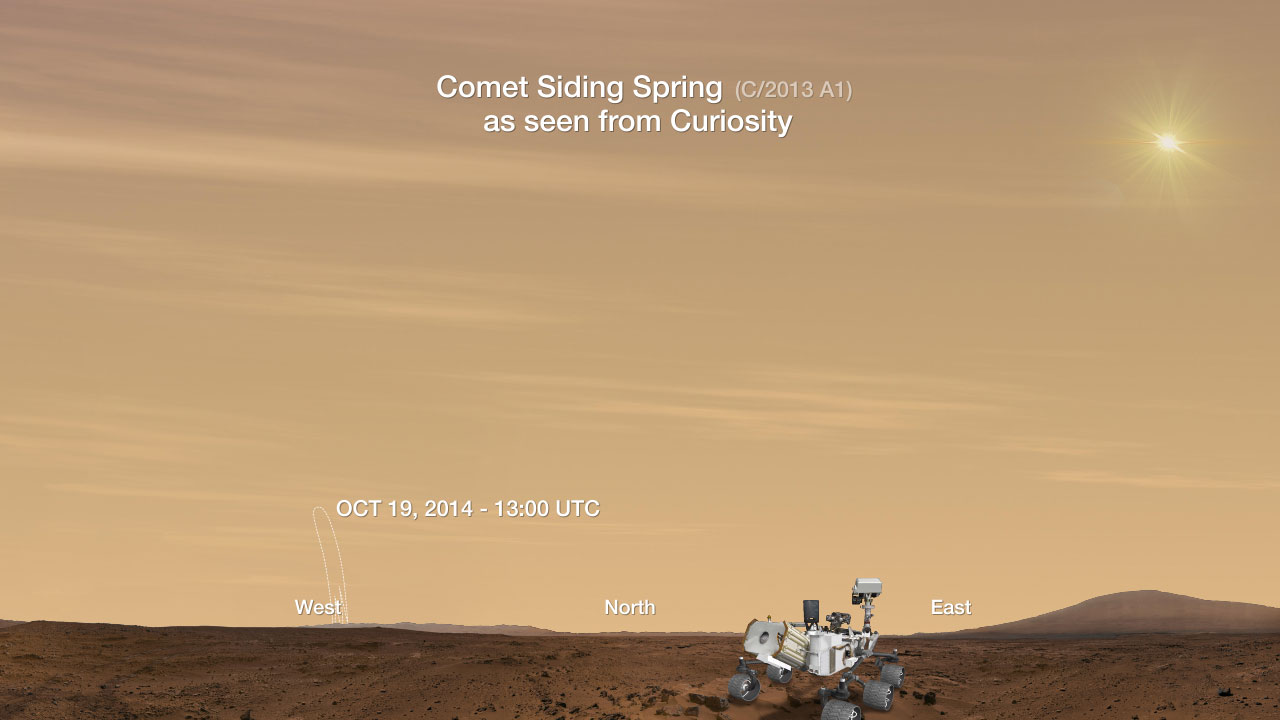
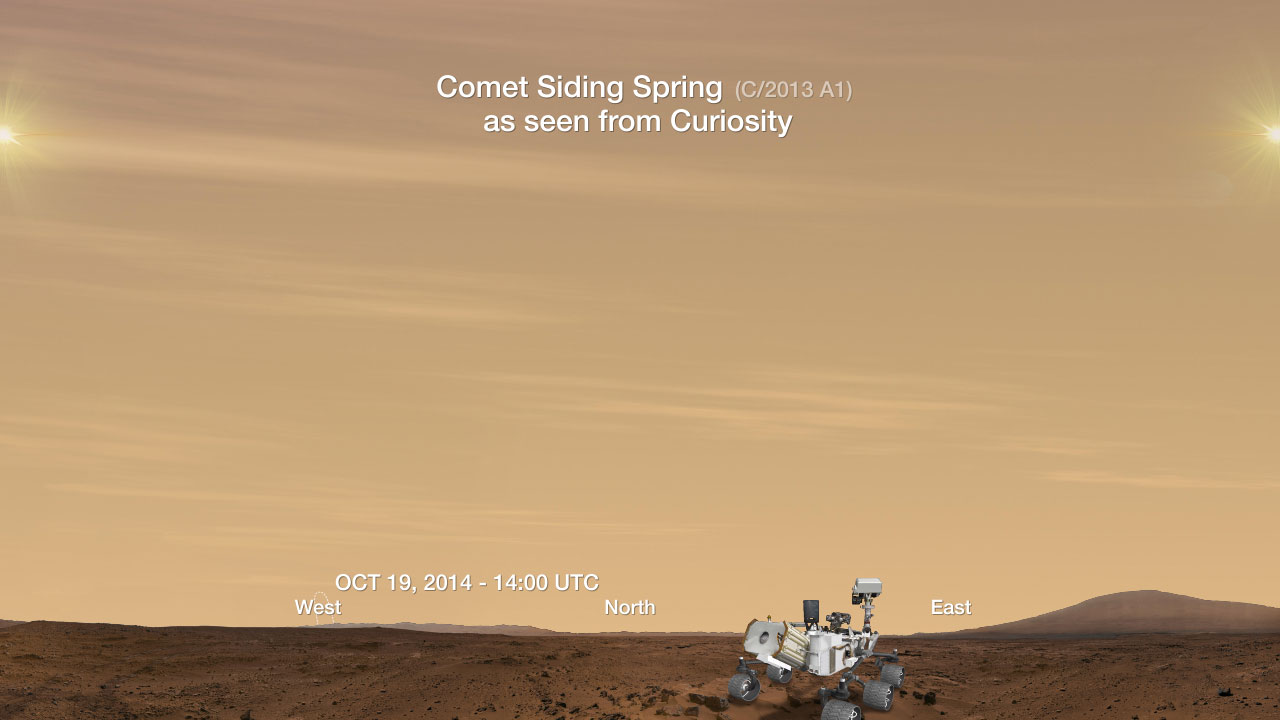
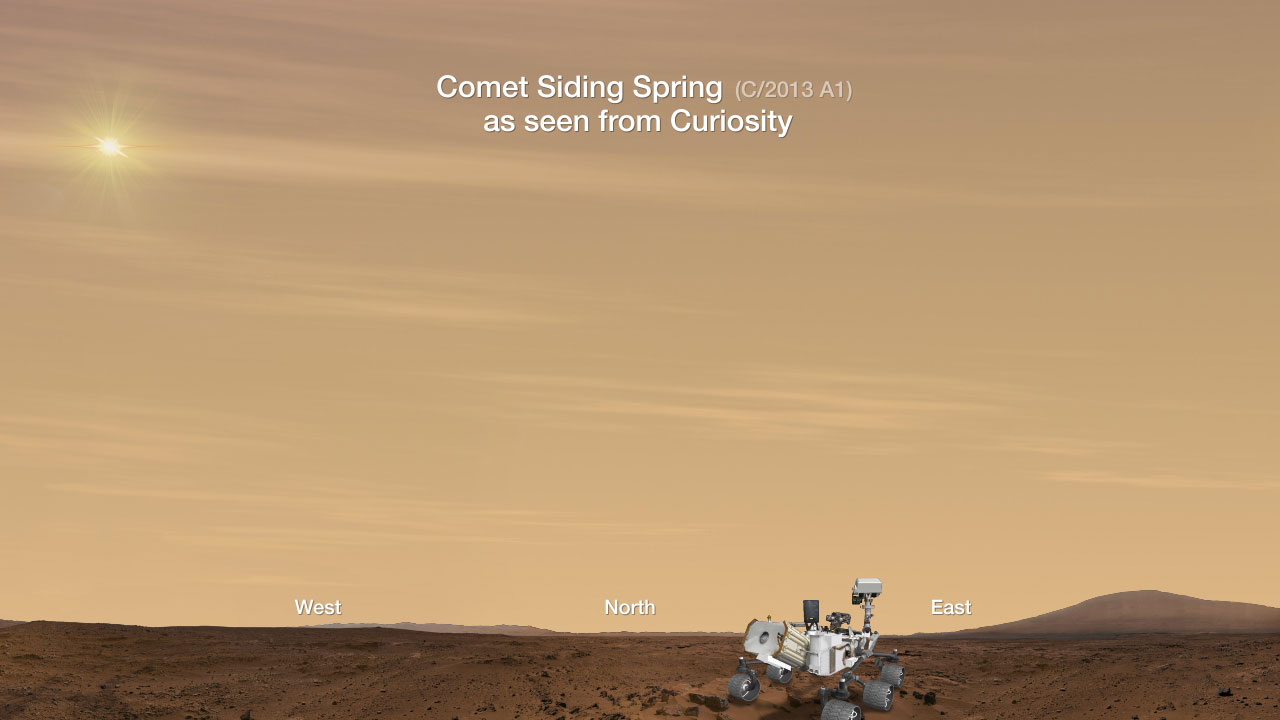
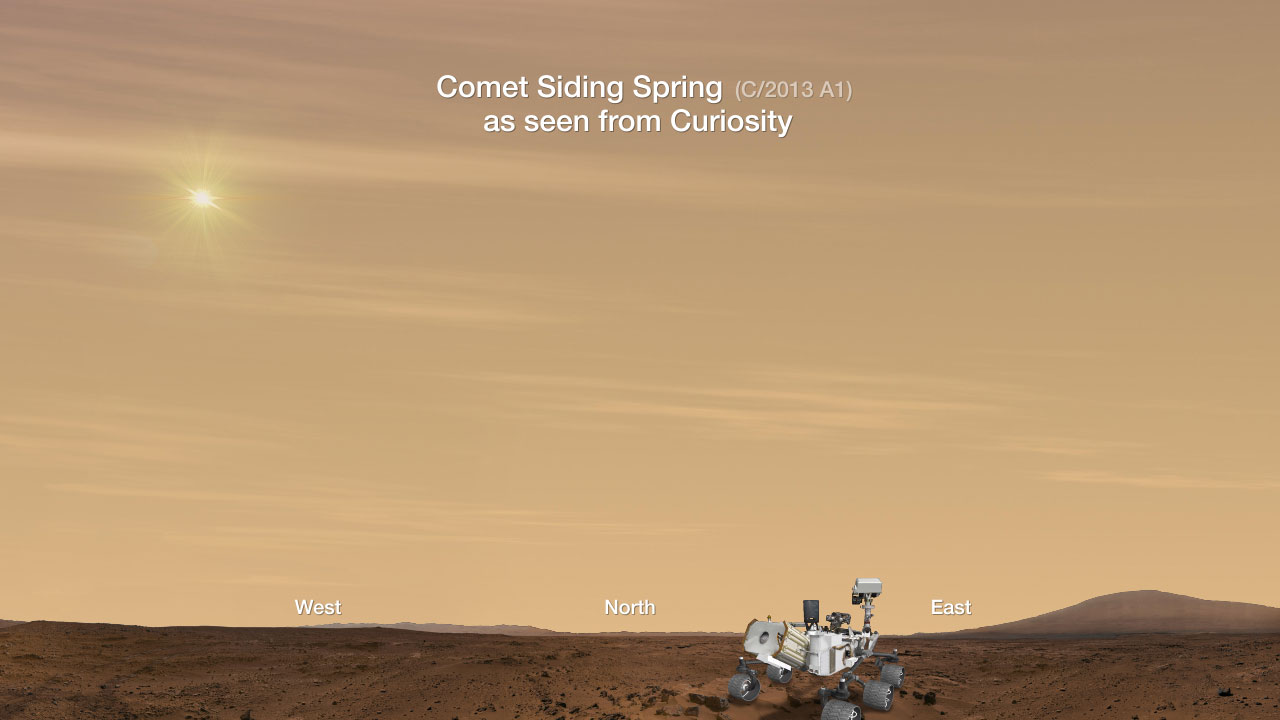
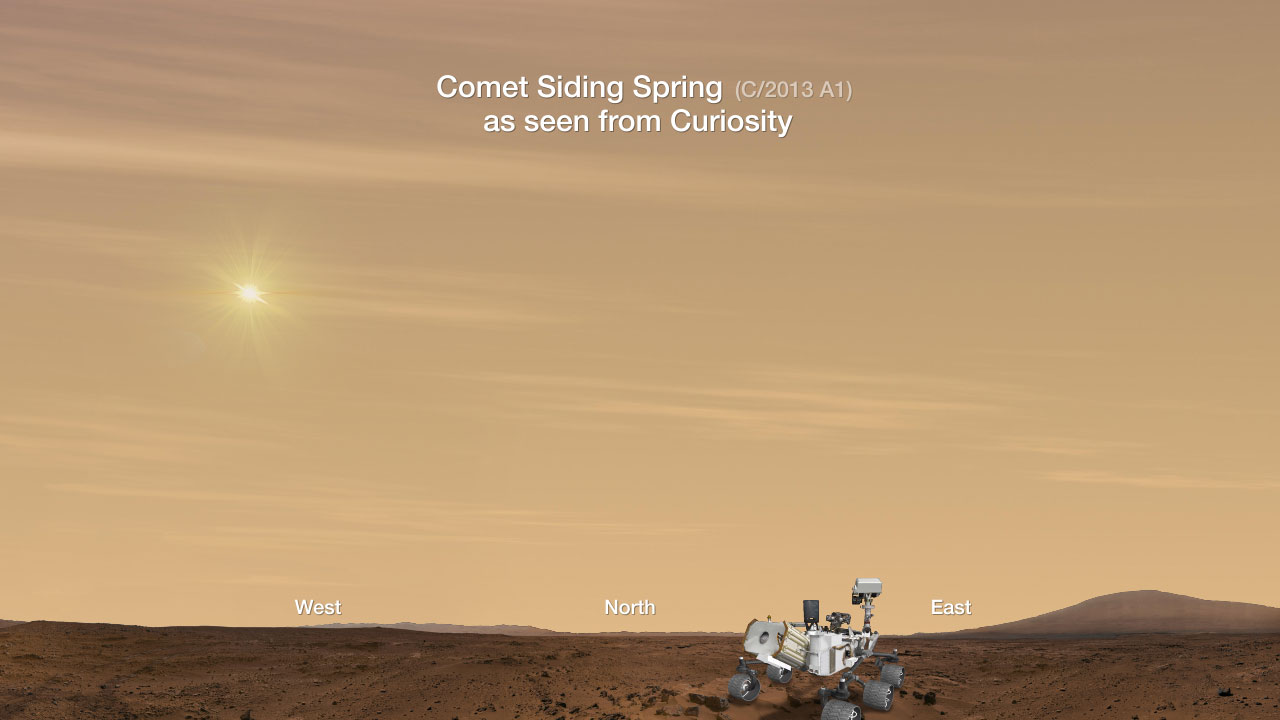
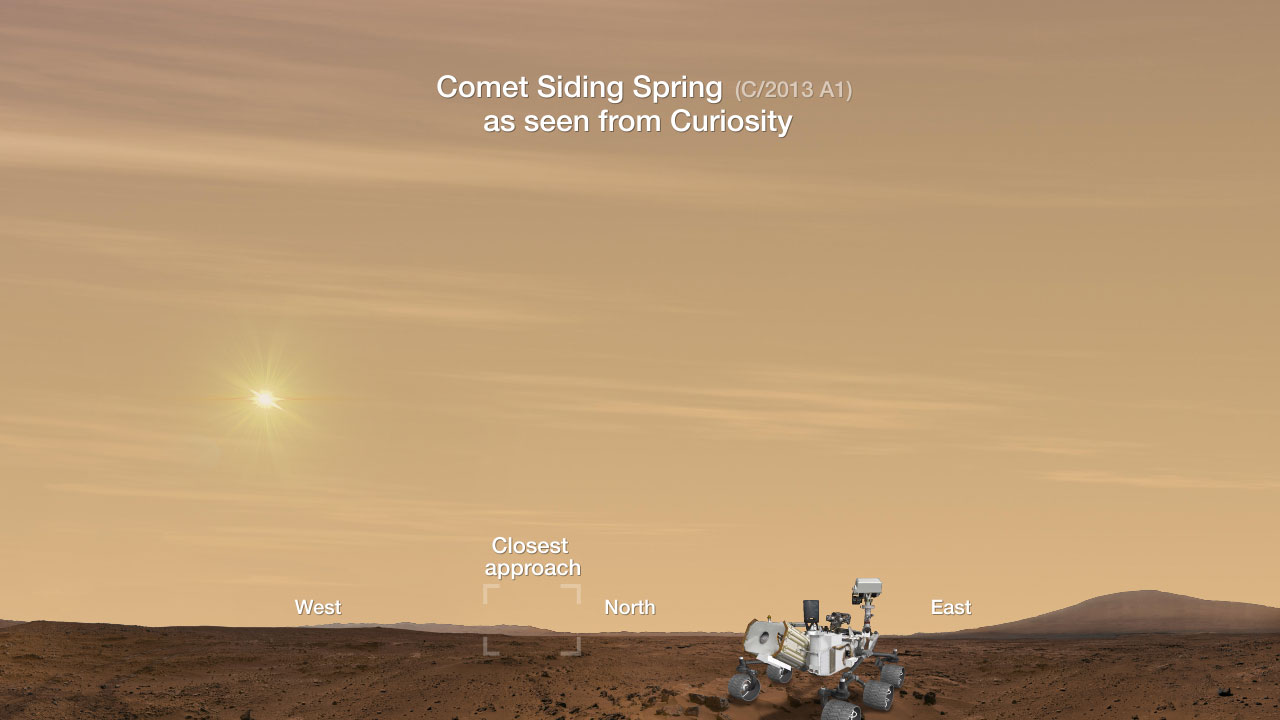
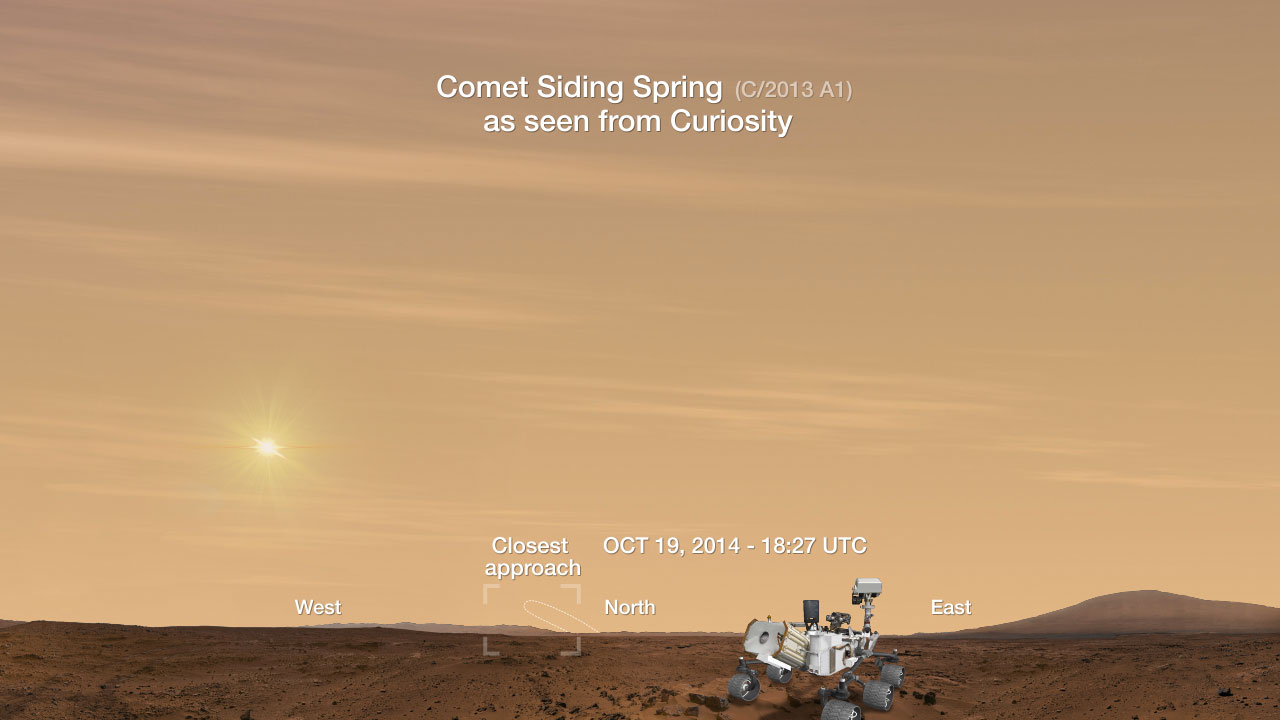

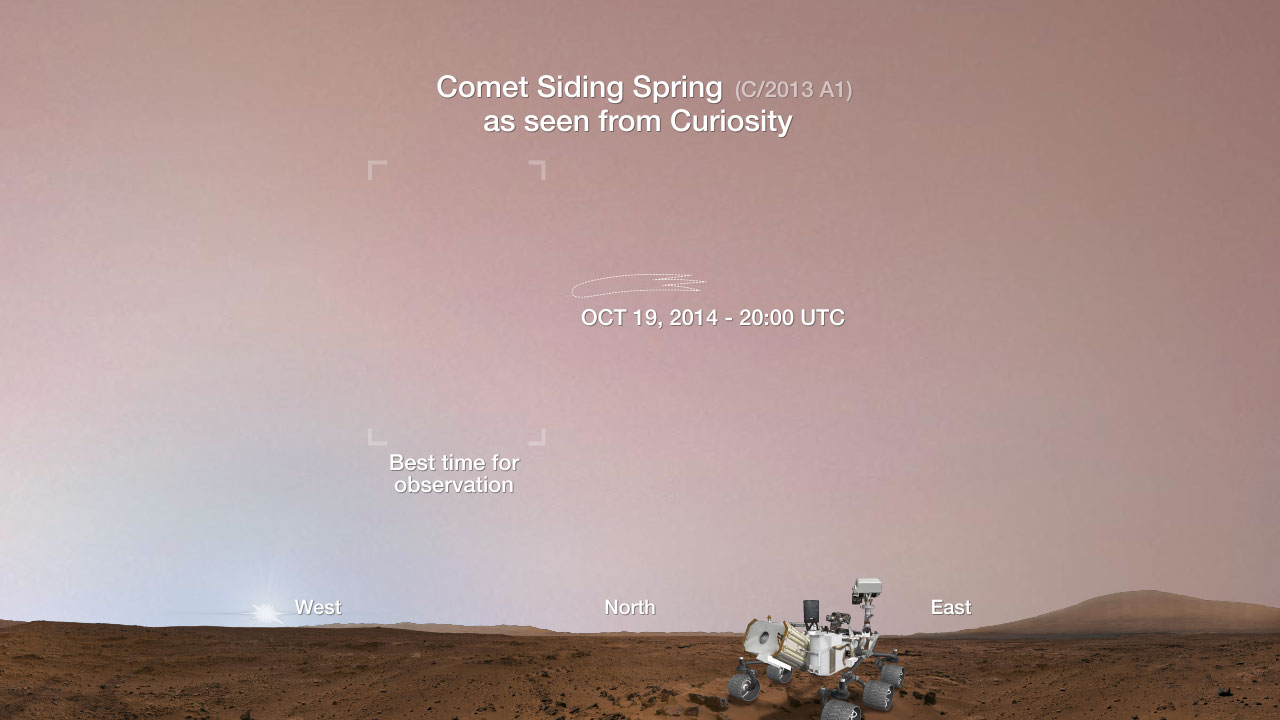
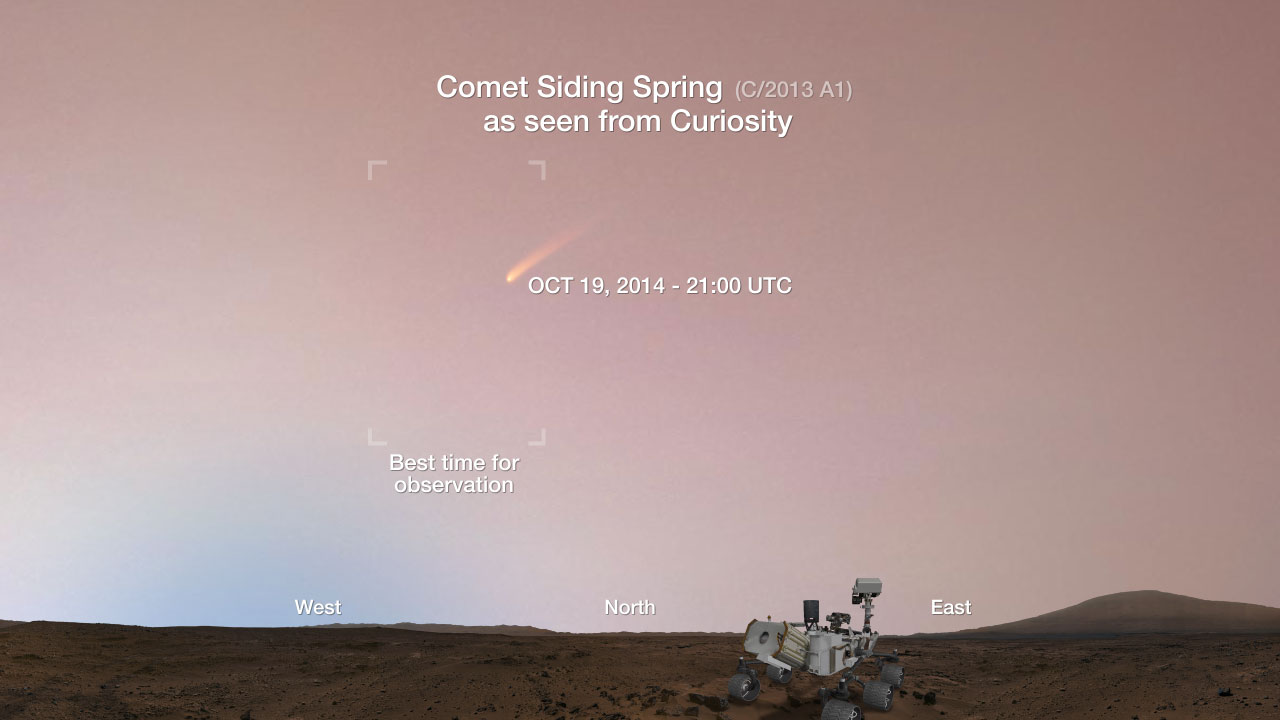
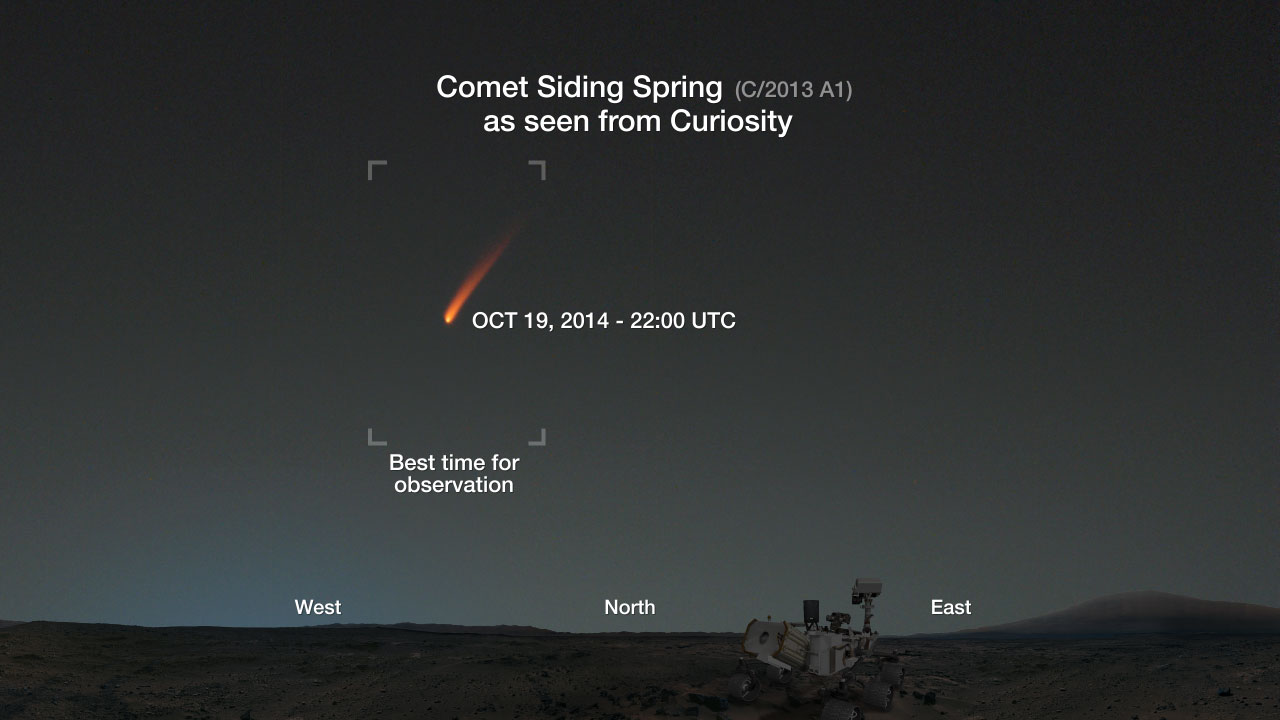
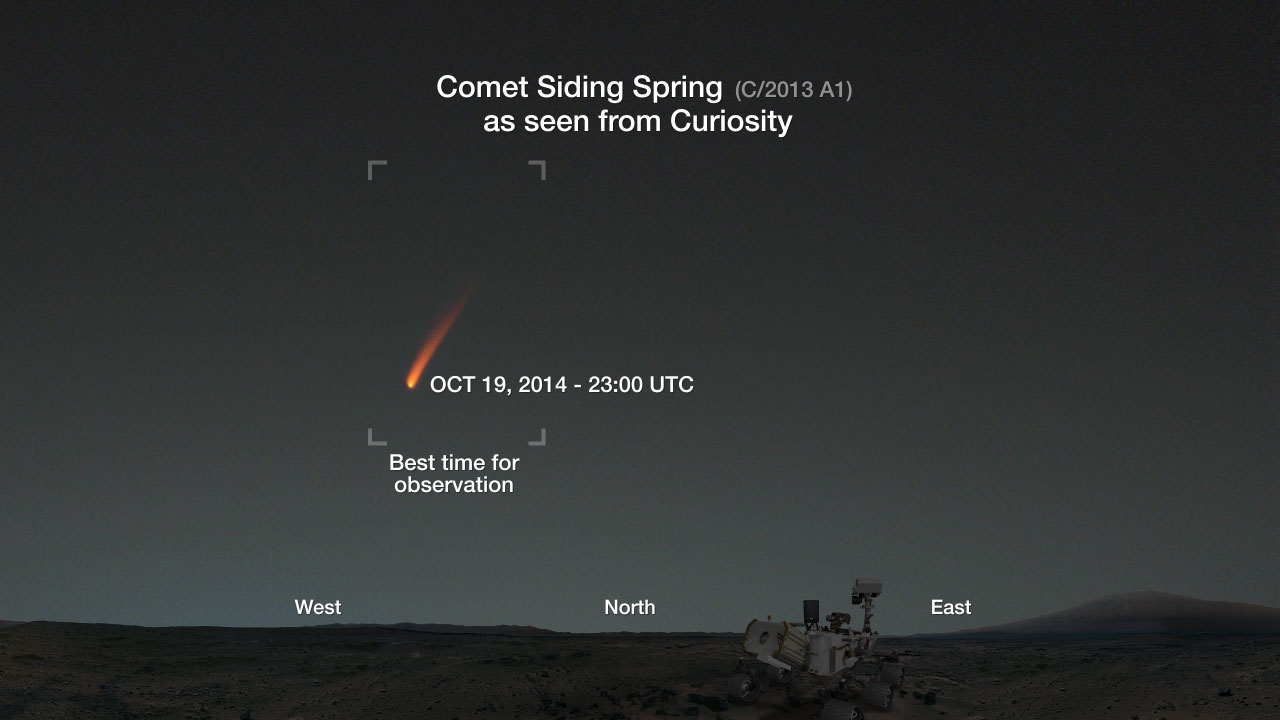
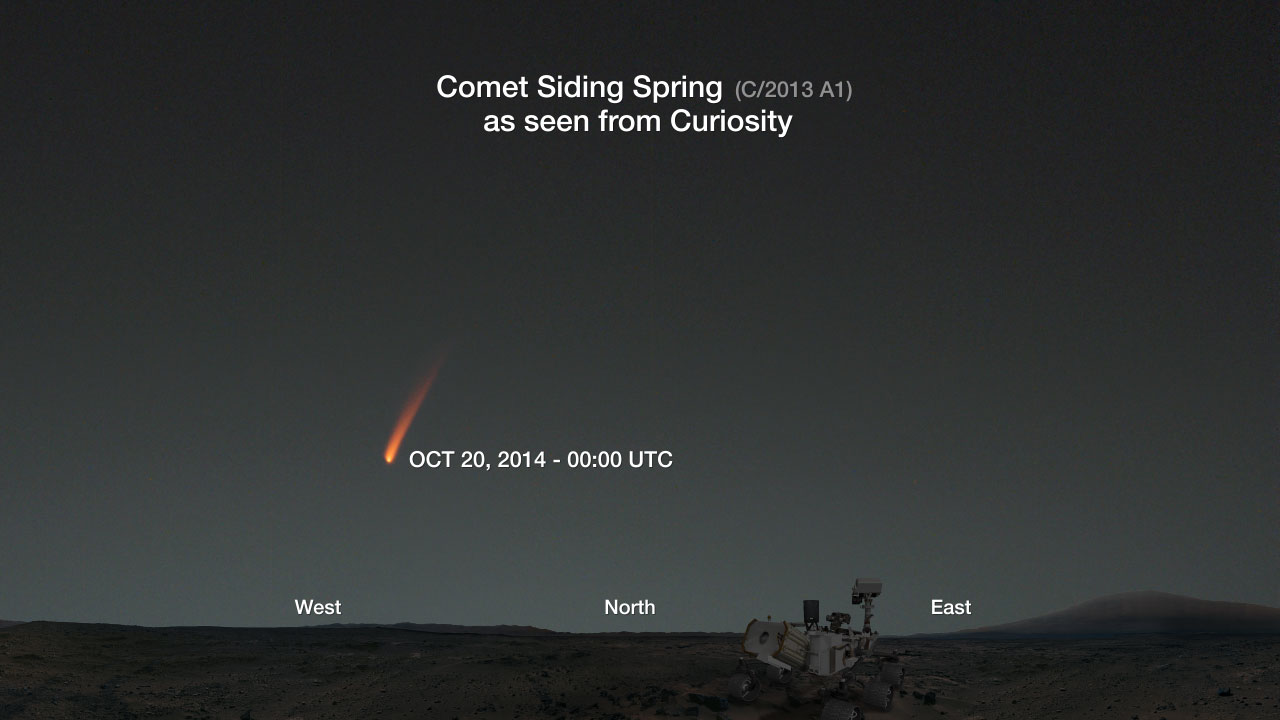
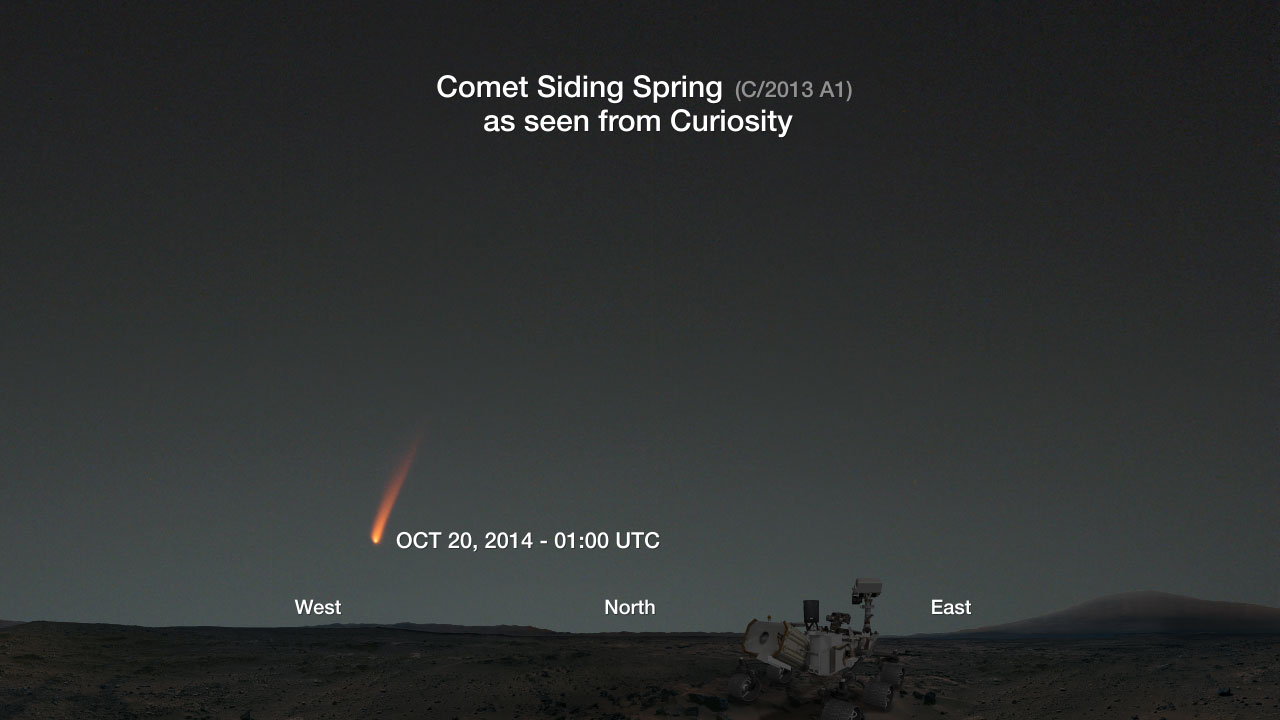
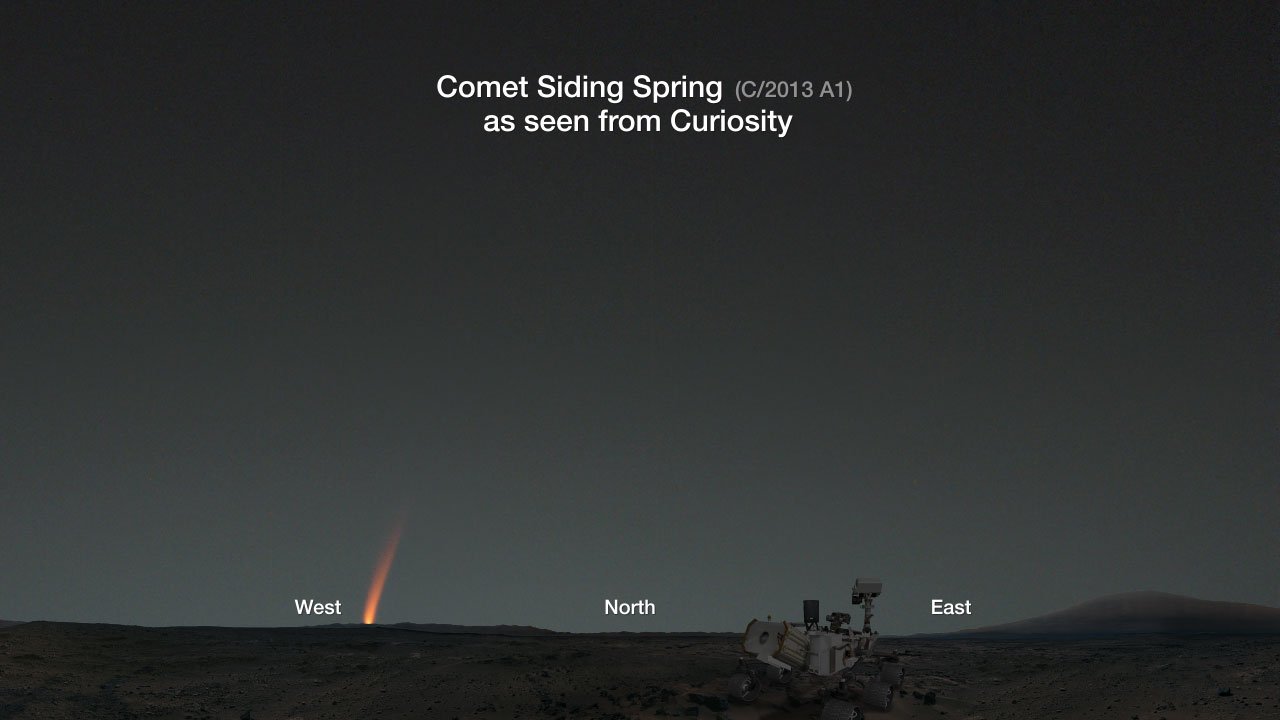
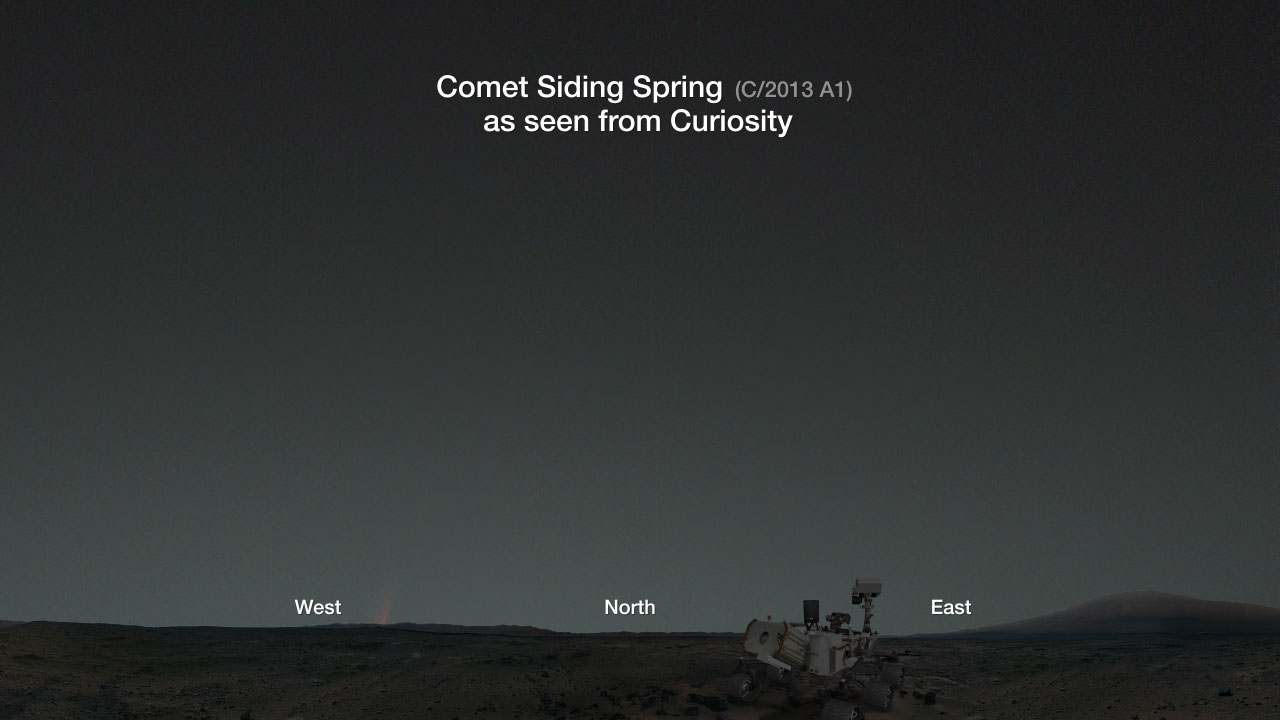
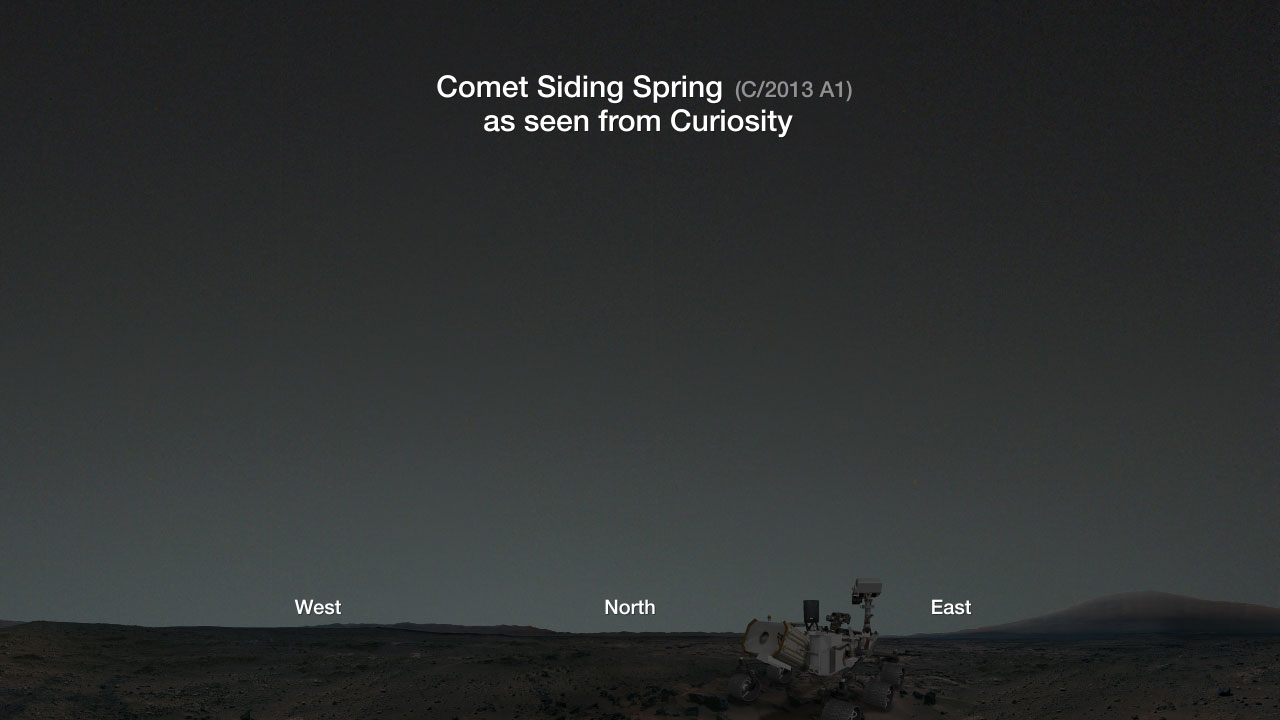
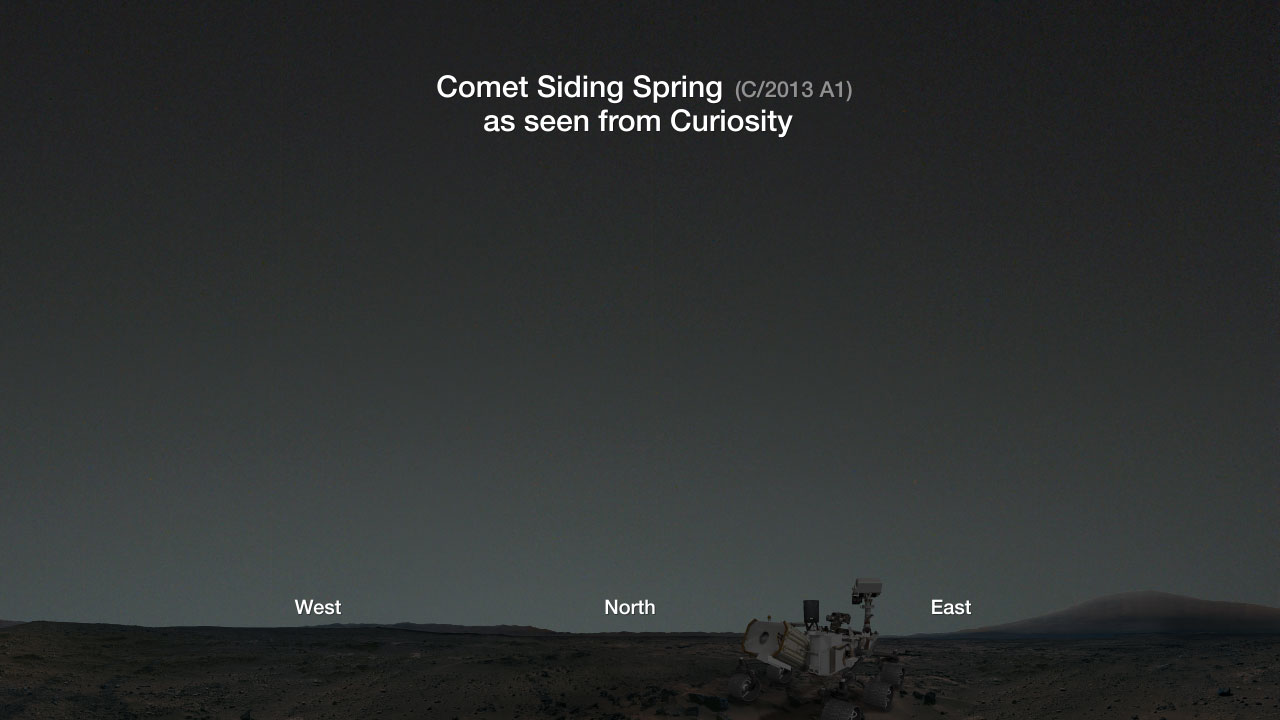
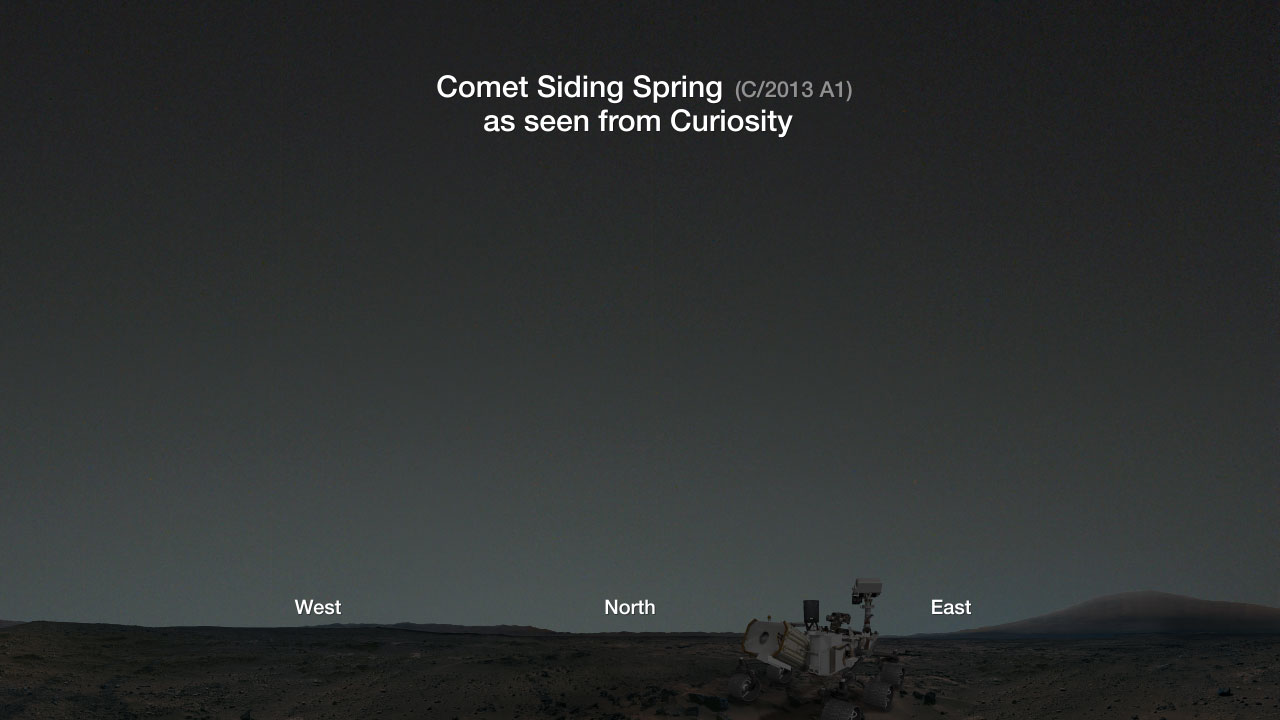
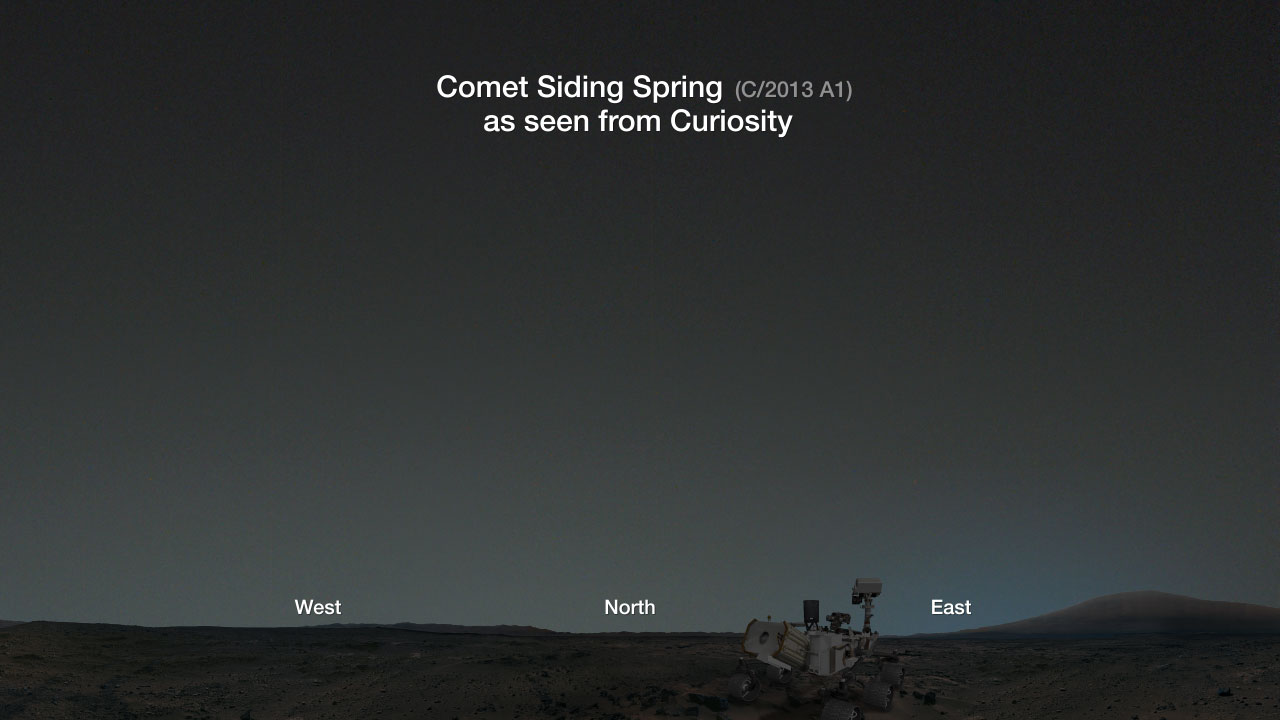
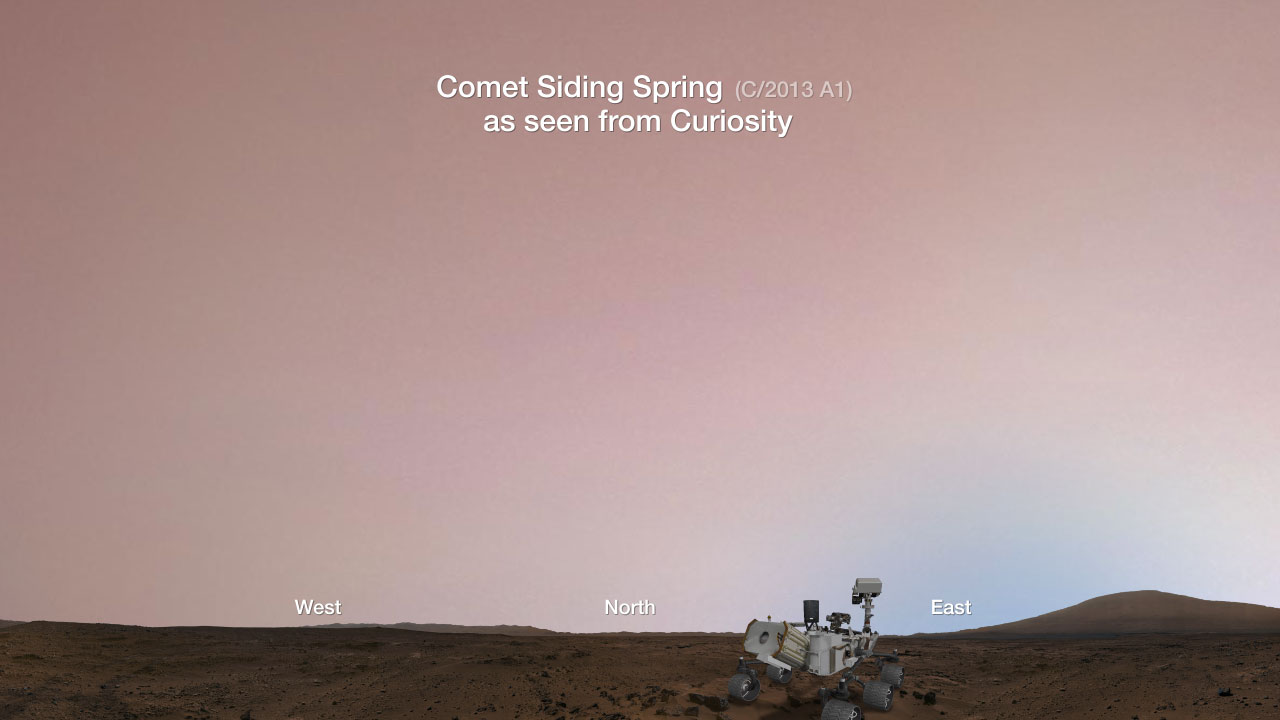

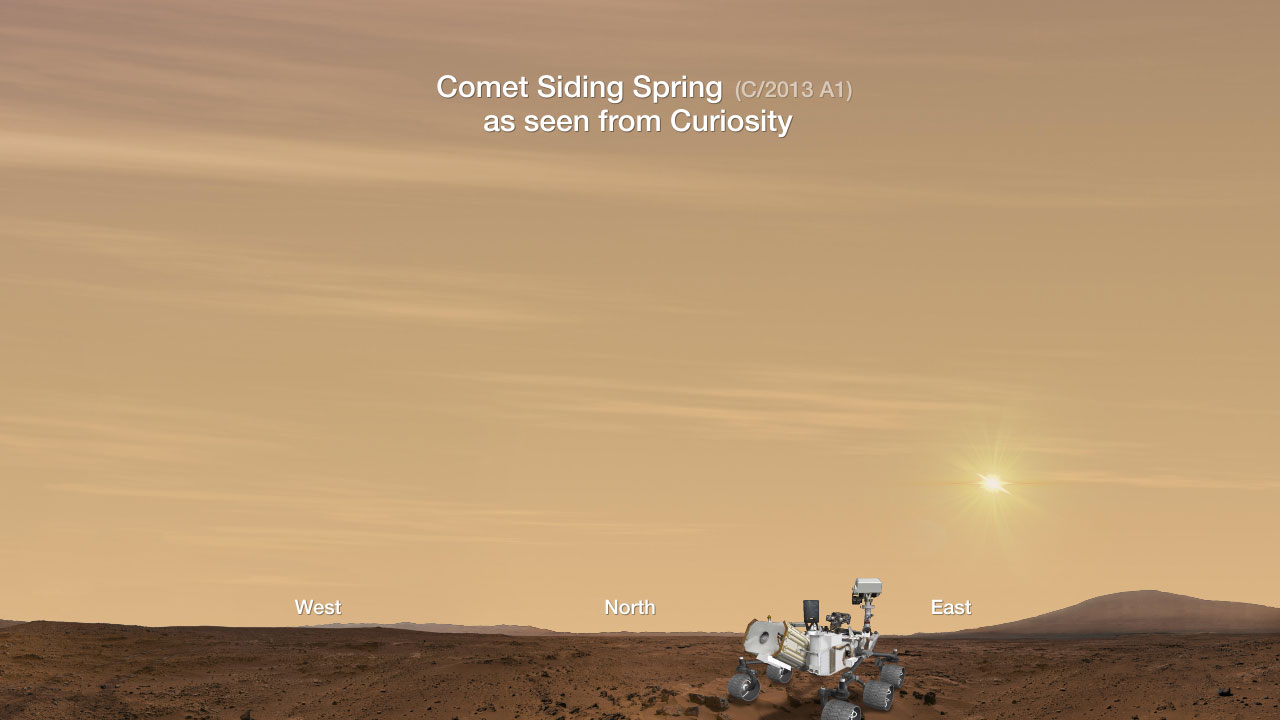
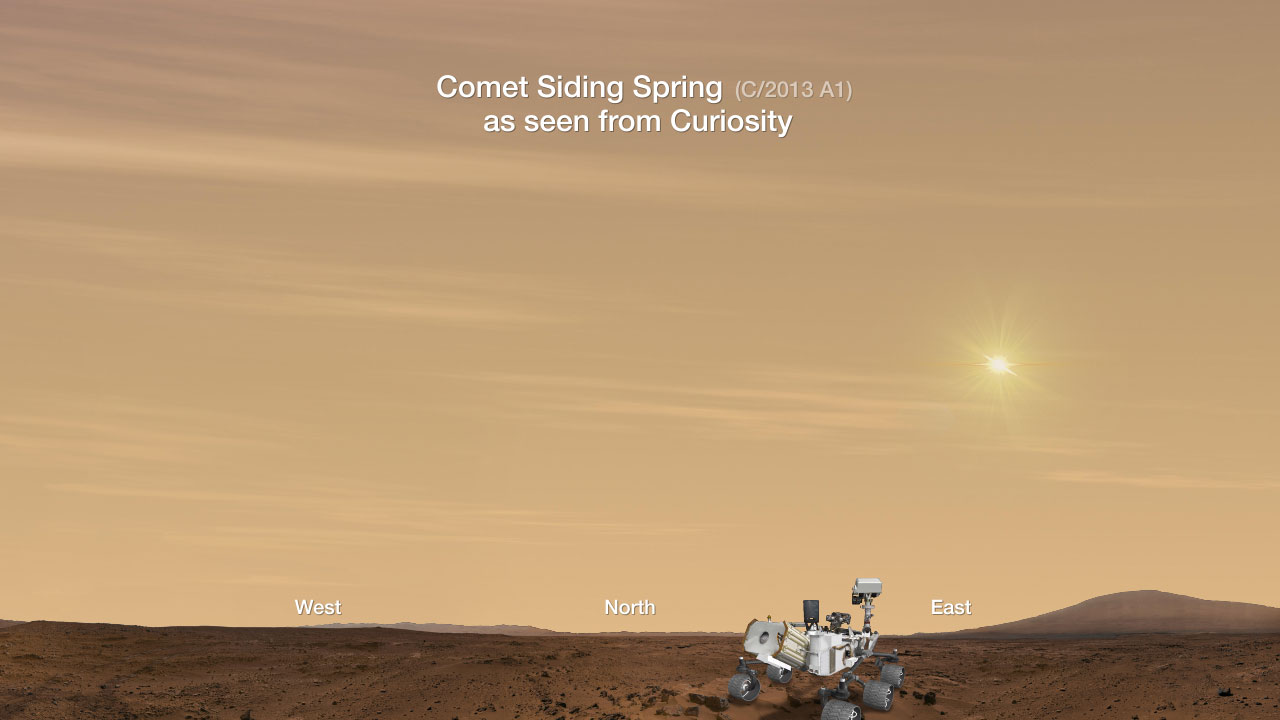
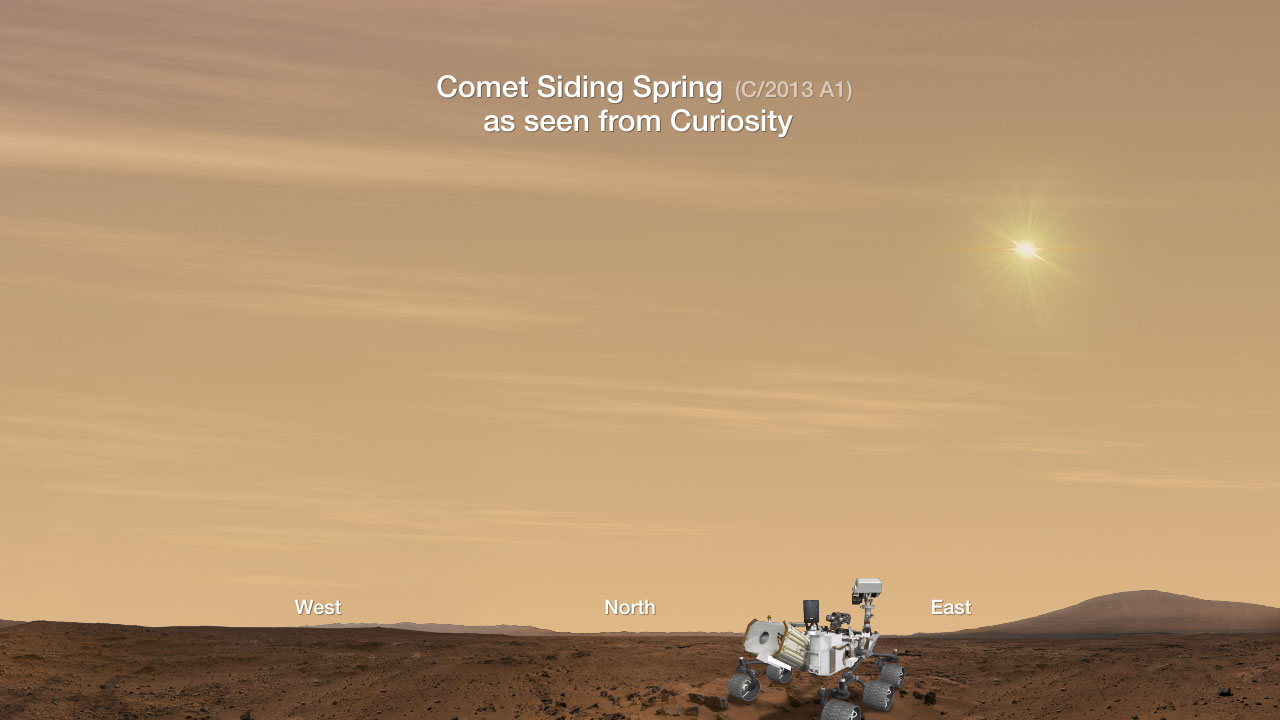
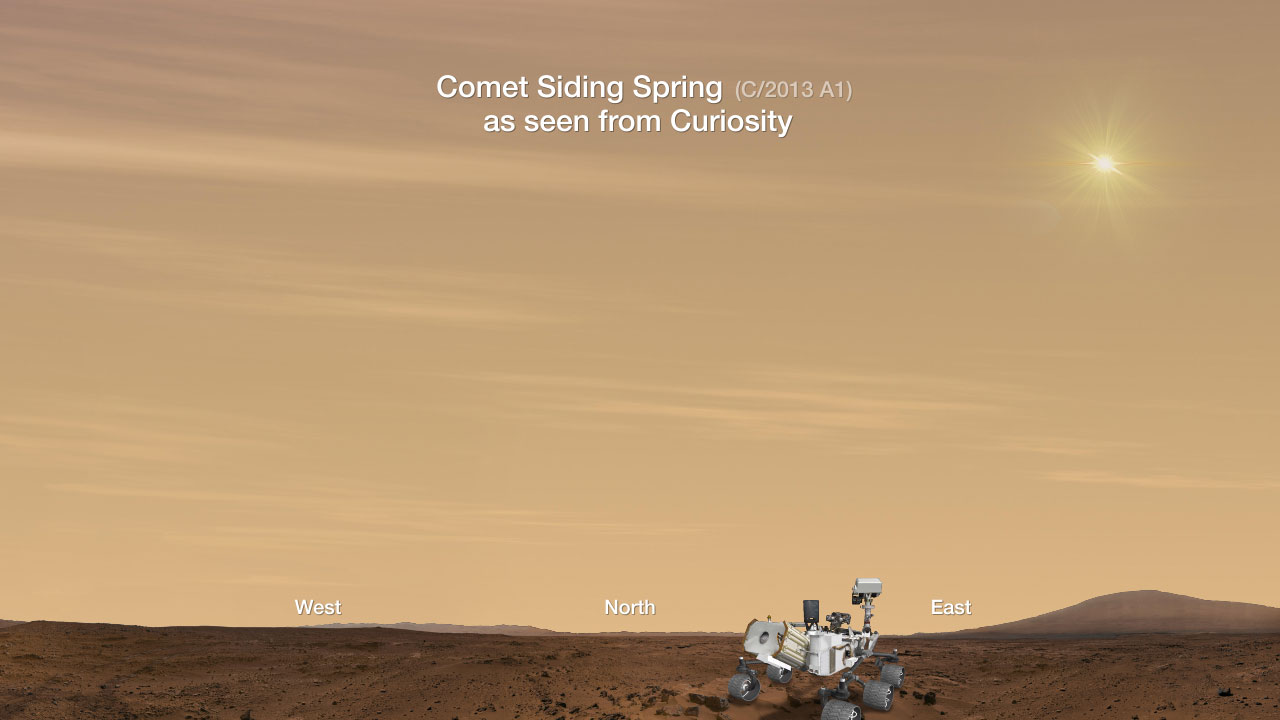
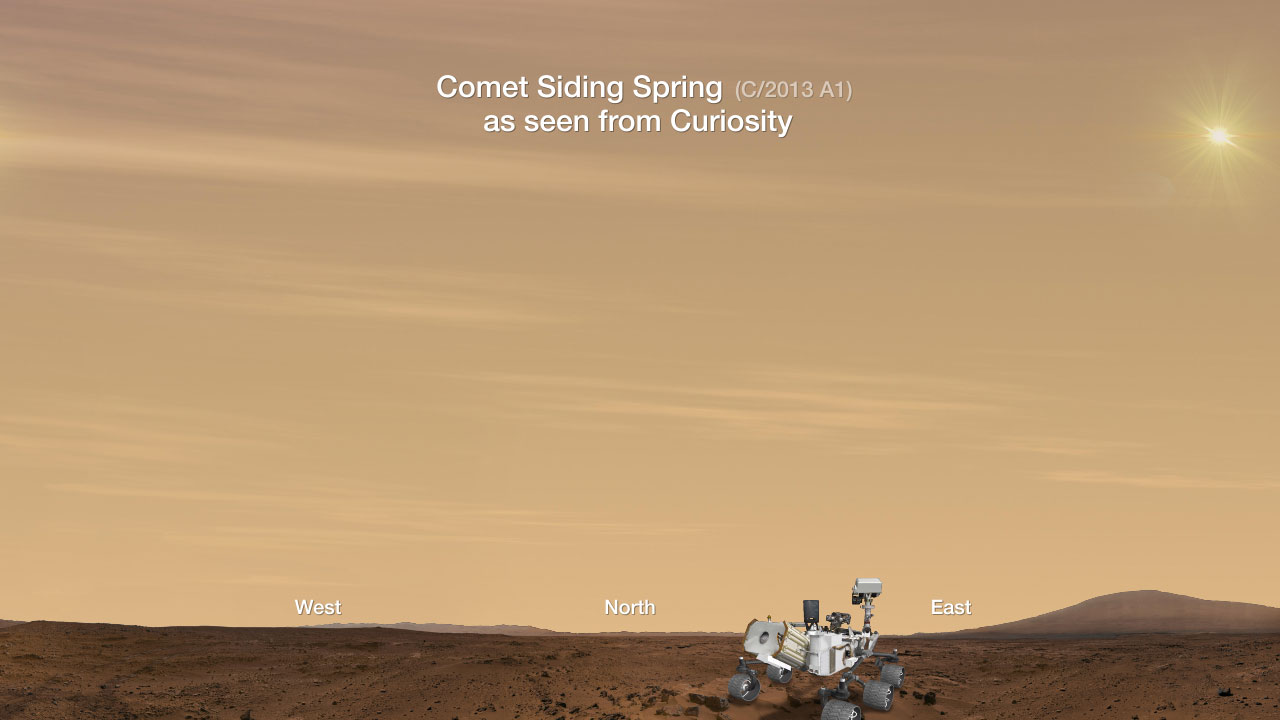
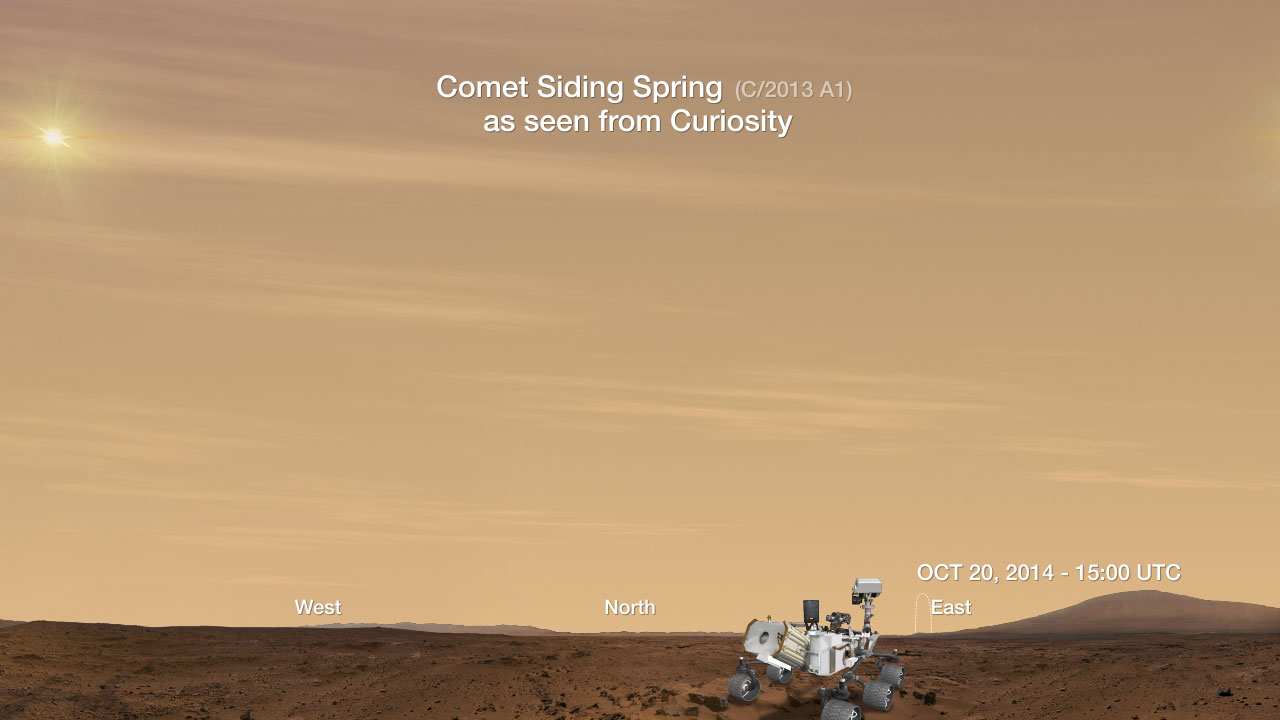
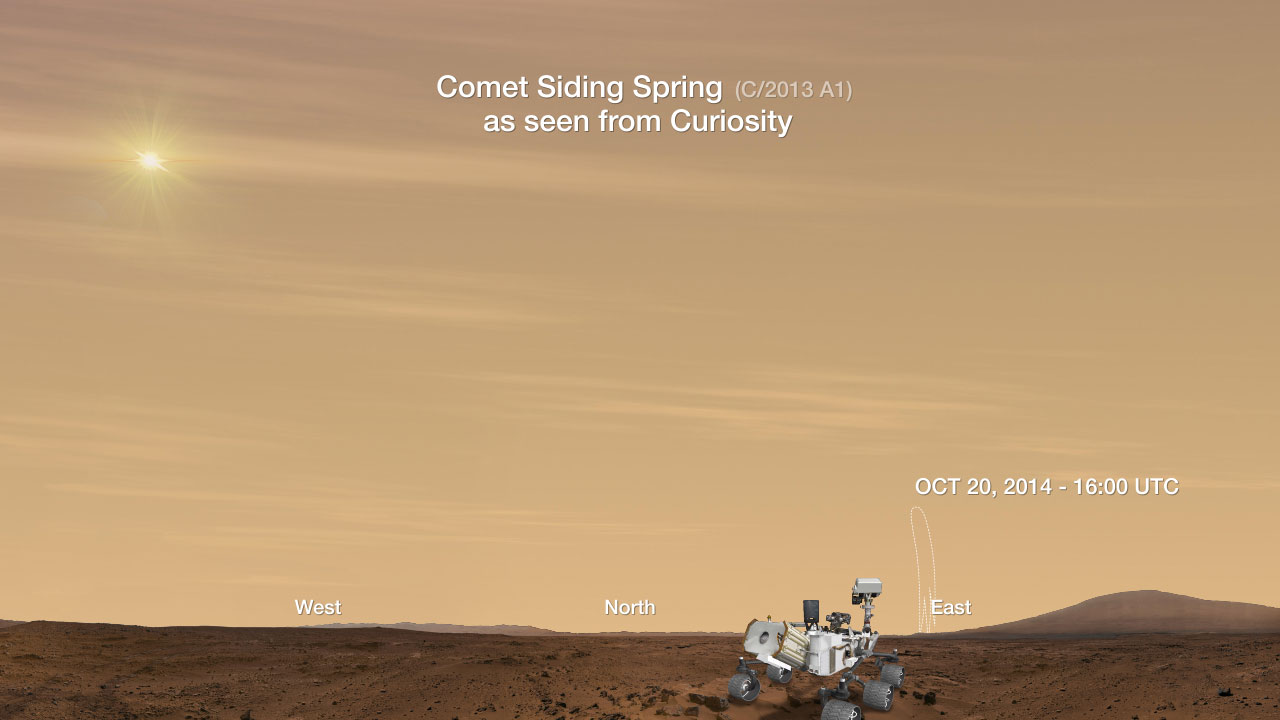
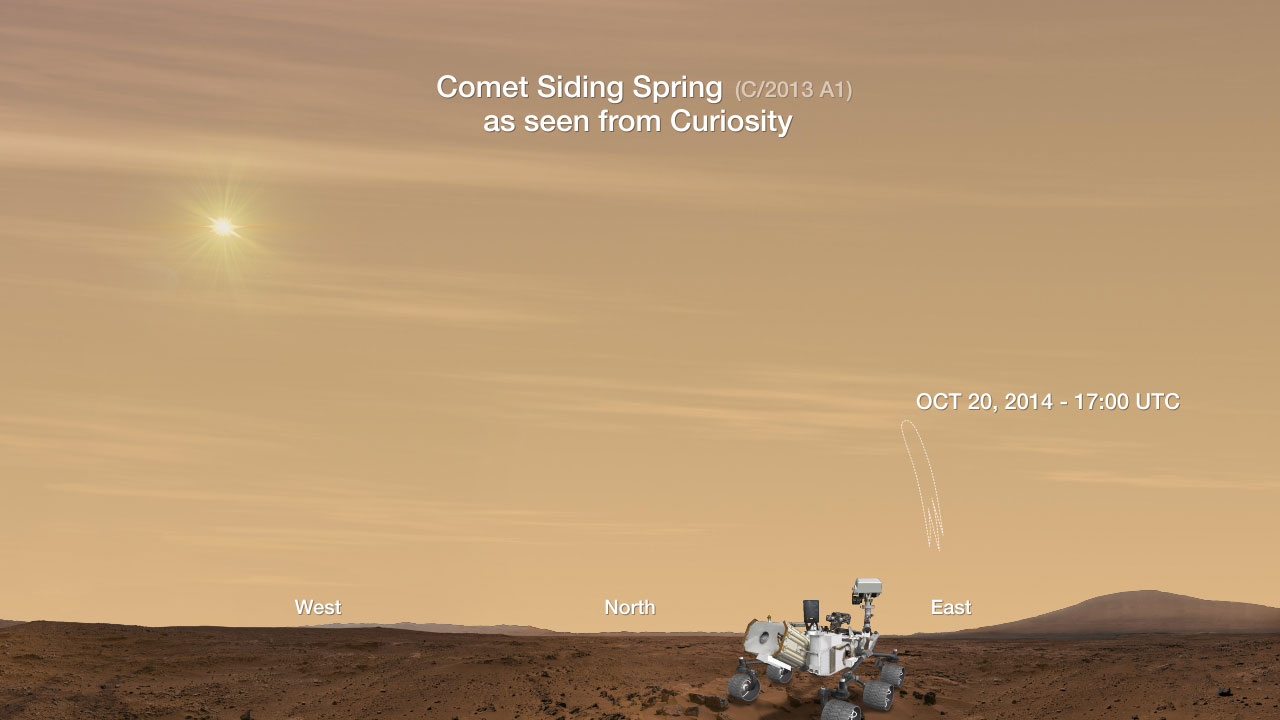
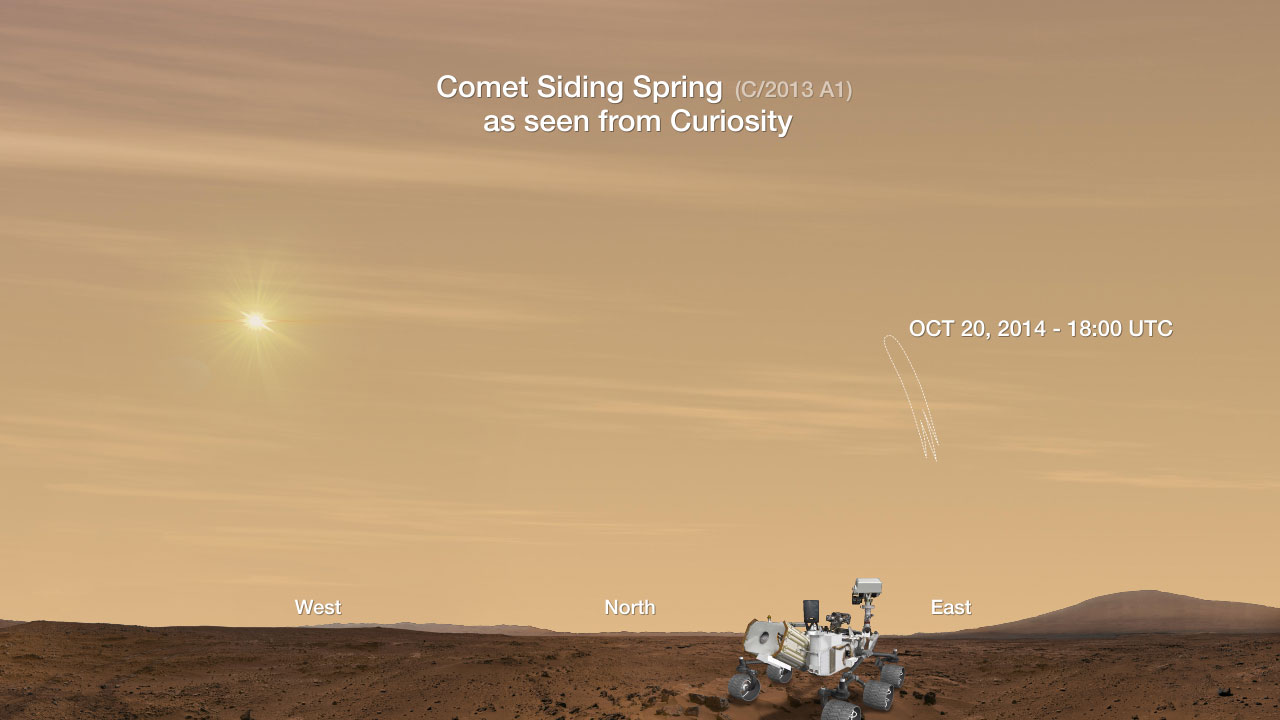
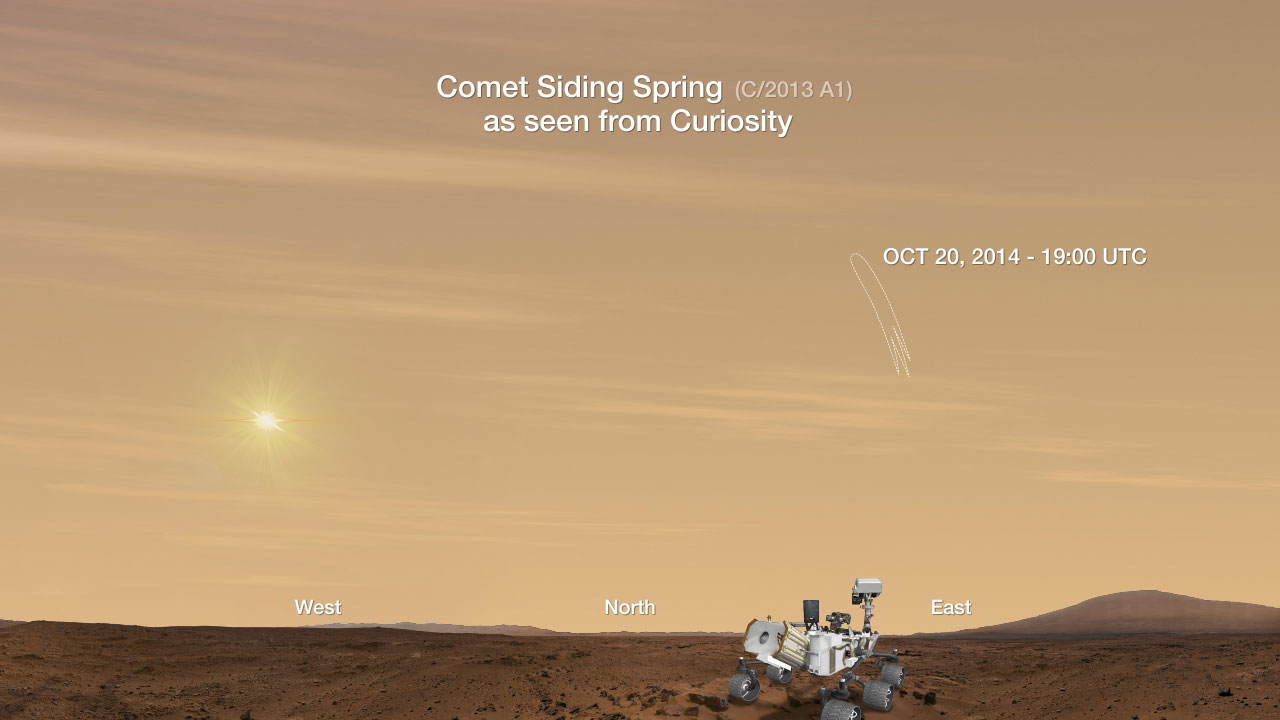
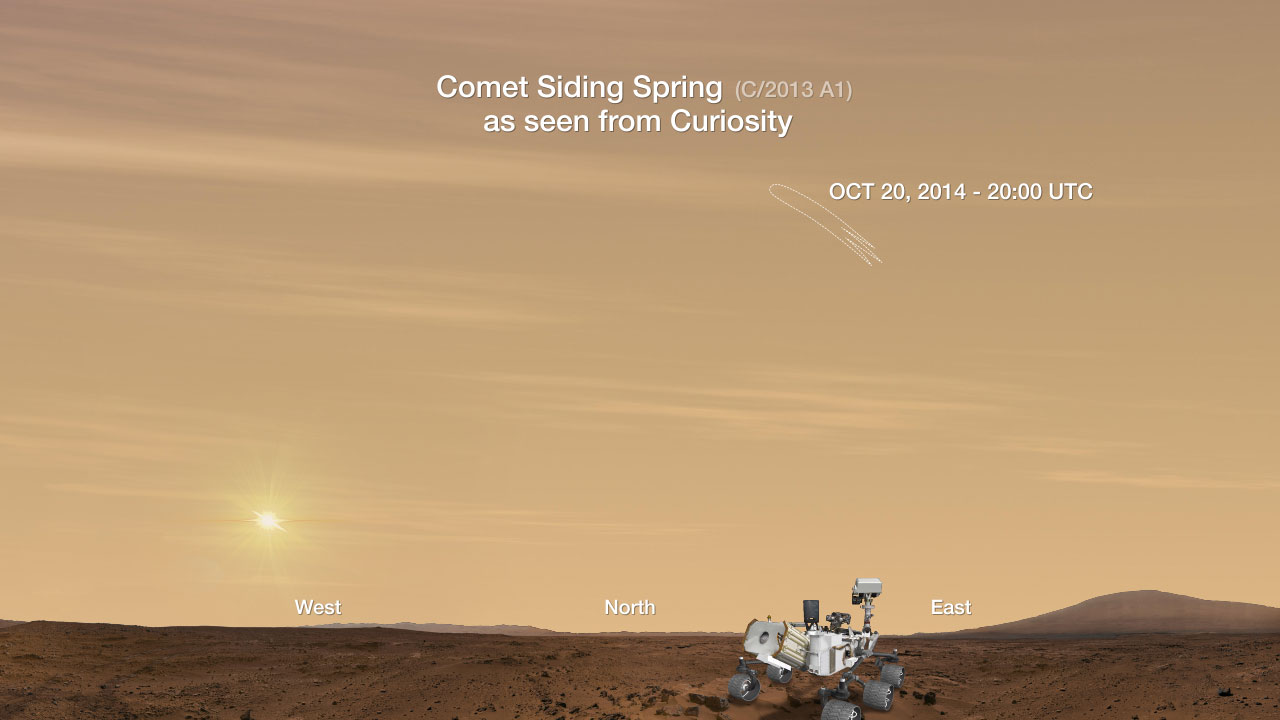
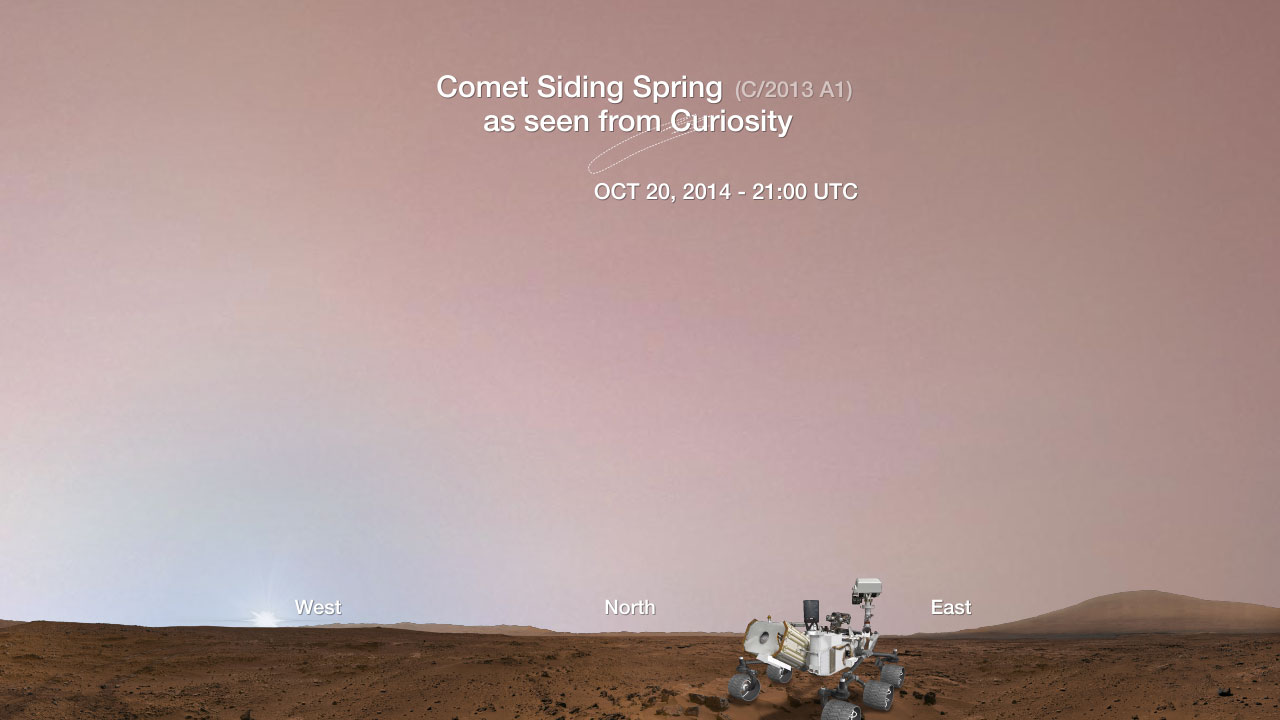
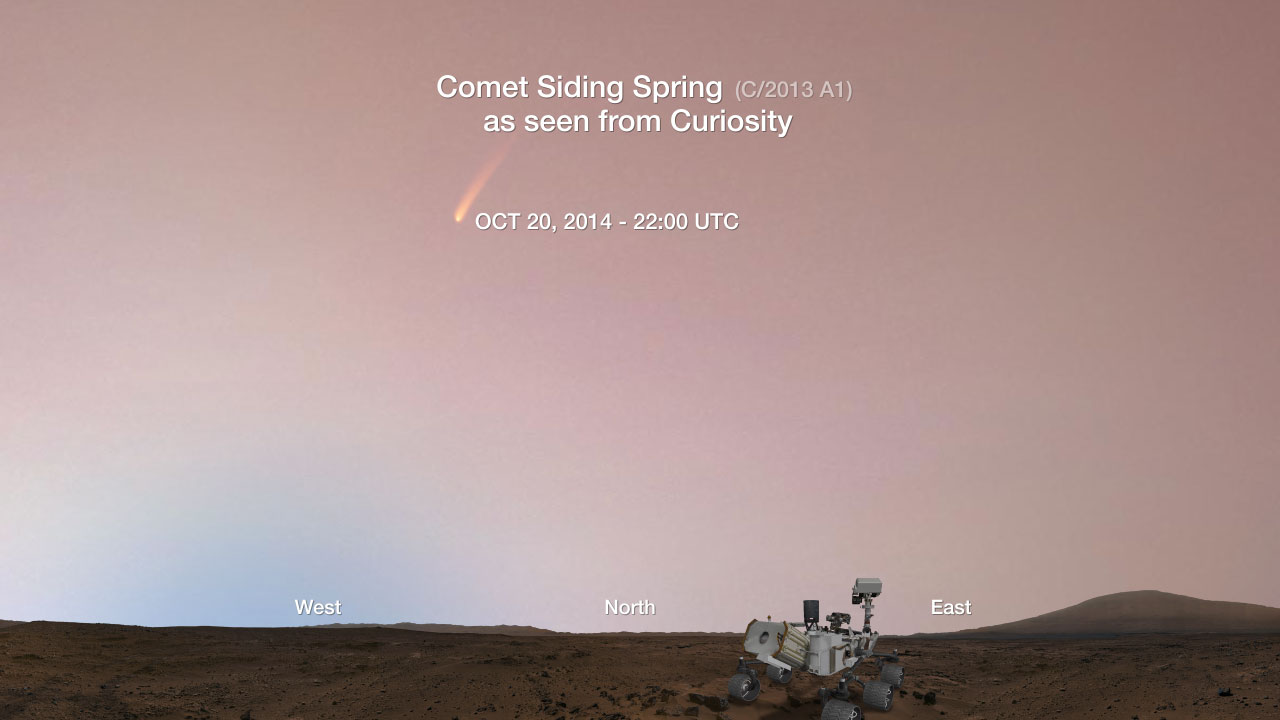
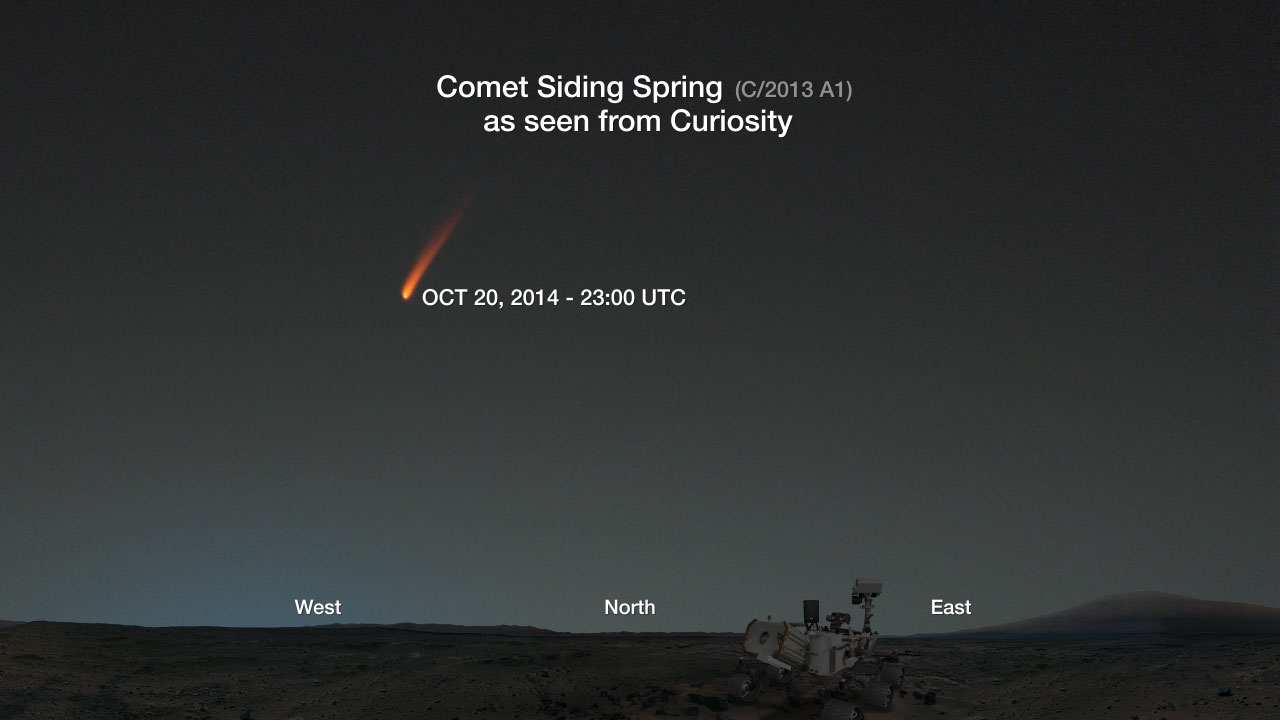
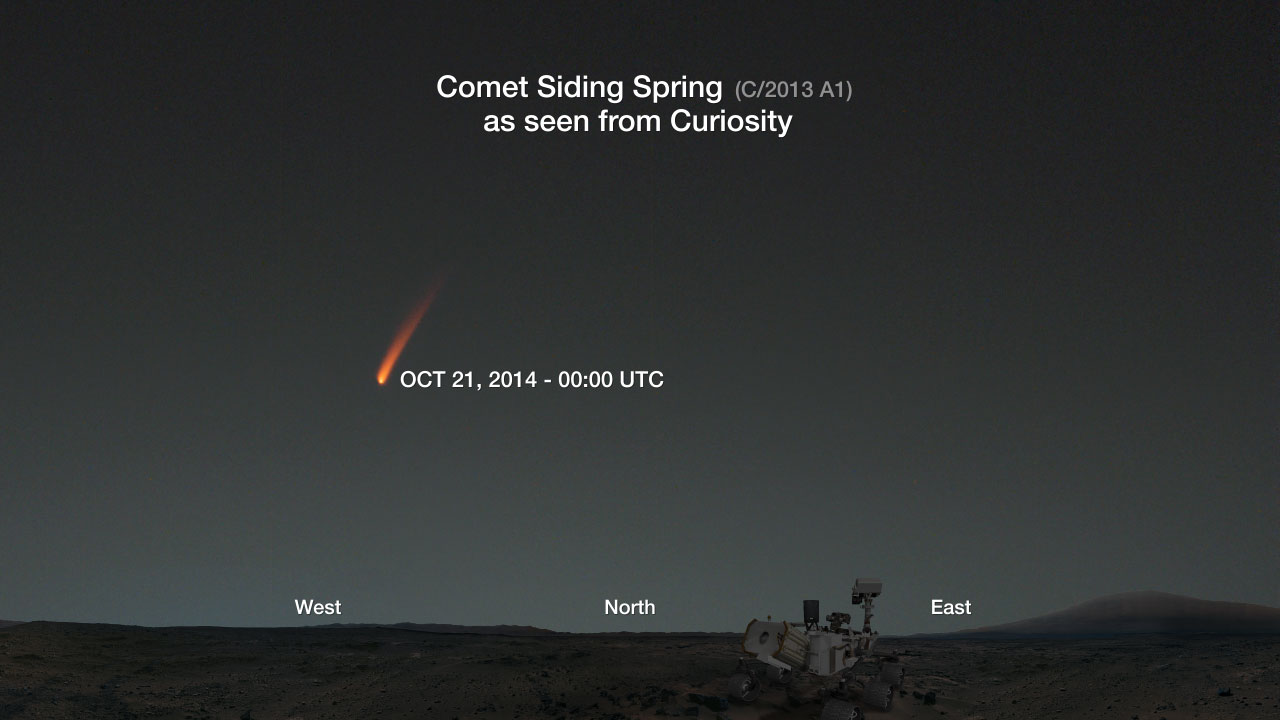
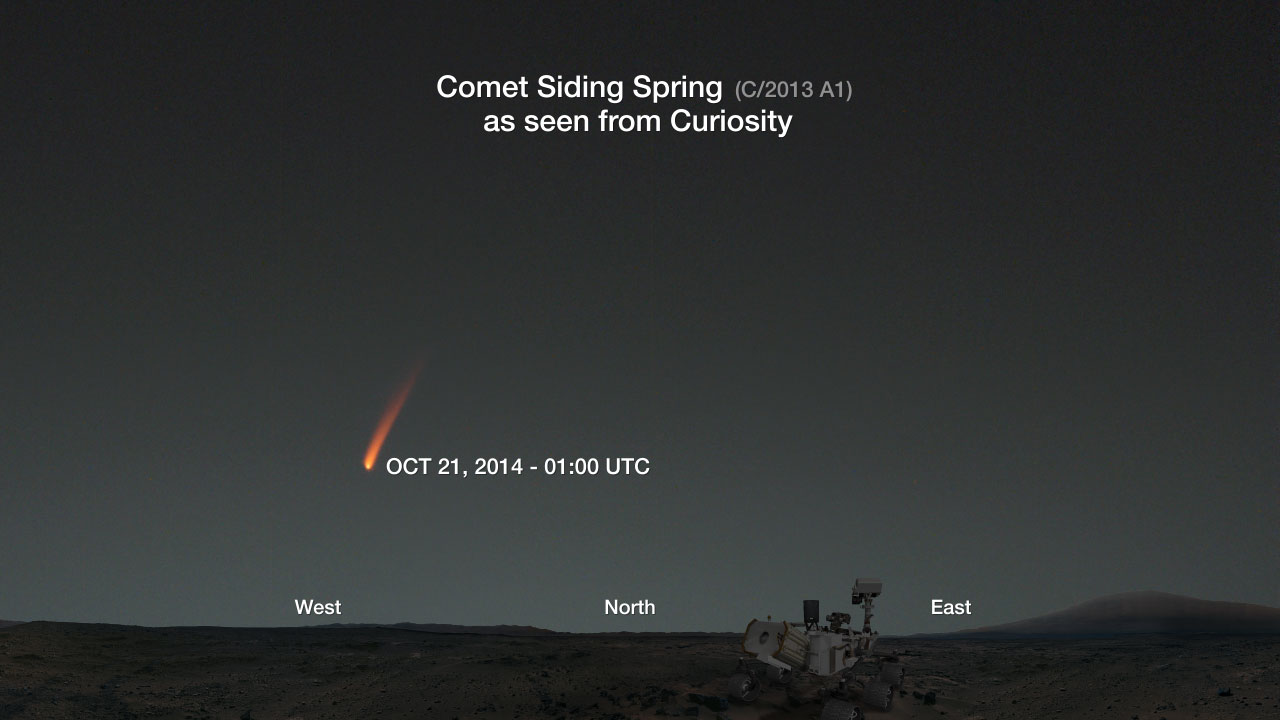
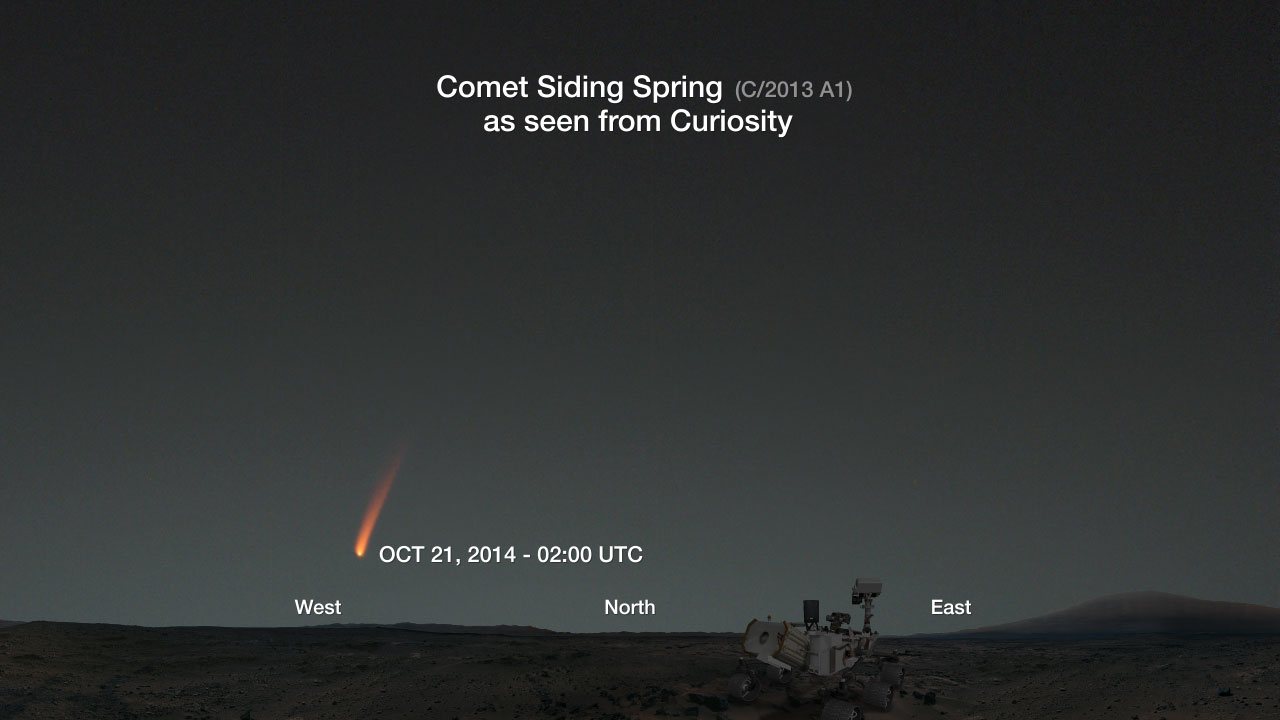
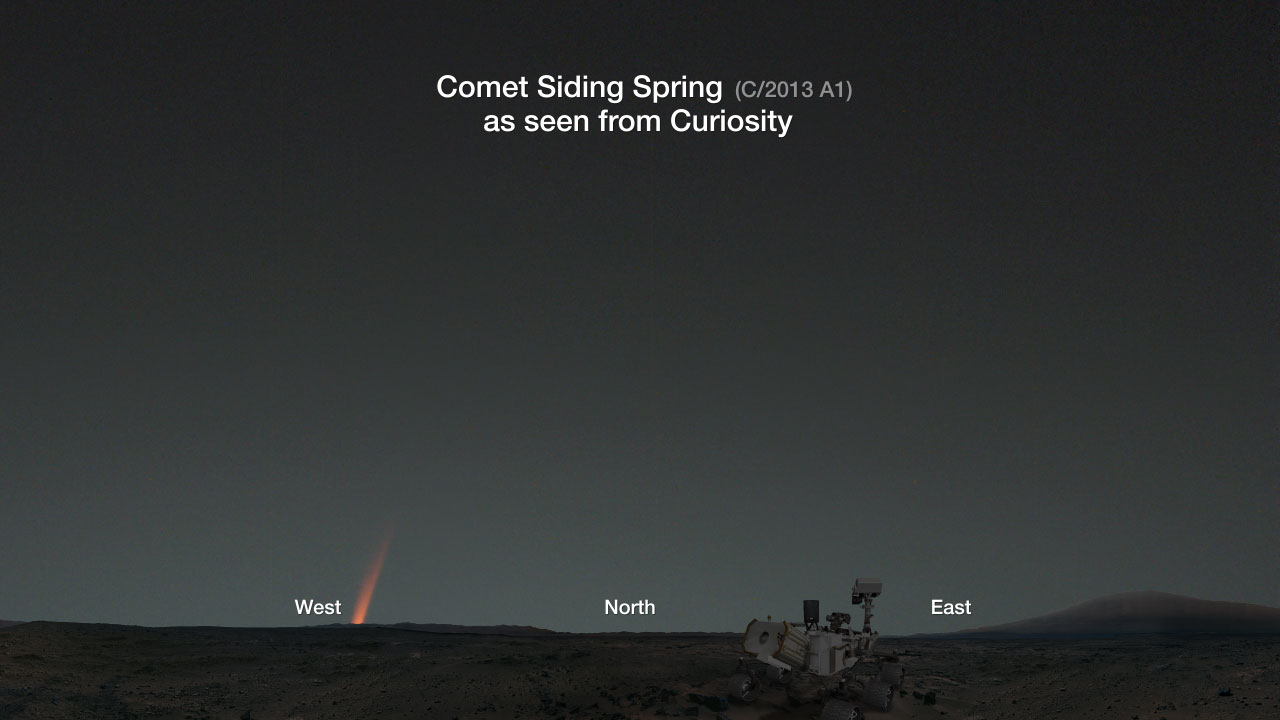
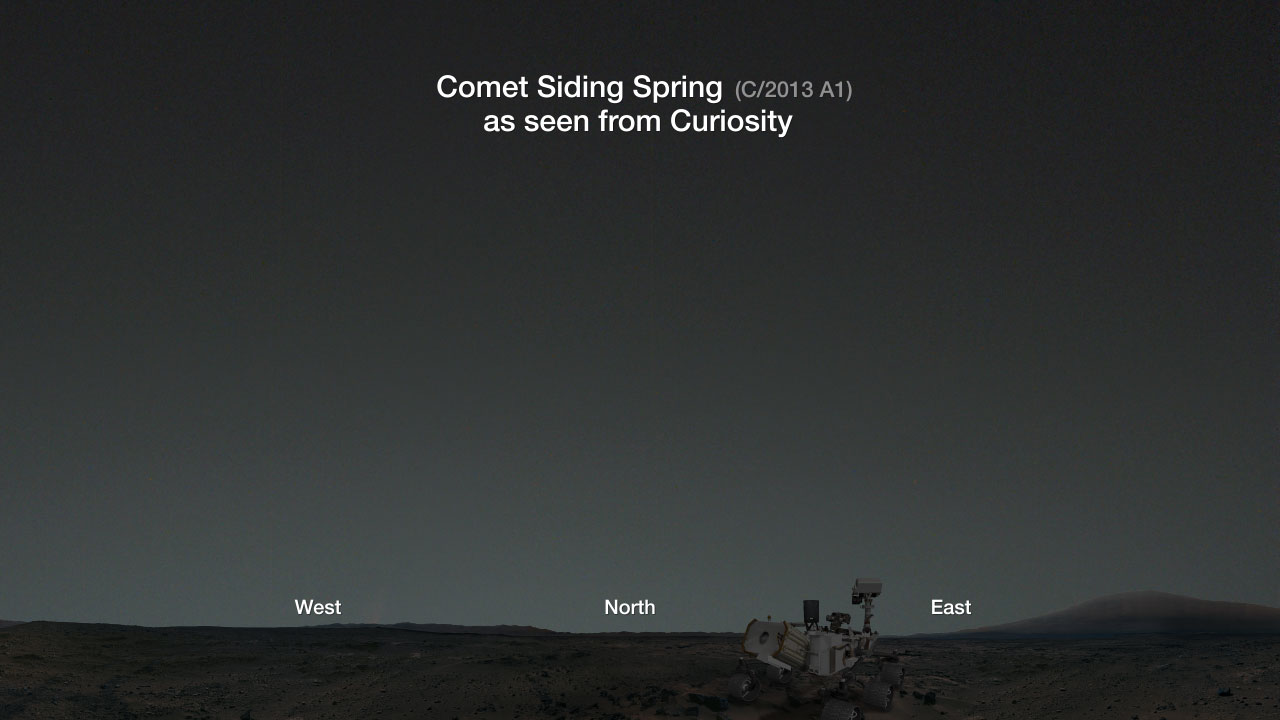
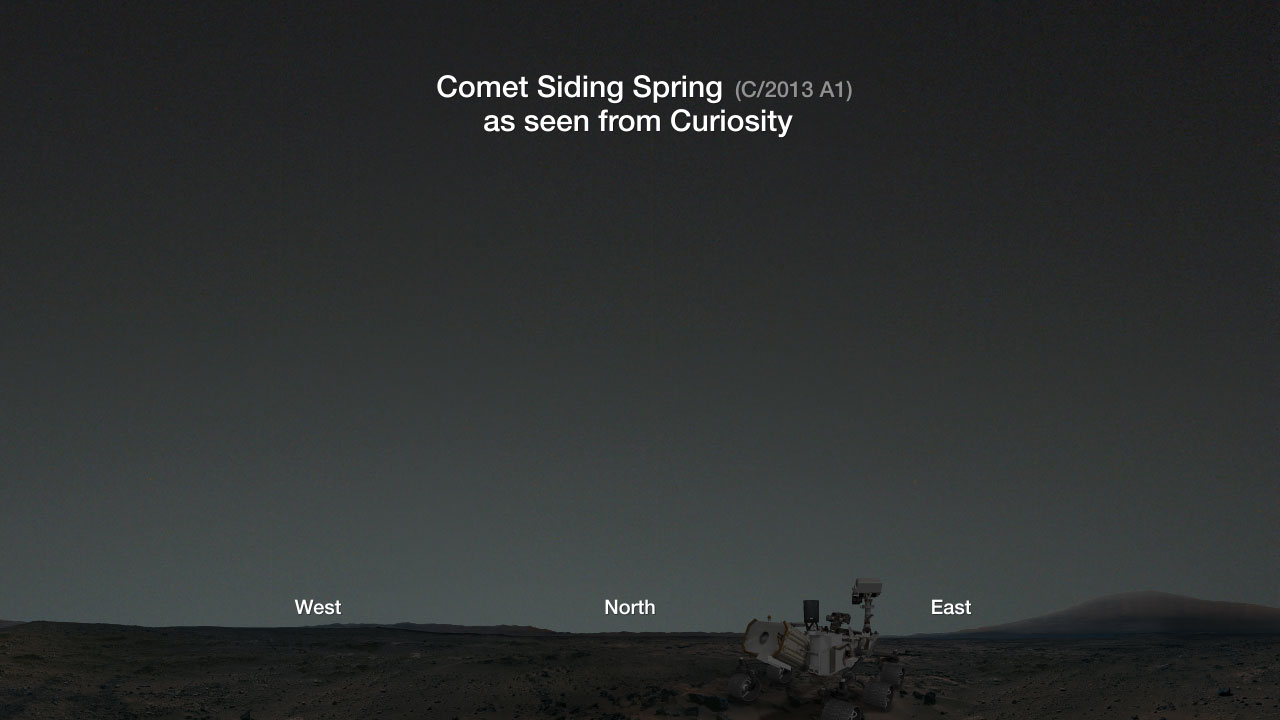
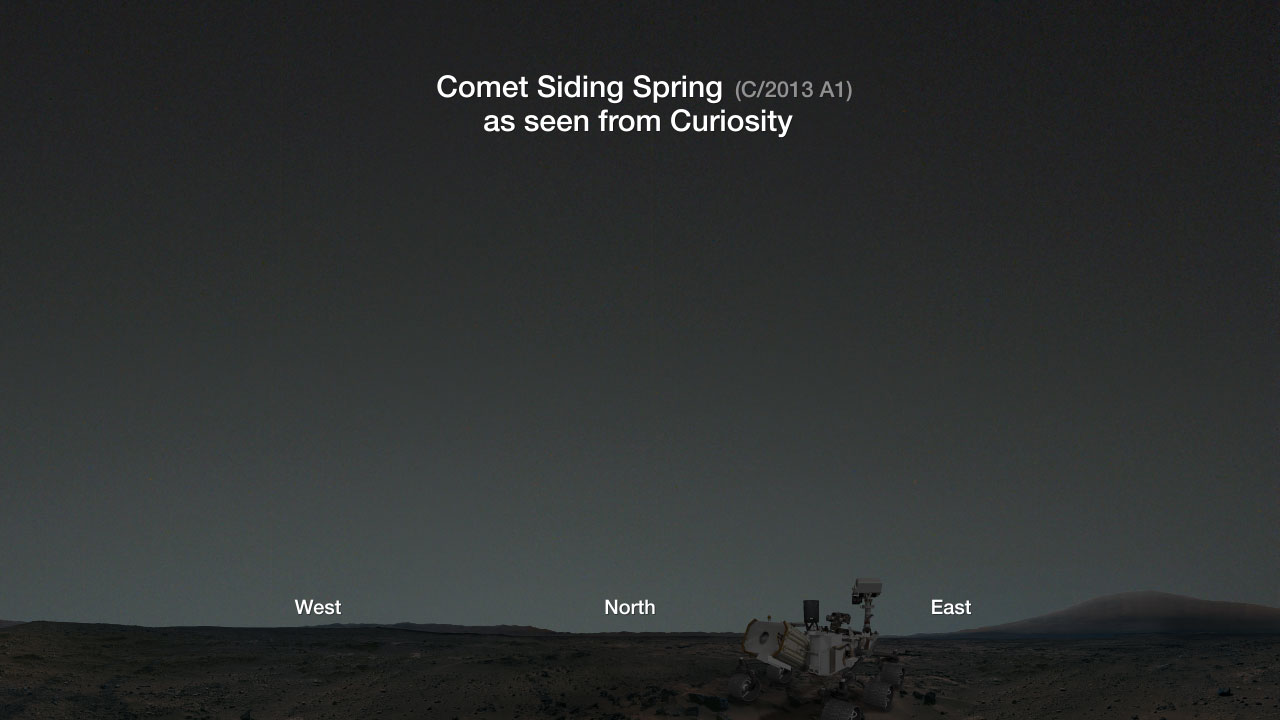
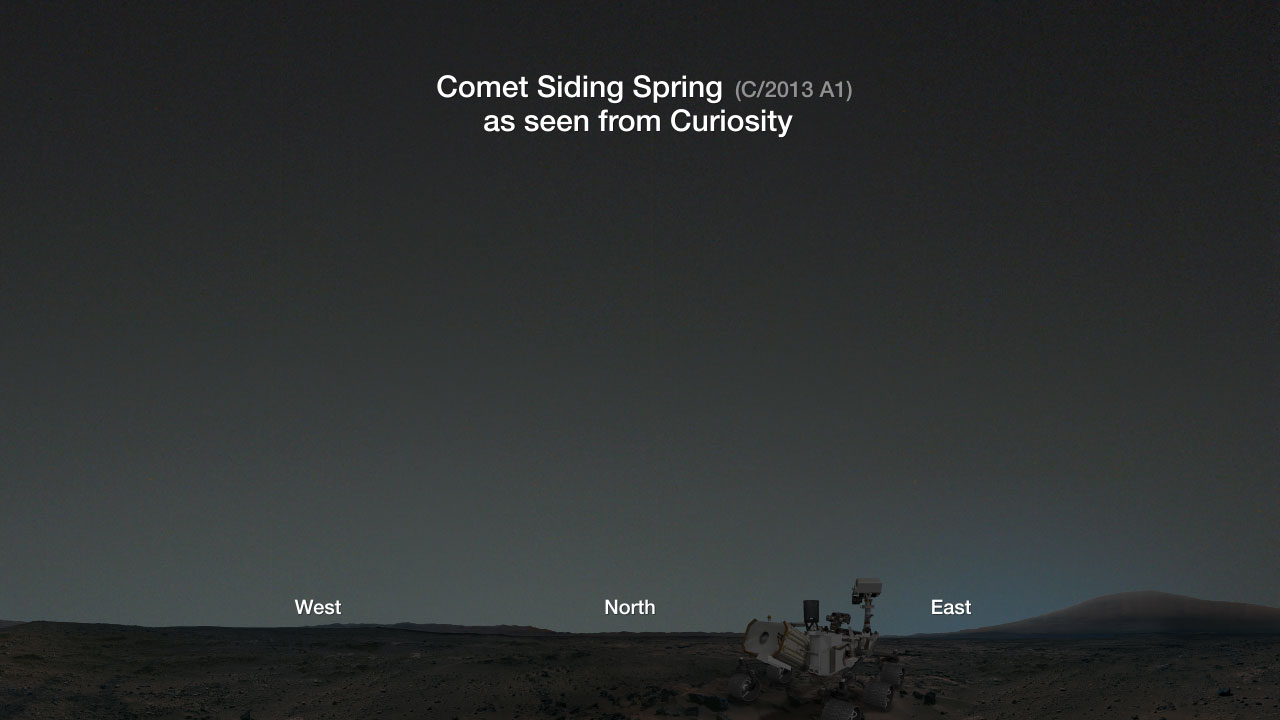
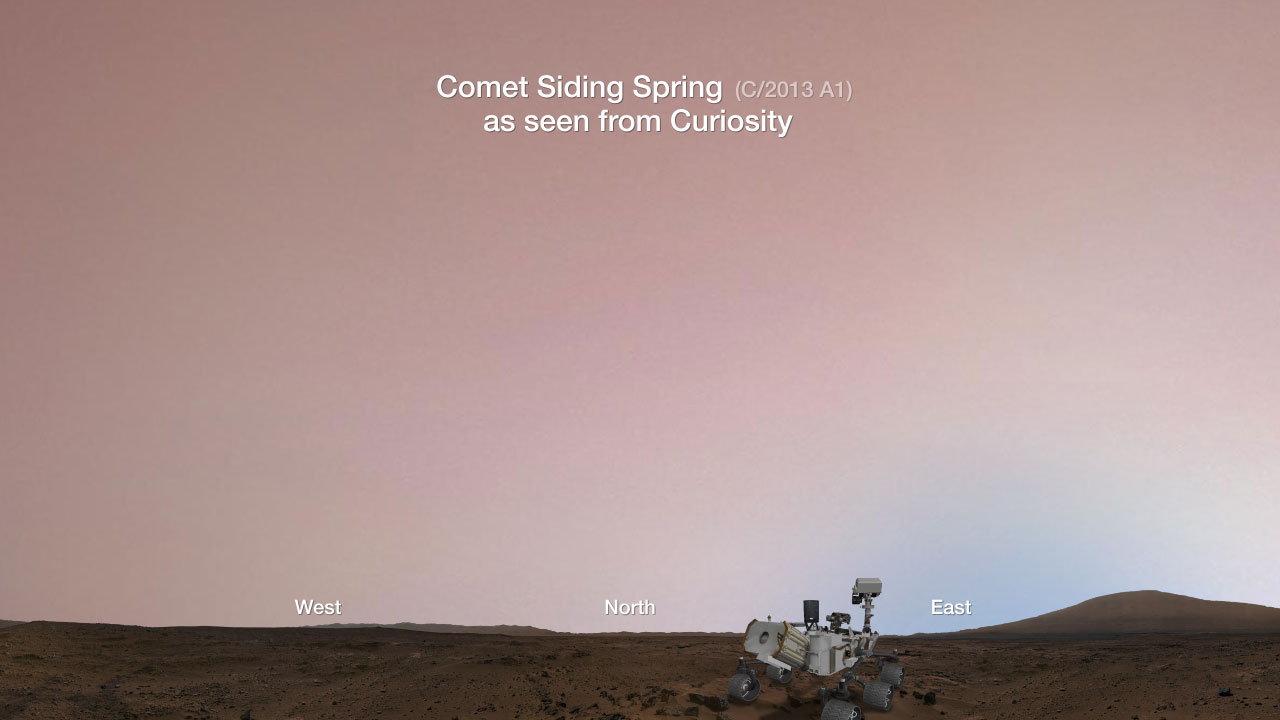
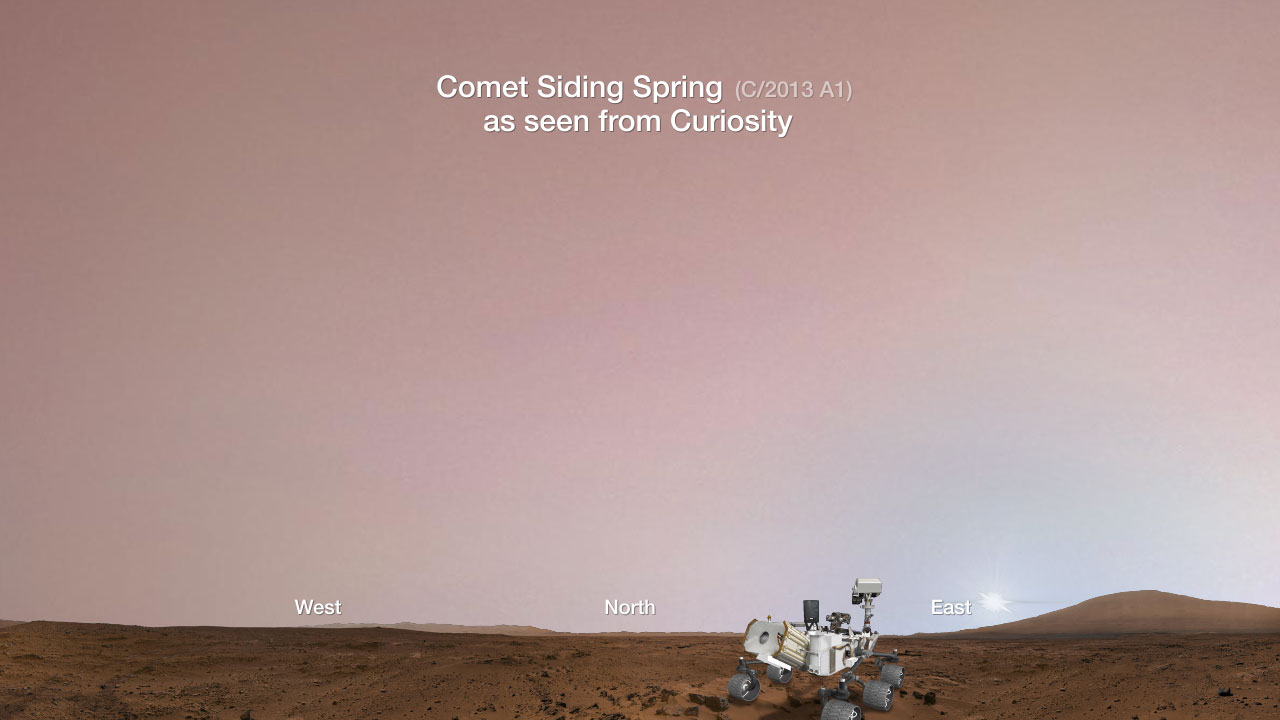
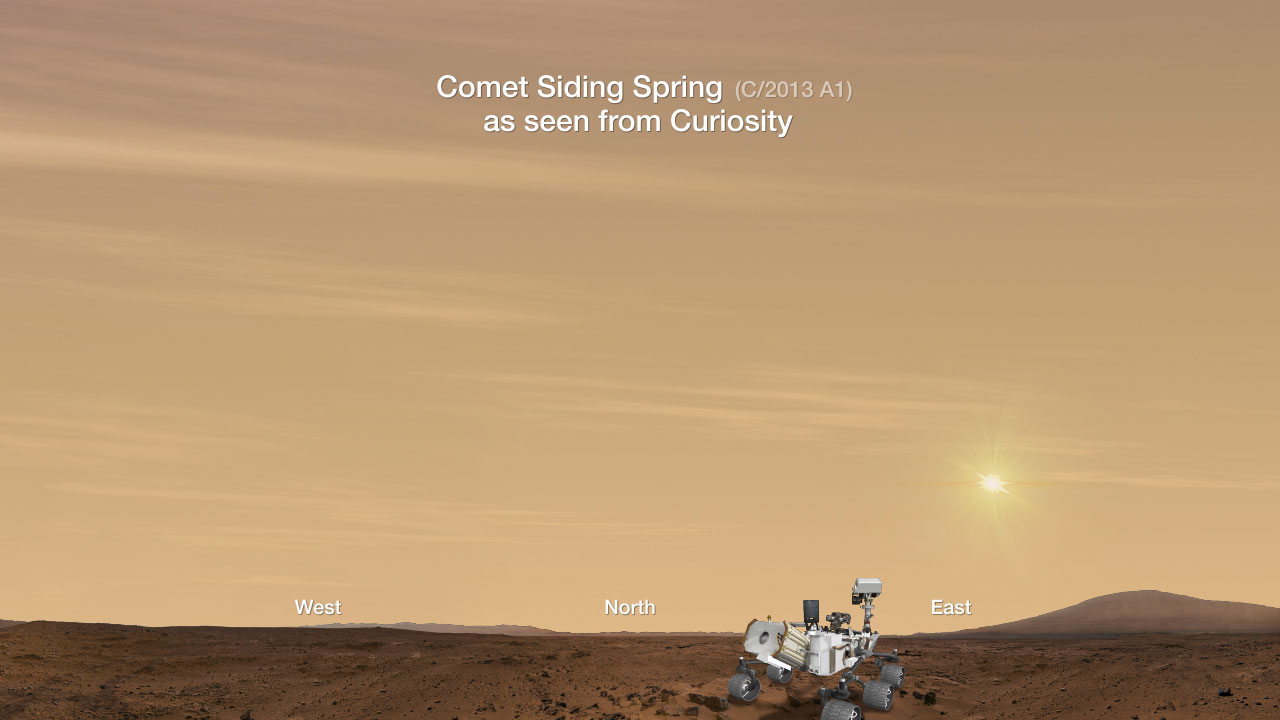
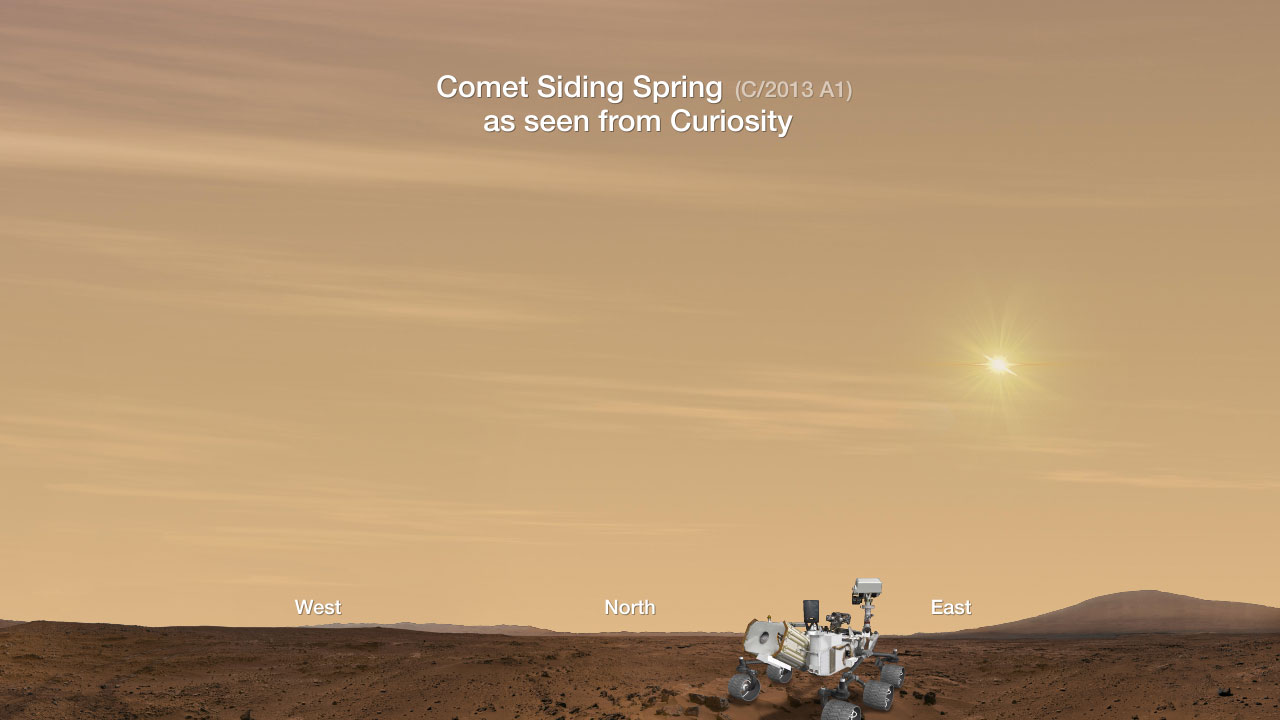
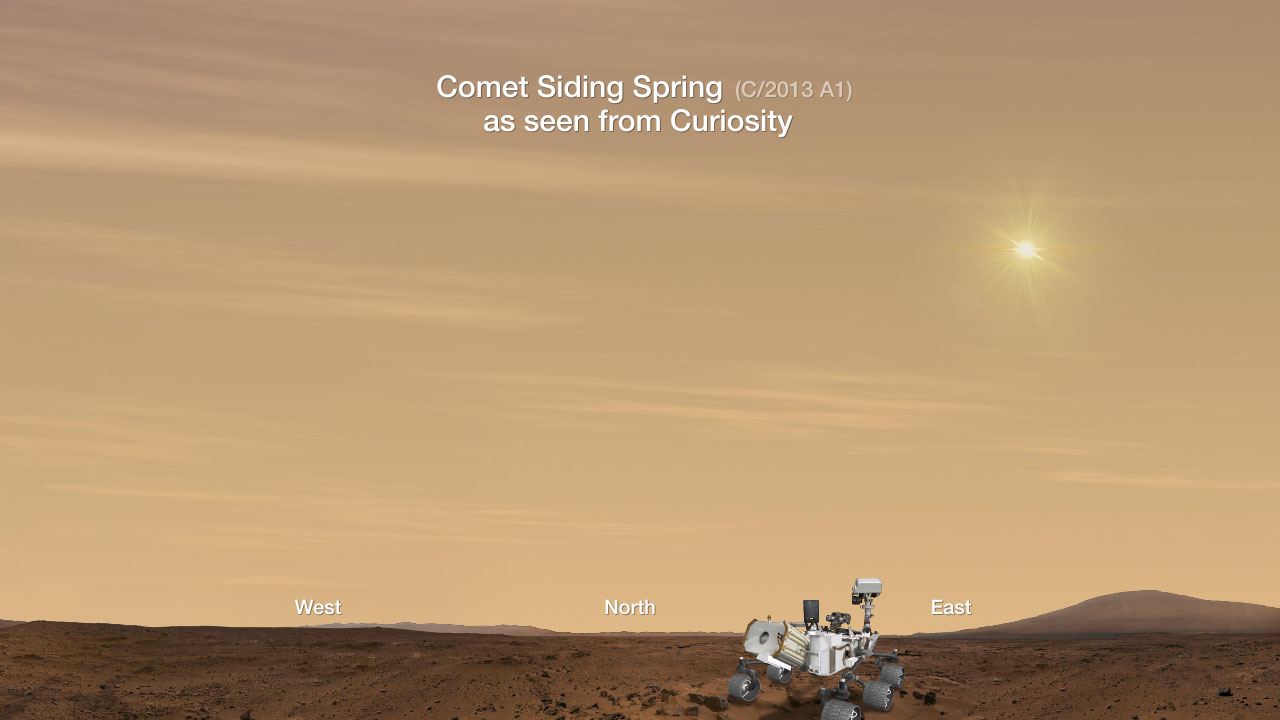
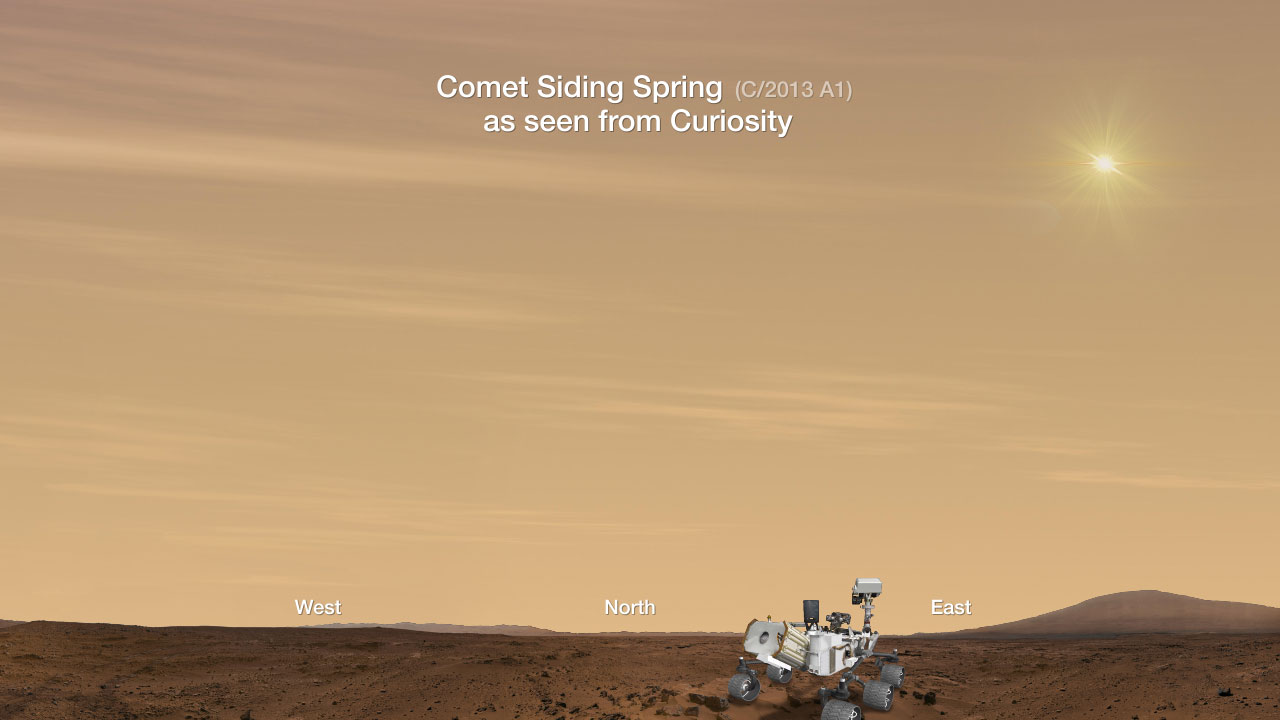
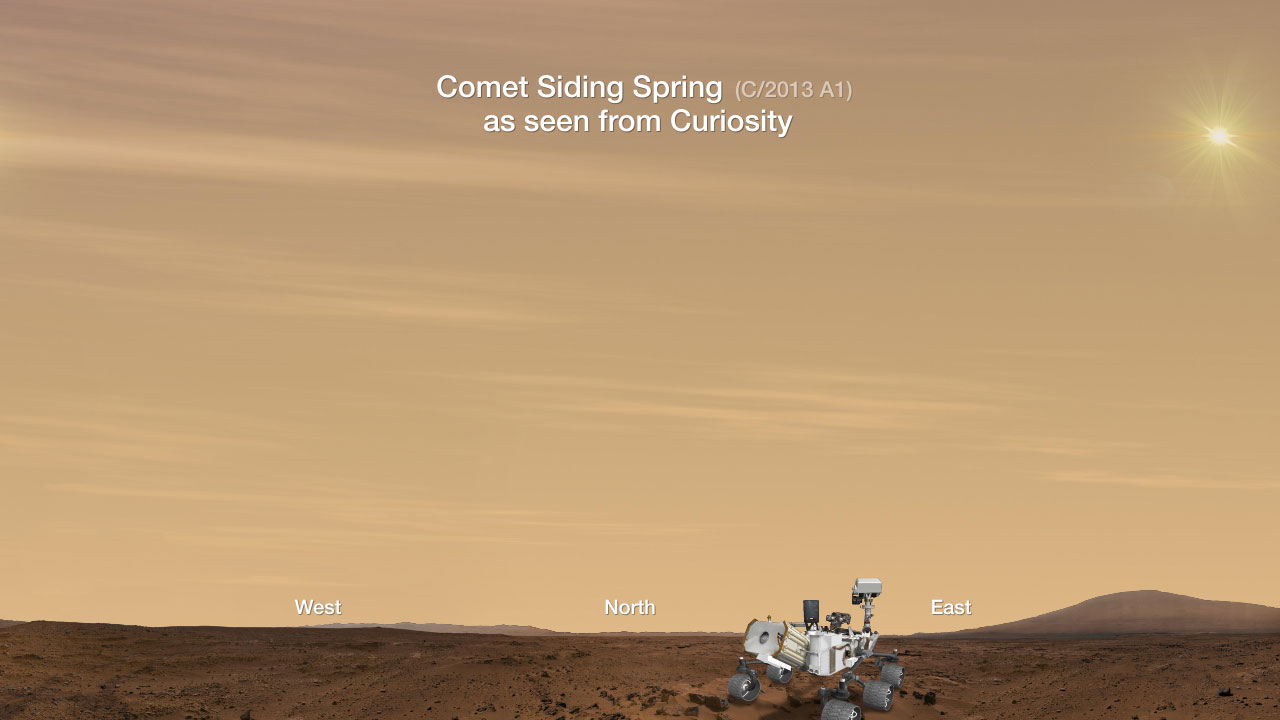
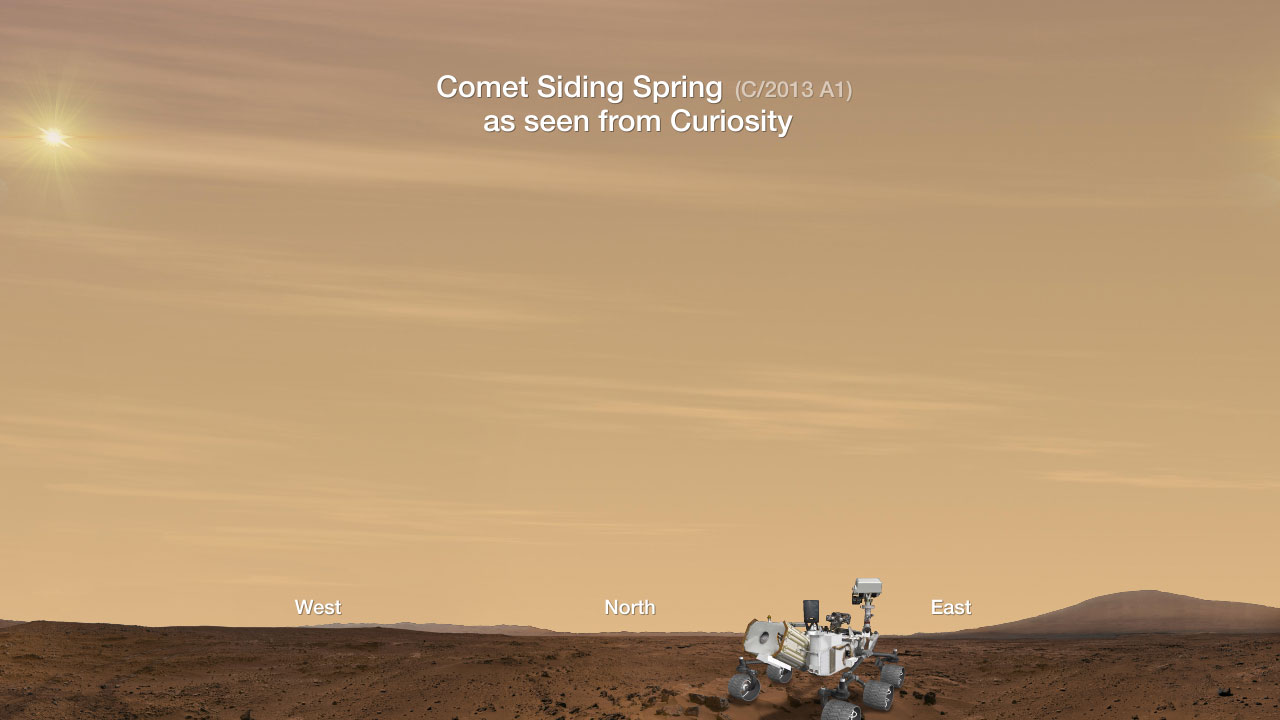
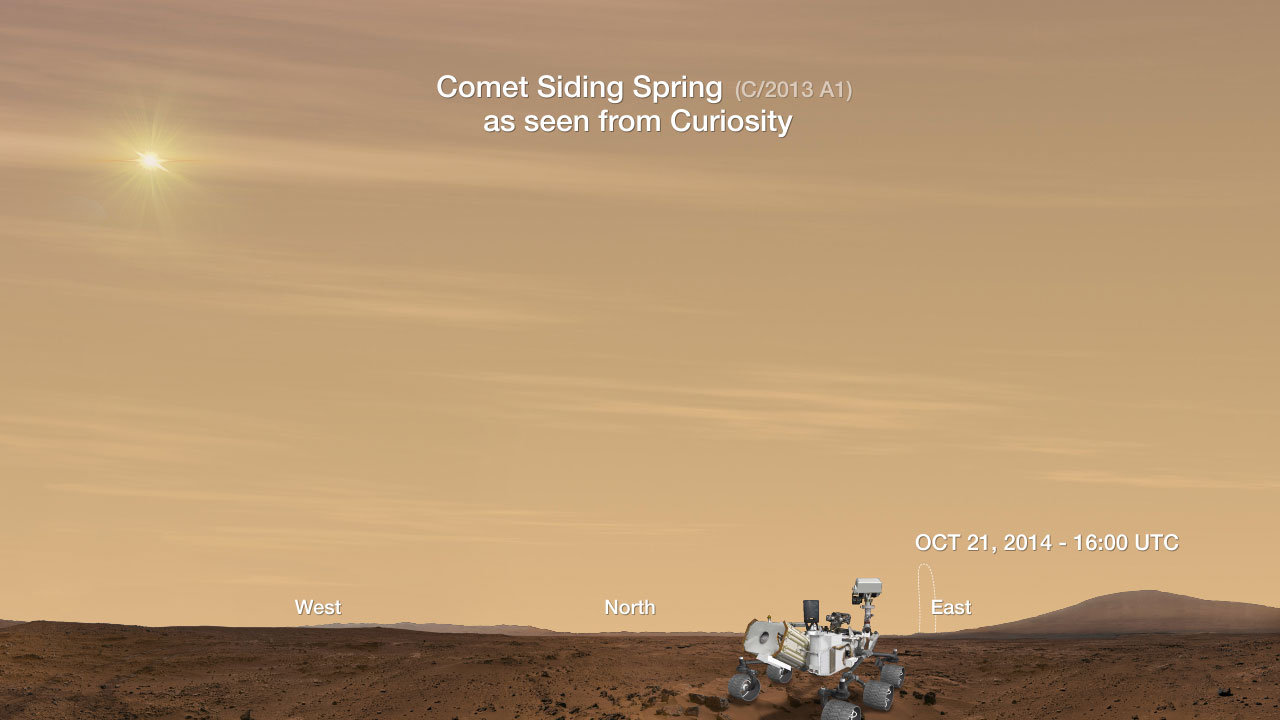
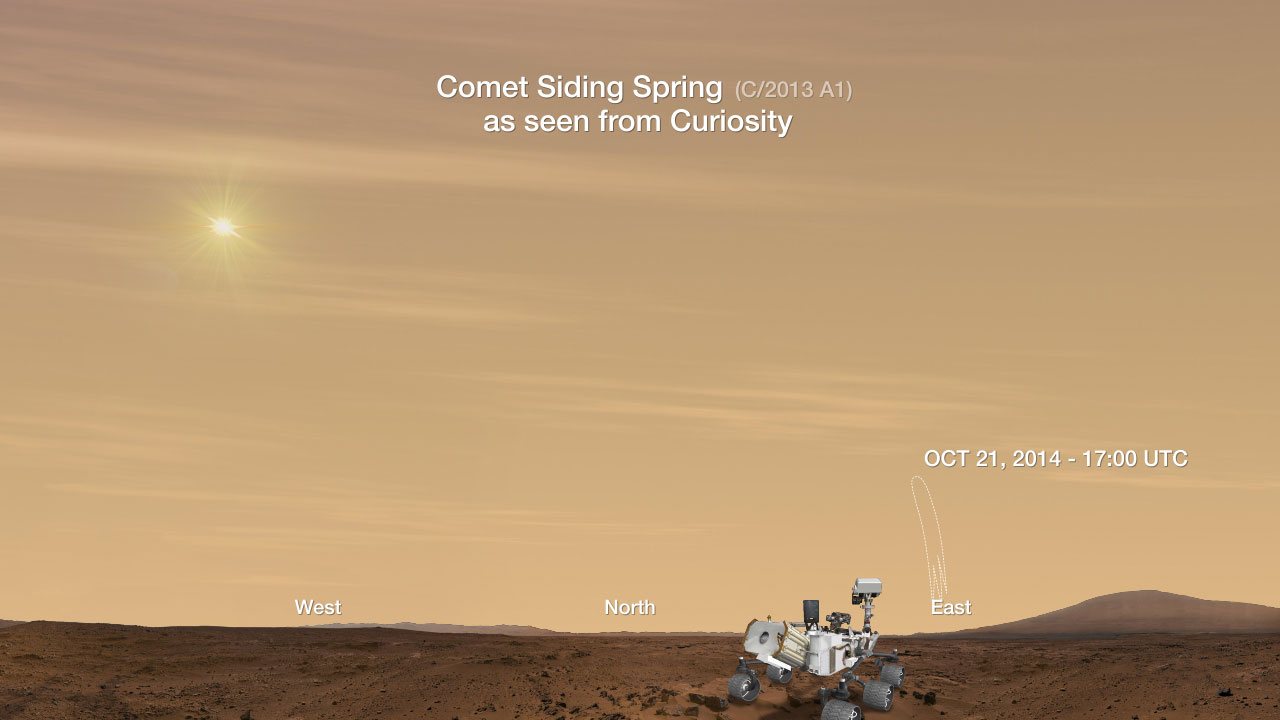
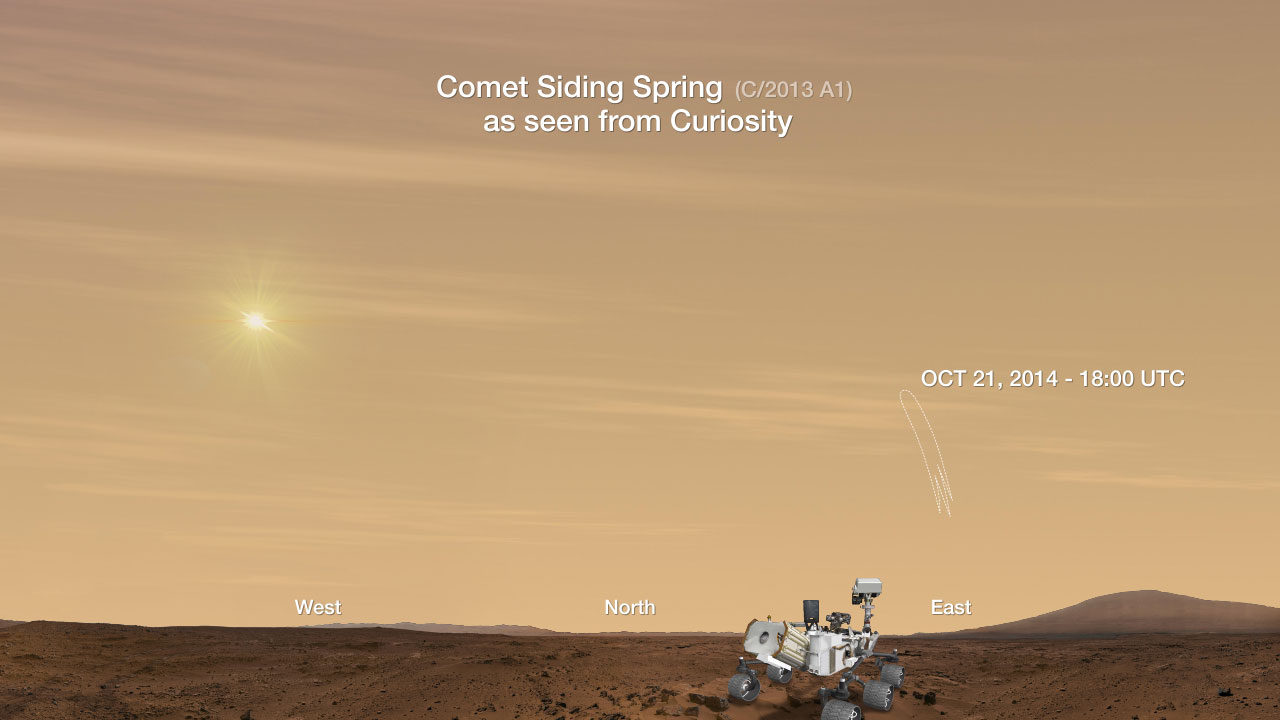
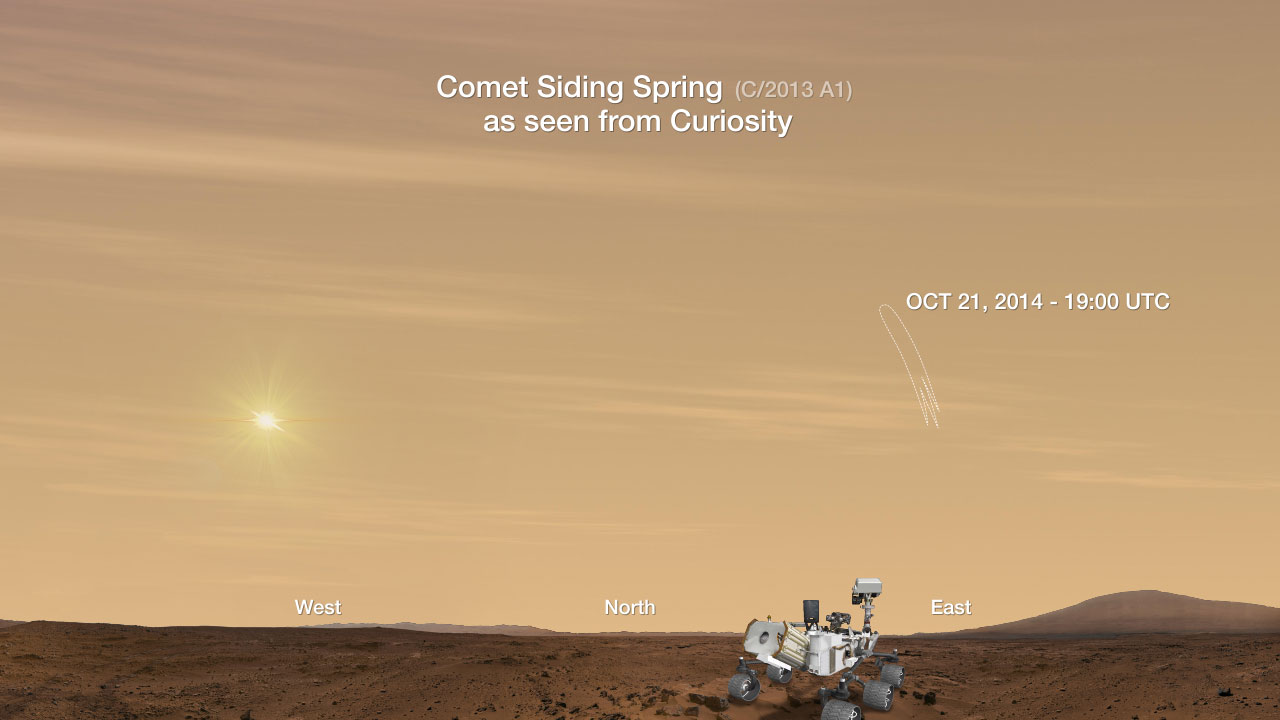

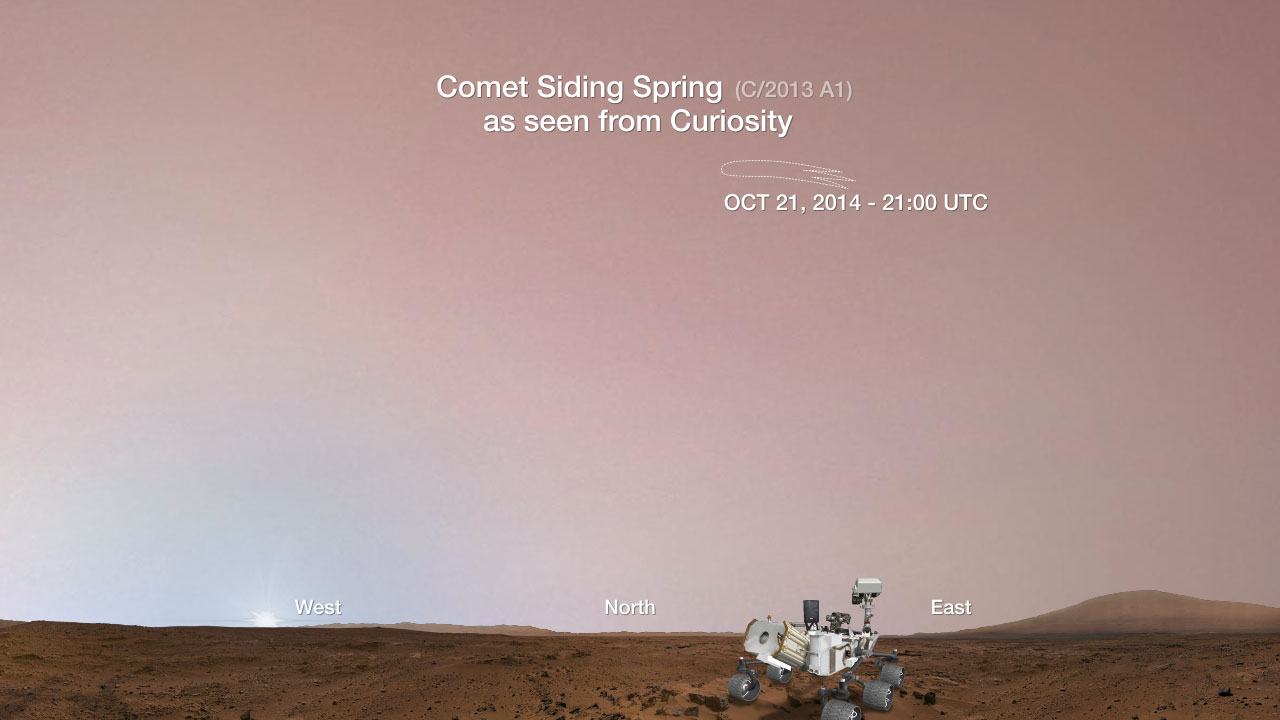
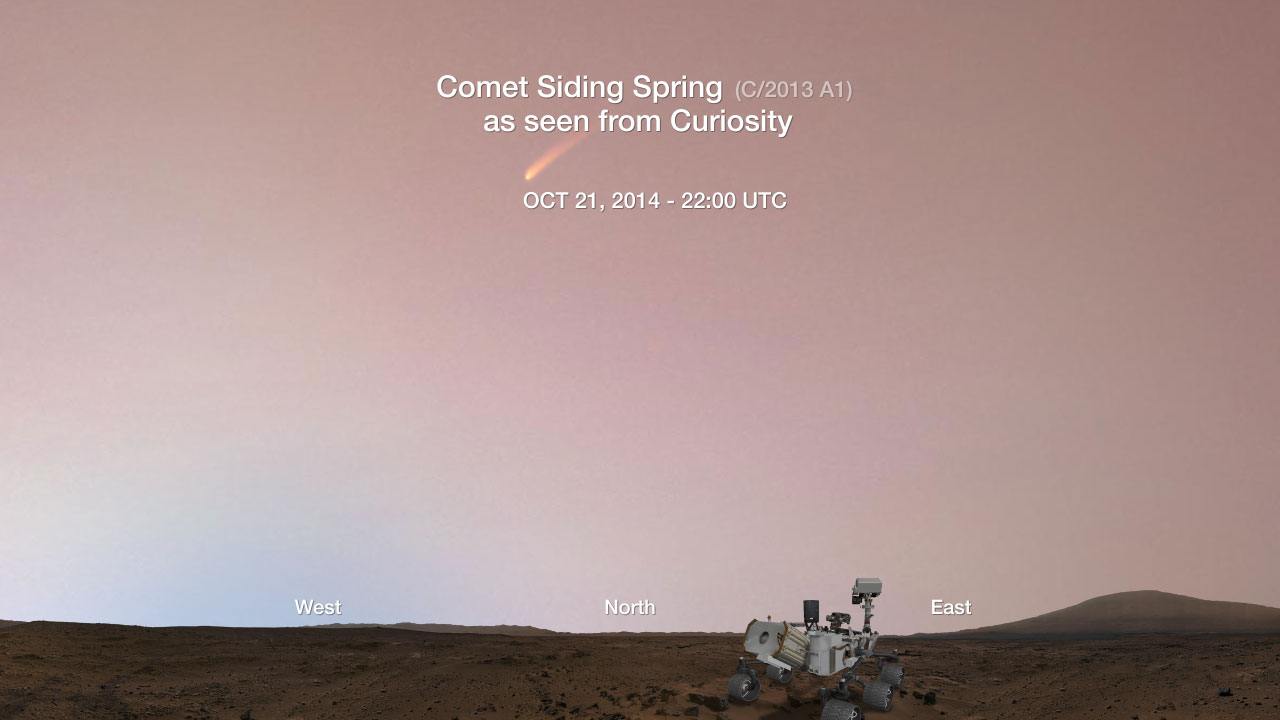
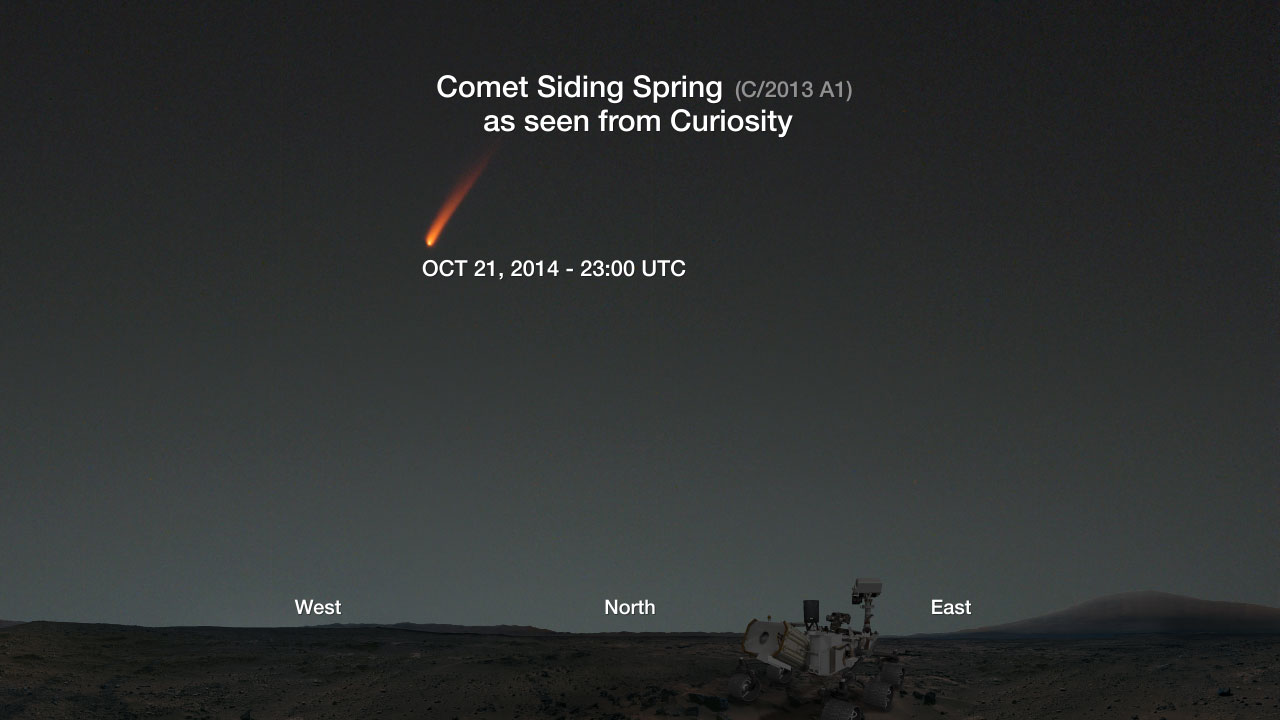

Several weeks prior to closest approach
Mars Reconnaissance Orbiter (MRO) orbit maneuver to put spacecraft behind Mars (1st of 2)
Odyssey orbit maneuver to put spacecraft behind Mars
Mars Reconnaissance Orbiter (MRO) CRISM/HiRISE stellar scan to check boresite
1st Comet Siding Spring workshop.
Watch Archived Workshop >>.
2nd Comet Siding Spring workshop.
Presentations
MAVEN Orbit Insertion.(September 21, 10pm EDT)
Opportunity will take a test PanCam image of twilight sky
India's Mars Orbit Mission (MOM) Orbit Insertion
Mars Reconnaissance Orbiter (MRO) orbit maneuver to put spacecraft behind Mars (2nd of 2)
Mars Reconnaissance Orbiter (MRO) HIRISE imaging of comet.
Curiosity will take a test Mastcam image of the twilight sky
10 days to closest approach
MAVEN last course correction to put spacecraft behind Mars at time of peak flux.
Curiosity and Opportunity may image comet at night.
Curiosity will take test spectral images with Mastcam and Chemcam
Opportunity will do a dry run of comet imaging, aimed at the comet (although the comet may not be bright enough to detect against the dusty night sky).
5 days to closest approach
MAVEN will image the comet with the IUVS.
Mars Reconnaissance Orbiter (MRO) (HiRISE, CRISM, CTX) will image the comet.
MAVEN will monitor the Mars upper atmosphere and solar wind (IUVS, SEP, SWIA, SWEA, STATIC, MAG, LPW, NGIMS).
Curiosity may image comet at night using the ChemCam, Mastcam.
2 hours before closest approach
Opportunity may image the comet with PanCam.
Mars Reconnaissance Orbiter (MRO) imaging of the comet (CRISM, HiRISE, CTX).
Mars Reconnaissance Orbiter (MRO) (MCS, MARCI, SHARAD) will monitor Mars' atmosphere.
Odyssey (THEMIS) imaging of the comet. Thermal IR and visible imaging of the coma.
MAVEN goes into planned "minimum risk" mode ~45 min prior to Closest Approach. LPW, SEP, MAG continue to operate.
During closest approach
PT/2:27 p.m. ET/18:27 UT
Comet Siding Spring (C/2013 A1) Closest Approach to Mars at 87,000 miles (139,500 kilometers).
Mars Reconnaissance Orbiter (MRO) imaging of the comet (CRISM, HiRISE, CTX). Comet nucleus may be a few pixels wide in the image
After closest approach
Mars will skirt the comet coma.
Odyssey will take several thermal IR and visible images of the comet and tail
Mars Reconnaissance Orbiter (MRO) (CRISM and HiRISE) to image the nucleus and CTX rides-along. Other instruments (MCS, MARCI, SHARAD) take observations of Mars' atmosphere to identify atmospheric interactions with comet particles.
Curiosity may image comet at night using the ChemCam, Mastcam.
MAVEN will leave "minimum risk" mode. Spacecraft and instrument status will be checked over the next orbit, then science observations of Mars will resume, to get "after the comet" observations.
Mars Reconnaisance Orbiter (MRO) (HiRISE, CRISM, CTX) will image the comet.
Opportunity may image the comet using the PanCam.
Opportunity and Curiosity may image the comet after closest approach.
Spacecraft will begin to report back to Earth their health and safety status (this schedule is still uncertain on which spacecraft will call home first).
Mars Reconnaisance Orbiter (MRO) (MCS, MARCI, SHARAD) monitors the Mars' atmosphere.
MAVEN will resume atmospheric science (IUVS, SEP, SWIA, SWEA, STATIC, MAG, LPW, NGIMS)
Odyssey (THEMIS) images the comet with planet limb.
Discovery

Luckily, asteroid and comet hunter Robert H. McNaught spotted it with the constellation Lepus in the star background.
At the time of its discovery, Comet Siding Spring
was farther from the Sun than Jupiter -
about 7.2 times farther away from the Sun than Earth.
McNaught achieved this triumph on January 3, 2013, using the 0.5-meter (20-inch) Uppsala Schmidt Telescope, at Siding Spring Observatory in New South Wales, Australia.
Comet Siding Spring's dust tail will completely engulf the entire planet when Mars travels through it. Hubble images show Comet Siding Spring has passed the snow and water lines, the points at which the Sun's warmth activates or releases gases and water ice to form the coma and tail.
Gas and dust in the comet's nucleus and coma often separate into two parts of the comet's tail. A comet's dust tail is the trail of dust and gas illuminated by the Sun. It is blown away from the comet's coma by the solar wind, and follows the curve of the comet's orbit.
When comets are traveling through the outer solar system, they are frozen and do not have tails. Far away and extremely small, they are almost impossible to detect. As they approach the Sun in the inner solar system, radiation from the Sun turns some comet materials like water ice into a gas. As gases leave the nucleus, they carry comet dust with them.
When sunlight illuminates the coma and tail as the comet approaches the Sun, astronomers have a better chance of detecting it.
Though early estimates suggested the size of comet Siding Spring's nucleus could be anywhere from 0.62 to 31 miles (1 to 50 kilometers) across, new data from NASA's Swift Satellite indicates that the icy nucleus of comet Siding Spring is only about 2,300 feet (700 meters) across. Hubble images of Comet Siding Spring show two jets coming from the icy nucleus in opposite directions. Measuring them can help us understand how the comet is rotating and what it might look like when it flies by Mars.
The nucleus is the solid, frozen core of a comet. It is made of rock, dust, water ice, and frozen gases (e.g., carbon dioxide, carbon monoxide, methane, and ammonia).
The nucleus of a comet is usually small in size, usually about a few miles across.
The surface of a comet's nucleus is often dry, dusty, rocky, and dark. Dark materials may contain organic compounds, the chemical building blocks of life. When a comet absorbs heat from the Sun, the nucleus releases water ice and frozen gases.
Sometimes, dazzling jets of gas can erupt from inside the nucleus when the Sun heats some parts of its surface more than others. That can cause the nucleus to spin or even break up into smaller pieces. Such events can change a comet's trajectory and, ultimately, its fate.
Comet Siding Spring has crossed the snow and water lines, key points when it is close enough for the Sun's warmth to activate it. Now that scientists can see the coma, they estimate it is roughly 12,000 miles (19,000 kilometers) across.
A comet's coma is the atmosphere of gas and dust around the nucleus of the comet. It can be hundreds of thousands of kilometers wide.
The coma of a comet is made largely of water and dust. When a comet approaches the Sun, it warms up. Heat from the Sun changes the comet's icy materials to gases. The comet releases these gases, forming the coma.
Radiation from the Sun and the solar wind then push a lot of this material away from the nucleus, forming the comet's tail.
When a comet is about the same distance from the Sun as Mars (about 1.5 AU), its coma can shrink, even though it is producing more gas as it warms. That's because the solar wind becomes forceful enough to push more coma material into the tail, making the tail a lot bigger.
That can be a big deal for planets like Mars, which is crossing through the debris field of Comet Siding Spring's coma and tail.
Scientists will study Comet Siding Spring's ion tail to assess any effect ion-tail particles might have on Mars and Mars missions.
Comets usually have two tails-a dust and an ion tail.
The ion tail is made of ionized gas. (You've heard of solid, liquid, and gas, but there's a fourth state: ionized gas, or plasma. Think of plasma screens, fluorescent and neon lights, and even the Northern Lights). Gas becomes ionized when electrons are charged enough to escape atoms or molecules. That always causes a glow of some kind.
Gas in a comet becomes ionized when ultraviolet radiation from the Sun interacts with the comet's gases. A comet's ion tail is usually blue in color due to the gas molecules that make it up. Ionized gas gets blown away from the coma by the solar wind. A comet's ion tail always points away from the Sun.

